Fix pipeline pains. Solve GTM puzzles. And read strategic brain dump.

SEO vs Paid Search: A Marketer’s Marketing Dilemma Answered
As an SEO professional, here is a situation that lives in my head rent-free.
You open your dashboard.
Paid search is driving leads (nice, very nice).
SEO traffic is… slowly inching up (less nice).
Then someone asks that question. You know that one. “So… should we invest more in SEO or paid search?”
Everyone turns to you. You nod thoughtfully, as if this question is not going to haunt you during quarterly planning.
And this is where most conversations go sideways. Because here’s the truth: SEO vs paid search is not a fair fight. They’re not trying to do the same job. They just happen to live on the same Google results page.
Let’s untangle this properly and see how it actually works.
TL;DR
- SEO and paid search are not competitors. They solve different problems, on different timelines, even though they show up on the same search results page.
- Paid search delivers speed and clarity. It captures existing demand, works immediately, and is easy to measure, but only while you keep spending.
- SEO builds long-term leverage. It takes time, influences buyers early, compounds over time, and often looks weaker in last-click reports despite real impact.
- The best teams sequence both. Use paid search to move fast and learn what converts, then use SEO to turn those insights into sustainable growth.
What is Search Engine Optimization (SEO) (aka the channel that refuses to be rushed)
Search engine optimization, or the acronym SEO, is how you earn visibility on Google without paying for every click. You do this by:
- Creating content people actually search for (not just what you want to say)
- Making sure your site is technically sound (no duct tapes or broken links)
- Building authority over time, so Google goes, “Okay, fine, these folks know their stuff.”
Here’s the important part people forget: SEO takes time to start, but once it works, it keeps working.
You don’t see results immediately. In the beginning, it feels quiet. Sometimes too quiet.
But over time:
- Pages start ranking
- Traffic comes in regularly
- Then suddenly, you’re getting leads from a blog you wrote months ago and forgot about.
You’re not “turning SEO on.” You’re building something that continues to drive traffic over time.
Slow start but long payoff, that’s SEO.
Paid search: The overachiever who gets results now
Paid search has a very different energy. You:
- Pick keywords
- Set a budget
- Start getting clicks almost immediately
No waiting. No suspense. No “let’s see what happens in three months.”
It’s fast. It’s measurable. And yes, it can get a little addictive.
Paid search is what you reach for when:
- You need results this month
- Leadership wants numbers, fast
- You’re launching something new and can’t wait for SEO to warm up
But here’s the simple truth people often ignore: Paid search only works while you’re paying. Pause the budget, and the traffic pauses with it.
That doesn’t make it bad. It just means it’s built for speed, not permanence.
How SEO actually works
SEO isn’t magic. It’s three things working together:
- Content – Are you answering real questions people search for?
- Technical health – Can Google even understand your site?
- Authority – Do other sites trust you enough to link to you?
And one thing people always forget: SEO runs on Google’s timeline, not yours.
When you publish a page, Google doesn’t instantly reward you with traffic. First, it does a little homework. It:
- Finds your page
- Tries to understand what it’s about
- Decides where it might fit among millions of other pages
Now, at this stage, Google is basically asking, “Is this page useful, and who is it useful for?”
If the answer isn’t clear yet, nothing dramatic happens. Your page just… sits there. (Very humbling, I know.) Which is why:
- New pages don’t rank instantly
- Results feel invisible at first
- Patience becomes a strategy (unfortunately)
Over time, Google watches what users do:
- Do people click your results?
- Do they stay or bounce?
- Do other sites reference or link to it?
Each of these is a small signal. One signal doesn’t move the needle. Many signals, consistently, do.
As that confidence builds, your page starts showing up more often, in more places, for more searches. Not because you asked nicely. But because the data says you deserve it.
Slow, yes.
Predictable, also yes.
And once you understand that, SEO stops feeling mysterious and starts feeling manageable.
How paid search (PPC) actually works (also not magic)
Paid search looks simple at first.
Pick keywords. Add budget. Get clicks.
Easy… until you zoom in.
Behind every single click, Google is quietly evaluating a few things:
- Your bid – How much you’re willing to pay
- Your relevance – How closely your ad matches what someone searched
- Your quality score – How useful Google thinks your ad and landing page are
- Your signals – What Google learns from who converts and who doesn’t
Here’s where things get interesting:
- If your targeting is off, you don’t just get bad clicks. You pay more for them.
- If your conversions are weak, Google learns the wrong lesson.
- If your tracking is messy, Google guesses. And guessing gets expensive.
We know that paid search moves fast, but it has very little patience. It rewards teams who are clear about:
- Who they want
- What action matters
- What a “good” conversion actually looks like
And it quietly punishes everyone else. But once you understand how it thinks, it becomes very predictable.
Fast, yes. Easy? Only if you’ve done the homework.
Let’s talk money (the slightly awkward part)
This is usually where everyone clears their throat and says, “Well… it depends.”
With SEO, you usually pay for:
- Content
- Tools
- People
- Time
You spend upfront, then wait for results. That’s why SEO can feel expensive early on. You’re investing before you see much return.
With paid search, you pay for:
- Every click
- Every test
- Every campaign you run
Traffic starts quickly, but the moment you stop spending, results stop too.
So the difference isn’t really about cheap vs expensive. It’s about when you pay:
- SEO costs more at the start and pays off over time
- Paid search costs less upfront but adds up continuously
Basically, one expects patience and the other expects a credit card. Neither one is actually cheaper. They just hurt (and work) in very different ways.
Once you look at it that way, the tradeoff becomes much easier to explain.
Where SEO and paid search fit in the funnel (aka who does what)
Think of the funnel like buyer’s mood swings.
Paid search works best when buyers already know what they want. They’re typing things like:
- Best X software
- X pricing
- X alternatives
They’ve done the thinking.
They’re comparing options.
They’re basically saying, “I’m ready. Don’t mess this up.”
That’s paid search territory.
SEO shows up much earlier in the story. This is when people are Googling things like:
- How do I solve this problem?
- Is this even the right approach?
- What does everyone else do?
Questions are vague. Intent is forming. Nobody is ready to talk to sales yet (and they definitely don’t want a demo).
That’s where SEO belongs.
So, my point is…
Paid search catches people when they’re ready to decide
SEO meets them while they’re still figuring things out
Paid search captures demand. SEO warms it up quietly, long before anyone is ready to buy.
Different moments. Same journey.
Why SEO always looks worse in reports (and isn’t actually worse)
Paid search is very straightforward to explain in a report.
Someone clicks an ad.
They fill a form.
Revenue shows up.
Everyone nods. Charts look clean. Life is good.
SEO is messier.
Someone reads a blog.
They leave.
They come back a week later.
Then maybe they check pricing.
They later fill a form by clicking on your ad.
Then they talk to sales.
Then they convert.
Then no one remembers how they first found you.
So when you look at last-click attribution reports, SEO looks… underwhelming (and feels like you’re right in the middle of the Bermuda Triangle).
Not because it didn’t help. But because it showed up early, did its job quietly, and didn’t stick around to take credit.
SEO doesn’t close the deal in one move. It warms people up, gives them context, and nudges them forward long before conversion happens.
Which is great for buyers. And mildly frustrating for dashboards.
Classic SEO behavior.
SEO vs Paid Search: Mistakes almost everyone makes
If you have done at least one of these, you are completely normal.
- Expecting SEO to behave like ads
- Giving up on SEO because nothing happened immediately
- Throwing more budget at paid search without fixing targeting
- Treating SEO and paid search like rival teams instead of coworkers
None of these comes from a bad strategy.
They usually come from pressure. Deadlines. And someone asking, “Why is this not working yet?”
So decisions get rushed. Shortcuts get tempting. Context gets ignored.
At this point, know that this is not incompetence (it’s stress).
And once you see that clearly, these mistakes become easier to avoid next time.
What the community actually thinks (and why it matters)
Spend a few minutes reading Reddit threads on SEO vs paid search, and a pattern shows up pretty quickly. People say things like:
- “Paid search works… until it suddenly gets very expensive.”
- “SEO was painfully slow, but it saved us later.”
- “Turning SEO off was a mistake.”
- “Ads are great, as long as you know exactly what you are doing.”
Reddit is not polished. There are no frameworks, slides, or jargon. But it is honest. And here is the part worth paying attention to. Most people are not arguing about which channel is better. They are talking about what happens when teams over-rely on one and ignore the other.
The takeaway is simple:
- Teams that rely only on paid search feel exposed (and broke) when budgets tighten
- Teams that ignore paid search struggle to move fast when it matters
- Teams regret not doing SEO in the early stages of growth.
In other words, the community has already learned the lesson the hard way.
Balance wins. Short-term speed plus long-term stability beats picking sides.
So… SEO vs Paid search: Which one should you choose?
Here’s the answer most people don’t love, because it is not flashy.
You do not choose.
You sequence.
- Use paid search when you need to move fast. It helps you test, learn, and capture demand that already exists.
- Use SEO to build something that keeps working over time, even when budgets or priorities shift.
Let both channels talk to each other. Let paid search show you what converts. Let SEO turn those learnings into long-term traffic and demand.
The best teams do not debate SEO versus paid search. They design a system where each channel does what it is actually good at.
Final thought before your next planning meeting
SEO builds leverage, and paid search buys speed.
One helps you survive the quarter. The other stops you from starting from scratch every quarter.
If this question keeps coming up in your team, that’s a good sign.
It means you’re not just trying to win this month. You’re trying to still be winning a year from now.
And that is when both channels start to make a lot more sense (in their own way).
FAQs on SEO vs Paid Search
Q1. Is SEO better than paid search in the long run?
SEO wins long-term, but only if you are willing to wait. On Reddit, you will often see comments like “SEO saved us once ads got too expensive.” The catch is that SEO takes time to build. If you need results immediately, paid search usually performs better early on.
The practical answer is not either or. Use paid search for speed and SEO for durability.
Q2. Can I rely only on paid search and skip SEO completely?
You can. Many teams do. They just rarely enjoy it forever.
Communities like Reddit are full of stories where teams relied heavily on ads, then struggled when costs increased or budgets tightened. Paid search works, but it keeps charging you rent. SEO gives you a fallback. Without it, you are fully dependent on ongoing spend.
Q3. Why does SEO feel slow compared to paid search?
Because Google does not trust new pages instantly. Paid search shows results as soon as you launch a campaign. SEO needs time to understand your content, test it against competitors, and see how users respond. It is also normal.
Q4. Should startups focus on SEO or paid search first?
Start with paid search if you need quick feedback and leads. Start SEO as early as possible, even if it is small. Paid search helps you learn what converts. SEO helps you avoid rebuilding demand from scratch later.
Teams that delay SEO often say they wish they had started sooner.
Q5. Why does SEO look weak in attribution reports?
SEO often influences buyers early. People read a blog, leave, come back later, then convert through another channel. In last click reports, SEO does not get credit. SEO “works quietly” and gets undervalued because of how attribution is set up, not because it is ineffective.

ABM Content Strategy: How B2B & SaaS Teams Drive Revenue
Does this story sound familiar?
Marketing spends weeks creating ‘‘personalized’ content. They tell sales it’s ready. A few emails go out. Nothing happens.
And the conclusion is:
“ABM content doesn’t scale.”
That’s not true. The content wasn’t wrong. The timing, context, and ownership were.
A functional ABM content strategy is more about operational discipline than creative brilliance. You need to know who the content is for, why it exists, when it should be used, and how sales should act on it.
This article breaks down ABM content strategy and what works for B2B SaaS teams IRL.
TL;DR:
- ABM content strategy is not about creating more content. It’s about delivering the right content to the right accounts based on intent, buying stage, and sales context.
- Inbound content attracts demand. ABM content reorients it by supporting live deals, real objections, and buying-group decisions.
- Effective ABM content is activated by account behavior, not publishing calendars. It is measured by pipeline movement, not engagement metrics.
- SaaS teams excel at ABM when they use product signals (feature interest, docs usage, trials, demos) to deploy business-relevant content.
- Platforms like Factors.ai make ABM executable by mapping content engagement to account intent, sales actions, and revenue impact.
What Is ABM Content Strategy (Practically Speaking)?
Technically, ABM content strategy refers to the planning, creation, activation, and measurement of content designed to influence specific target accounts and their buying decisions. Unlike search engine optimization, ABM is heavily driven by account intelligence signals, buying stage, and sales context.
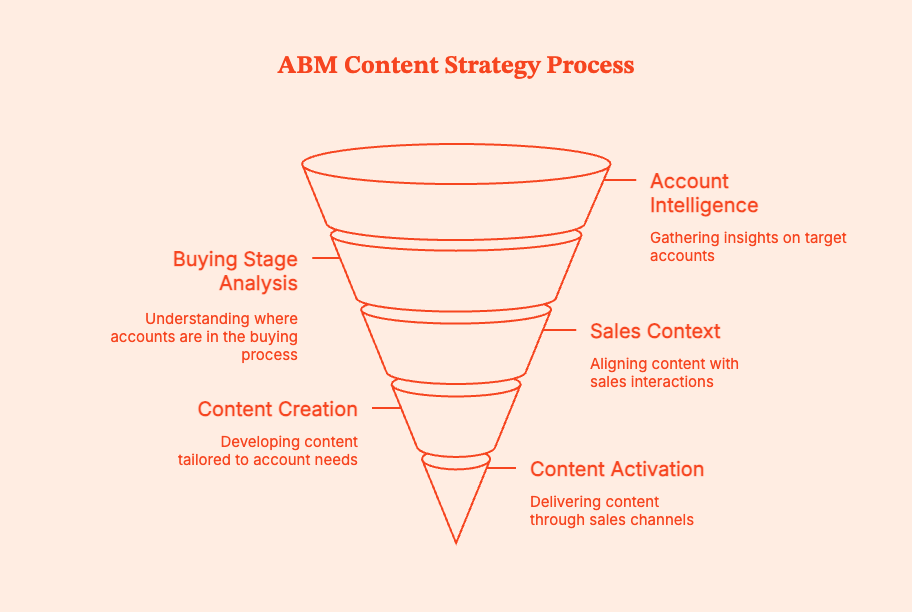
In practice, it means answering three uncomfortable questions:
- Which accounts are we trying to move this quarter?
- What decision are they currently stuck on?
- Who inside that account needs proof, reassurance, or leverage?
ABM content strategy plans, creates, and leverages content around those answers.
Within an inbound marketing content strategy, you publish and wait.
ABM content is:
- Triggered by account behavior
- Used directly in sales motion
- Measured in its impact by deal movement
Pro-Tip: If any content piece does not support a step in the sales funnel, it’s probably not ABM content.
ABM Content vs Inbound Marketing Content Strategy
Inbound content is the raw material. ABM content reframes existing assets around real account-related questions that arise at that moment.
The Operating Principles Behind ABM Content That Actually Works
ABM content often fails because teams skip the basics under pressure.
But these principles are essential and evidence-based on patterns that show up repeatedly when ABM programs either start influencing pipelines or just stall.
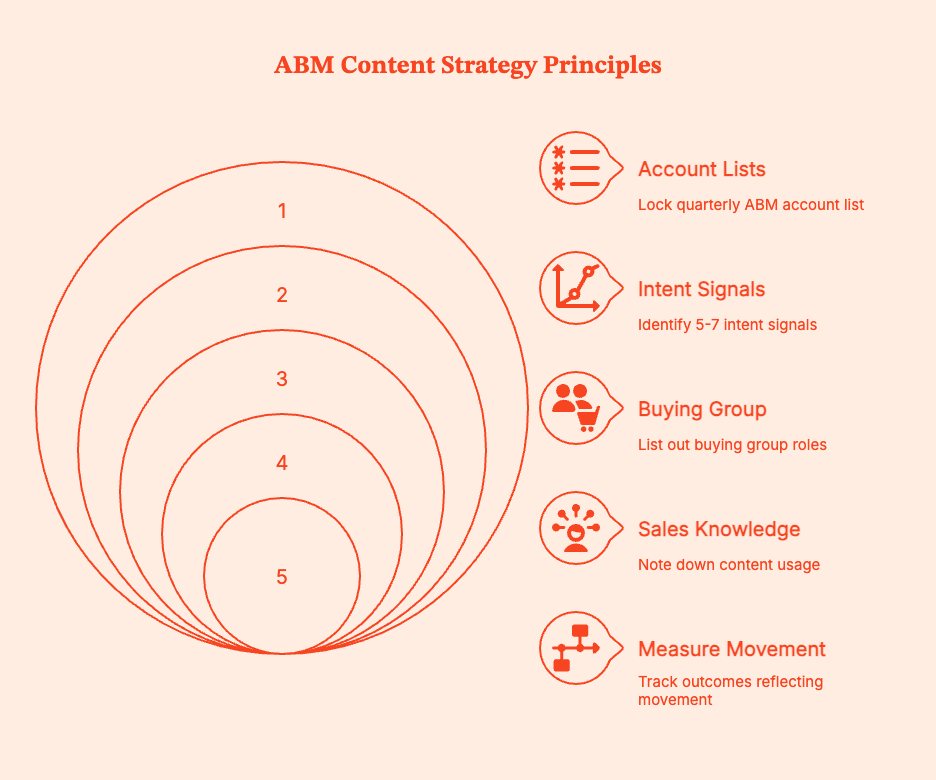
1. Account lists always come before content ideas
Don't ask “What content should we create?” before “Which accounts matter right now?” If you do, you end up with:
- Content that feels generic, truly relevant to no one
- Sales saying, “This does not work for my accounts.”
Instead, do this:
- Lock a quarterly ABM account list with sales
- Group accounts by shared decision blockers like budget approval, security review, and internal consensus. Don't just judge by industry or size.
- Then ask: What proof or clarity is missing for these accounts to move?
2. Intent, not calendars, determines timing
If you serve the right ABM content at the wrong moment, you find that even great content “didn’t work.”
Accounts move in bursts, pauses, and regressions. Your content marketing efforts have to match this momentum. Be timely, not persistent.
Instead, do this:
- Identify 5–7 intent signals indicating real movement: pricing/demo page revisits, competitor comparison views, repeat visits from the same account, direct engagement with sales emails, etc.
- Map one clear content action to each signal
- If an account isn’t showing buyer intent, don't bombard them with content. Consider letting the account rest for a while
Question: Are you counting LinkedIn intent data into your ABM brainstorming?
3. Buying-group coverage > persona perfection
You can refine personas all you want, but deals will get stuck even if one person in the B2B account has unanswered questions. ABM content works best if it is catered to core decisions in the sales pipeline, rather than these personas.
Instead, do this:
For each target account, list out:
- The economic buyer (who approves spending)
- The technical evaluator (who manages risk)
- The day-to-day user or champion (who actually uses the product)
Then ask yourself and your team: Which of these roles seem to currently lack proof or confidence in our product?
Now build ABM content to unblock that decision. Address specific concerns instead of throwing generic assets at them.
4. Sales must know when and how to use content
ABM content can't just live in marketing folders. If sales teams don't know when to use an asset, why it exists, and what it’s meant to achieve, it just won’t get used.
Instead, do this:
For every ABM asset, note down:
- When in the sales funnel, it should be used
- The specific objection or risk each content piece talks to
- The follow-up action that the content is meant to enable
If a salesperson can’t explain any asset’s purpose in one sentence, it's not ABM content, just marketing collateral.
5. Measure movement, not performance
ABM content isn't successful when it ‘performs’, but rather when it moves accounts along the buying pipeline.
Instead, do this:
Track outcomes that reflect movement, such as
- Target audience engaged after exposure
- If opportunities were created or accelerated by the content
- If relevant content has helped sales move conversations forward
Vanity engagement metrics do not matter. Only the ones that correlate with pipeline change do.
Types of ABM Content That Hold Up in Real Sales Cycles
Content for account based marketing works best when it is deployed at the exact moment a deal risks stalling.
Since B2B buying dynamics are mostly predictable, mature ABM pipelines tend to use content in a few repeatable categories.
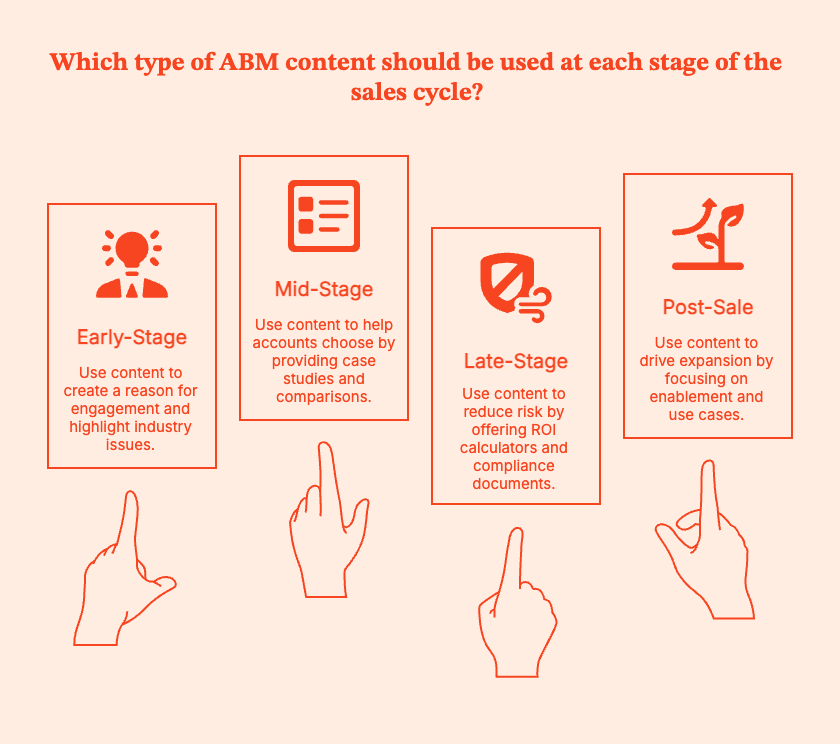
1. Early-Stage: Creating a Reason to Engage
Right now, key accounts are aware of the problem but not yet working on solving it, especially with you. You have to get their attention on said problem.
Try using:
- Industry POV memos talking about issues each account is likely feeling, but hasn’t focused on
- Problem-specific landing pages pointing out operational pain points rather than product features
- Lightly personalized ads speaking to the account’s industry, role, or maturity
Deploy this valuable content when accounts are still researching, or when sales needs a credible reason to start a conversation.
2. Mid-Stage: Helping Accounts Choose, Not Browse
At this stage, multiple stakeholders enter the conversation, internal comparisons begin, and “we need to review options” becomes a frequent reply.
Try using:
- Industry-specific case studies responding to each account’s structure
- Competitive comparison pages that acknowledge tradeoffs
- Webinars or workshops tailored to a narrow segment or buying concern
This content helps you when more than one stakeholder is involved, when deals stall, and when the account is comparing you to competitors.
3. Late-Stage: Reducing Risk, Not Selling Harder
Here, the deal has to be justified. Accounts tend to back off when they perceive some form of risk.
Try using:
- ROI calculators mapped to the account’s scale and cost hierarchy
- Security, legal, and compliance documentation to address specific risk concerns
- Custom decks aligned with the account's internal approval process
These assets are best used when budget, security, or procurement teams are involved as buyer personas.
4. Post-Sale: Expansion
Don't stop thinking about ABM once the deal closes. Instead, work on:
- Creating content around enablement, tied to real usage milestones
- Building expansion use-case playbooks for accounts based on similar growth paths
This content comes into play when sales and marketing teams want ABM to extend beyond acquisition, and when expansion depends on more product adoption and internal advocacy.
The goal of post-sale ABM content is to anticipate the next buying decision before the account explicitly asks for it.
Pro-Tip: The strongest ABM teams don’t create endless new assets but edit ruthlessly.
- Remove generic framing
- Use examples relevant to the account’s reality
- Map each asset to a specific deal moment
Focus on relevance, not novelty.
ABM Content Strategy for SaaS Teams
SaaS buying behavior is quite visible if you know what to look for. You can actually gauge intent way before anyone fills out a form or replies to sales messages.
SaaS teams can operationalize these signals via ABM content. The trick is to stitch together product data, content, and sales insights into ABM assets.
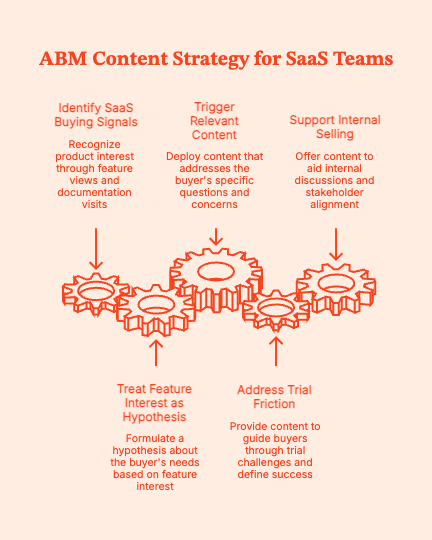
1. SaaS buying is product-informed
Serious SaaS buyers don’t read blog posts to make decisions. They explore feature pages, study product documentation, take free trials, and watch demos multiple times. ABM success comes from responding to signs of product curiosity with business contextual content.
These are the metrics to focus on, rather than engagement, eBook downloads, webinar attendance, and generic site visits.
2. Treat feature interest as a buying hypothesis
If an account repeatedly views a specific feature, they are probably wondering whether it can solve their problem.
Instead of retargeting such accounts with product ads or generic nurture emails, trigger content that explains:
- Why teams like them care about this capability
- What problem it typically solves
- What changes operationally after adoption
3. Pay attention to documentation and help-center visits
Pre-sale documentation page visits are one of the clearest signs of buying intent in SaaS. Such accounts are usually:
- Validating feasibility
- Pressure-testing the product
- Raising and debating internal questions
When you detect such account behavior:
- Flag repeated or deep documentation usage
- Trigger ABM content that anticipates implementation concerns, explains time-to-value, and shows how similar teams have onboarded successfully
4. Trial friction is an ABM content opportunity
When an account stalls inside a trial, don't jump right to blaming onboarding or UX.
It could be that:
- The buyer doesn’t know what “success” should look like
- The wrong stakeholder is judging the product
- The use case isn’t clearly mapped to ROI
Use ABM content to smooth the journey with:
- Role-specific “what success looks like” guides
- Use-case playbooks relevant to the account’s industry or size
- Short internal decision aids
5. Repeated demo views = internal selling (probably)
If an account watches demos multiple times over several days, that's usually a sign of internal sharing. Most probably, someone on the account side is discussing the product internally and trying to get other stakeholders on board.
Deploy high-impact ABM content to help them out. This can include:
- One-page decision summaries
- Stakeholder-specific FAQs (security, finance, ops)
- ROI narratives that can be forwarded without explanation
Note: The biggest ABM content marketing strategy mistake is treating ABM content as gated inbound content (long-form, overproduced assets, no clear instructions for sales use, etc.). ABM needs to be shorter, sharper, and tied to specific moments in the customer journey.
How Factors.ai enables ABM
Most ABM programs stall due to visibility and handoff issues. Marketing creates or curates account-level content, but nobody knows which accounts are engaging, how that engagement helps deals, or when sales should act. Factors.ai fixes those gaps by extracting account signals from raw engagement data.
1. What Factors actually gives you
- Anonymous account identification to match IP and behavioral patterns to companies. Uses firmographics to show who’s visiting even before forms are filled.
- Unified account-level intent to analyze website behavior, intent feeds, ad interactions, and trial/demo signals. Combines this data into a single account engagement profile.
This might help: A Guide to Intent Data Platforms: Features, Benefits & Best Tools
- AI scoring & Milestones that score accounts by fit + intent, detect milestones (e.g., pricing page + repeated docs views), and point out accounts that look ready for conversation.
- Activation & orchestration to notify sales, trigger outbound sequences, and refresh ad audiences automatically (AdPilot/activation features).
- Account-first attribution that connects content and engagement to pipeline and revenue.
In other words, with Factors.ai in your ABM toolkit:
- You stop guessing which content gave a win. You know which account visited which pages, saw which ads, and led to what opportunity.
- You act at the right moment. Factors will trigger content or sales actions (like reaching out, sending a specific deck) when an account shows signals of buying interest.
- You make sales-shareable content for the buyer. When you know which stakeholder is interacting, you can push the right asset that tips the scales in your favor.
2. How to wire Factors.ai into your ABM content operating model
3. Measuring ABM Content Success
Common ABM Content Strategy Mistakes
Most ABM content failures don’t blow up campaigns or trigger emergency meetings. They drain time, budget, and credibility until teams either mistakenly conclude that “ABM doesn’t work”. Or, they accurately realize that ABM exposes weak operating models.
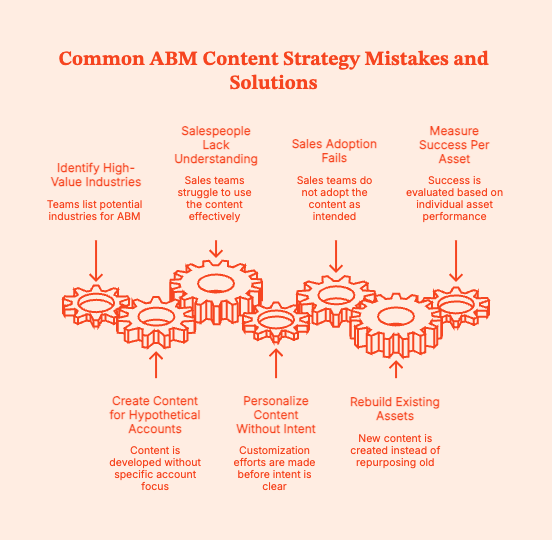
1. Creating content before account prioritization
Often, ABM starts with a quarterly planning meeting, a list of “high-value” industries, and content ideas. The high-value accounts are forgotten, which means:
- Content is designed for hypothetical accounts
- Salespeople don't understand how to use it
Instead, try this:
- Set up a time-bound ABM account list (30–90 days)
- Tie every asset to specific accounts
- If you can’t name the deal a content piece aims to influence, toss it
2. Over-personalizing before intent is clear
In ABM, personalization is not equivalent to effectiveness. Don't spend time creating heavily customized content for accounts that haven’t yet shown buying signals. You just end up with:
- High effort, low response
- Teams burning out trying to scale 1:1 assets
- Leadership questioning ROI
Instead, try this:
- Only personalize content for accounts showing intent
- Start with light contextualization according to industry, role, and problem
- Only offer deep customization to accounts showing high-confidence signals
3. Expecting sales adoption without enablement
Don't just create “ABM-ready” content and wait. Often, sales does not know how to use it. The content also might not map clearly to account objections.
Instead, treat every ABM asset like a sales tool. Define the moment in the sales funnel when it should be used, the specific objection it addresses, and the next step it enables.
Review ABM assets in sales meetings, not just marketing syncs.
4. Rebuilding assets that already exist
Marketing teams assume ABM requires entirely new content libraries, which eats up duplicate effort, pushes longer timelines, and results in inconsistent messaging.
Instead, try this:
- Audit existing content ruthlessly
- Strip away generic pointers
- Rebuild assets around specific account problems, clear account questions, and internal objections
5. Measuring success per asset instead of per account
Often, teams running ABM look at engagement without noticing how the content impacts deals. Content optimization happens in a vacuum, and eventually sales loses trust in marketing data.
Instead, measure this:
- Accounts engaged
- Stakeholders reached
- Deals influenced or accelerated
- Kill or refine assets that don’t move accounts forward
Delete or refine assets that do not move any accounts to
the final purchase. Judge the success of ABM content at the account level, not the asset level.
Summary
ABM content strategy is a structured, account-first approach to planning, activating, and measuring content that influences specific target accounts and buying groups. It does not bother with boosting anonymous traffic. Unlike inbound marketing content strategy, which optimizes for reach and discovery, ABM content strategy optimizes for relevance, timing, and deal progression.
In practice, ABM content works best when teams start with account prioritization, not content ideas. Define which accounts matter in a given window, identify the decisions those accounts are stuck on, and create or repurpose content to unblock those decisions. Content is activated based on account-level intent signals (pricing views, demo replays, documentation usage, or trial behavior) and is used directly in sales interactions.
For SaaS companies, ABM content strategy helps because buying intent is visible early through product behavior. Feature interest, trial friction, repeated demos, and technical validation are signals that directly impact business impact, risk reduction, and internal justification.
ABM content success is evaluated at the account level, using metrics such as buying-group coverage, pipeline influenced, deal velocity, and sales adoption. Vanity metrics such as pageviews or asset-level conversion rates are not important here.
Tools like Factors.ai enable ABM content execution by identifying high-intent accounts (including anonymous visitors), tracking account-level content engagement, activating timely sales actions, and mapping content exposure to pipeline and revenue outcomes.
FAQs for ABM Content Strategy
Q. What is ABM content strategy?
ABM content strategy is a structured approach to planning, delivering, and measuring content for specific target accounts and buying groups. This content is based on account intent, buying stage, and sales context. It aims to move accounts through real deals, not to generate traffic or leads at scale.
Q. How is ABM content strategy different from inbound marketing content strategy?
An inbound marketing content strategy aims to attract unknown buyers through SEO, social, and gated content. ABM content strategy supports known accounts that are already analyzing solutions. It deploys content based on intent signals and aligns directly to sales conversations.
Q. What types of content work best for account-based marketing?
Account based marketing content is best served by content that helps buyers evaluate risk and justify decisions. For example, industry-specific case studies, ROI or cost-impact calculators, competitive comparison pages, security and compliance documentation, and short sales-enablement assets for internal sharing.
Q. Can ABM content strategy scale for SaaS companies?
Yes. ABM content strategy scales for SaaS when teams reuse inbound content and deploy it according to account intent and product signals (such as feature interest, demo replays, or trial behavior).
Q. Do you need to create new content for ABM?
In most cases, no.
Successful ABM teams recontextualize existing inbound and sales content, and anchor it to account-specific context, buying-stage questions, and real objections.
Q. How personalized should ABM content be?
Light personalization (industry, role, problem) works early. Deep, account-specific personalization should be reserved for high-value accounts that show clear buying intent. Increase personalization with intent, not by default.
Q. How do sales teams use ABM content?
Sales teams utilize ABM content to initiate conversations, address objections, facilitate internal decision-making, and expedite deals. If content cannot be used directly in sales outreach or follow-ups, it is not effective ABM content.
Q. What tools are required to execute an ABM content strategy?
Teams need tools for CRM alignment, easy access to sales-ready content, and account-level visibility into engagement and intent. Without account intelligence, ABM content is difficult to scale.
Q. How does Factors.ai support ABM content execution?
Factors.ai supports ABM content execution by identifying high-intent accounts (including anonymous visitors), tracking content engagement at the account level, activating timely sales actions, and connecting content to pipeline and revenue outcomes.
Q. Is ABM content strategy only for enterprise teams?
No. While enterprise teams use ABM, mid-market SaaS teams often see faster results because account lists are shorter, sales cycles are cleaner, and marketing–sales collaboration is easier to achieve.

Sales and Marketing Tools for B2B Teams
The average B2B marketing team uses 8 tools. Sales uses another 8. Add in your CRM, marketing automation, attribution, intent data, sales engagement, and call intelligence, and you've got 16 marketing and sales tools that are supposed to work together.
Here's the problem: most don't. Attribution lives in one place, and deal data in another. No one can say which touchpoints actually moved the pipeline. Marketing and sales aren't misaligned; their systems are.
You want to cut your stack without breaking everything, but don't know how.
And in this blog, we show you exactly that: the categories of tools you need, how they connect, and how to choose what stays and what goes.
TL;DR
- Your ideal 2026 revenue stack should include 4–7 integrated tools, anchored by a CRM like Salesforce, HubSpot, or Zoho, eliminating data silos between marketing and sales.
- For marketing, use up to 3 tools: a marketing automation platform (HubSpot, Marketo, ActiveCampaign), an attribution solution (Dreamdata, Factors.ai, Marketo Measure), and an ABM or intent platform (6sense, Demandbase).
- Sales teams need just 2 tools: a sales intelligence platform (ZoomInfo, Apollo, LinkedIn Sales Navigator) to identify decision-makers, and a sales engagement tool (Klenty, Salesloft, Outreach) to automate outreach and accelerate deal flow.
- AI is already embedded in most leading tools, Factors.ai, Salesforce, Klenty, ZoomInfo, Outreach, but is only valuable when the data is clean, connected, and centralized in your CRM.
- Cut stack bloat through consolidation, not addition, run a tool audit, identify overlapping capabilities, and prioritize platforms that cover multiple use cases without sacrificing usability or adoption.
So what exactly are marketing and sales tools?
Marketing tools like automation platforms, analytics and attribution systems, and ABM tools generate and nurture demand. Sales tools like CRMs, sales intelligence platforms, and sequencing tools convert that demand into revenue.
Simple on paper, but only 11% of companies have effective hand-offs between the two, according to Influ2's 2025 Sales-Marketing Alignment Report. The problem? Most treat these as separate systems with different owners and dashboards.
The fix isn't more tools. It's building one revenue stack connected to your CRM, where both teams see the same accounts, signals, and data.
What is a revenue stack? (and how many tools should be in it)
A revenue stack is the minimum set of sales and marketing tools needed to create pipeline, move deals forward, and prove which efforts impact revenue, with the CRM as the single source of truth.
You can decide whether a tool belongs in your revenue stack by checking if it does at least one of these three core jobs:
- Create pipeline by capturing and qualifying demand
- Move deals forward through sales engagement and execution
- Prove revenue impact through attribution and ABM
In practice, most revenue stacks include 4–7 tools spread across marketing, sales, and CRM.
Here’s how this usually plays out.
On the marketing side, teams typically use up to three tools to handle demand generation, attribution, and intent.
- An automation platform for campaigns and lead scoring
- An attribution tool to track what drives revenue
- An ABM or intent platform to identify high-intent accounts
The CRM sits at the center, bringing marketing and sales data together so pipeline and deals are tracked in one place.
On the sales side, teams usually rely on two tools to convert leads and move deals forward.
- A sales intelligence tool for contact and account data
- A sales engagement platform for outreach and follow-ups
Types of B2B marketing tools
For marketing tools, there are only three jobs that actually matter:
- Generate demand through campaigns: Ads, emails, nurture sequences that create consistent interest
- Measure which efforts drive closed deals: Full-funnel attribution that ties activity to revenue
- Identify high-intent accounts: Surface which prospects are ready to buy right now
And the tools to get these jobs done are:
Marketing automation platforms
Marketing automation platforms capture leads, run nurture campaigns, and score prospects, all while syncing with your CRM.
What to look for:
- Multichannel automation: Email, ads, LinkedIn, SMS in one workflow
- Clean CRM integration: No broken routing or duplicate leads
- Revenue reporting: Ties activity to pipeline, not just MQLs
1. HubSpot Marketing Hub
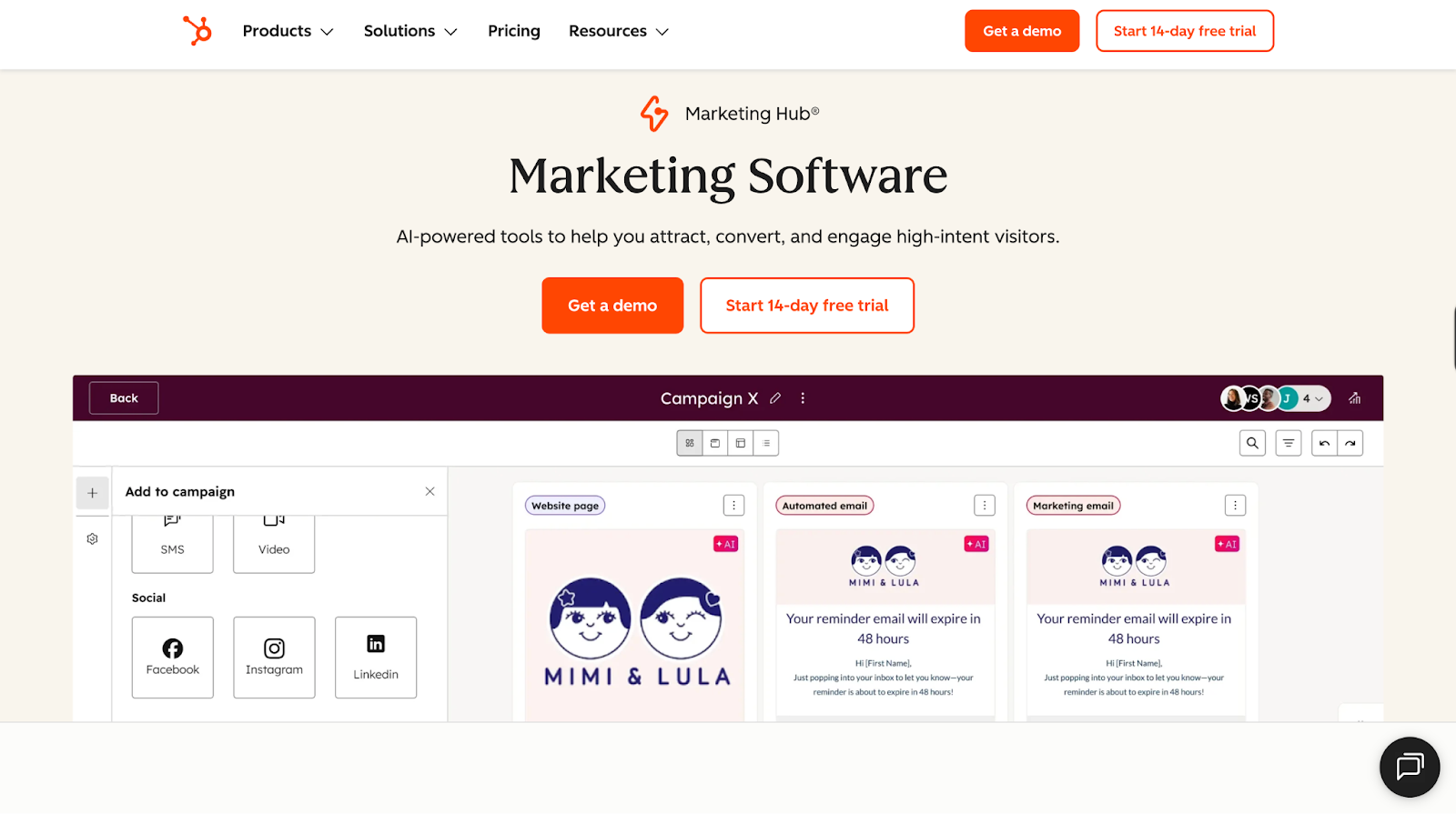
Best for: Small-to-mid-market companies looking for an easy-to-manage automation platform.
Pros:
- Built-in CRM, perfect for HubSpot CRM users
- Intuitive workflows to fast-track campaign launches from months to days
- Low learning curve and fast time-to-value
- Plug-and-play automations, great for companies without a dedicated ops person
Cons:
- Costs rise quickly once you cross 10K contacts ($800+)
- Paywalls for basic features like conditional logic and snippet limits
- Advanced customization, reporting and AI features require add-ons that can reach ~$3,200/month
Bottom Line: Choose this if you value speed and simplicity over deep customization. Budget accordingly because costs climb fast as you grow.
2. Adobe Marketo Engage

Best for: Enterprise teams with dedicated marketing ops that need advanced workflows and logic.
Pros:
- Powerful segmentation to run highly personalized, multi-step campaigns
- Built for complex use cases across regions, teams, and channels
- Predictive personalization that helps improve engagement at scale
- Works seamlessly with Salesforce and broader Adobe ecosystem
Cons:
- Steep learning curve, but very powerful and flexible once you get past it
- Need Marketo specialists to get the most out of the tool
- Clunky and outdated UX
- Overkill for teams under 50
Bottom Line: Only choose this if you have someone in-house who knows Marketo inside and out. Without dedicated resources, you're paying for features you can't use.
3. ActiveCampaign

Best for: Budget-conscious startups and growth-stage teams looking for marketing automation with decent CRM features.
Pros:
- Easy to use visual and AI-powered automation builder
- Best for email marketing with a solid deliverability rate of 94.2%
- Great onboarding and support (not paid like HubSpot)
- Integrates with over 1,000+ tools
Cons:
- Limited CRM and CMS depth
- Doesn't offer account-level reporting or advanced attribution
- No sales features like booking links, scheduling, etc.
Bottom Line: Great starter platform for tight budgets, but plan your migration strategy upfront. You'll likely need to upgrade within 18-24 months.
Marketing Attribution Tools
59.4% of B2B teams use marketing attribution tools to end the sales vs. marketing blame game. How? Marketing attribution maps the full buyer journey to show which channels, campaigns, and touchpoints actually influence closed deals, giving both teams clarity on what works.
What to look for:
- Multi-touch attribution: Credit every touchpoint in the journey, not just first or last click
- Account-level visibility: Track all 6-10 stakeholders in the B2B buying committee, not just one lead record
- Automated integration: Clean data from CRM, ads, web, and marketing automation without manual work
4. Adobe Marketo Measure
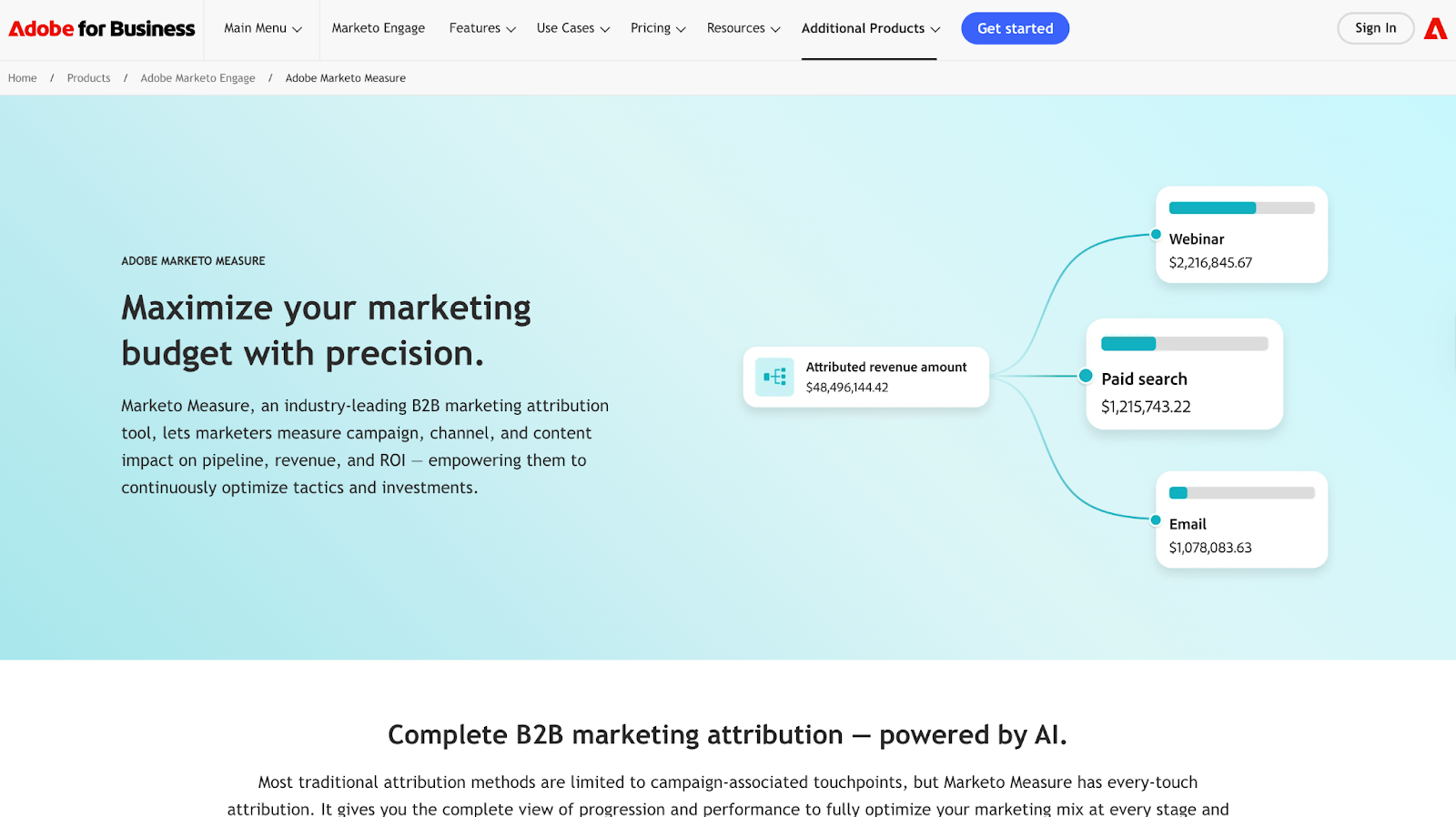
Best for: Enterprise teams already deep in the Marketo/Adobe stack.
Pros:
- Solid multi-touch attribution
- Tracks online + offline touchpoints across the funnel
- Deep Salesforce integration
- Excellent onboarding and customer support
Cons:
- Enterprise-heavy tool with a steep learning curve
- Manual cost entry for ad channels outside Google/Bing/Facebook
- No full-session journey visibility without the Amazon Redshift add-on
Bottom Line: Only worth it if you're committed to the Marketo ecosystem, otherwise you're paying enterprise prices for workflows that still require manual setup.
5. Dreamdata
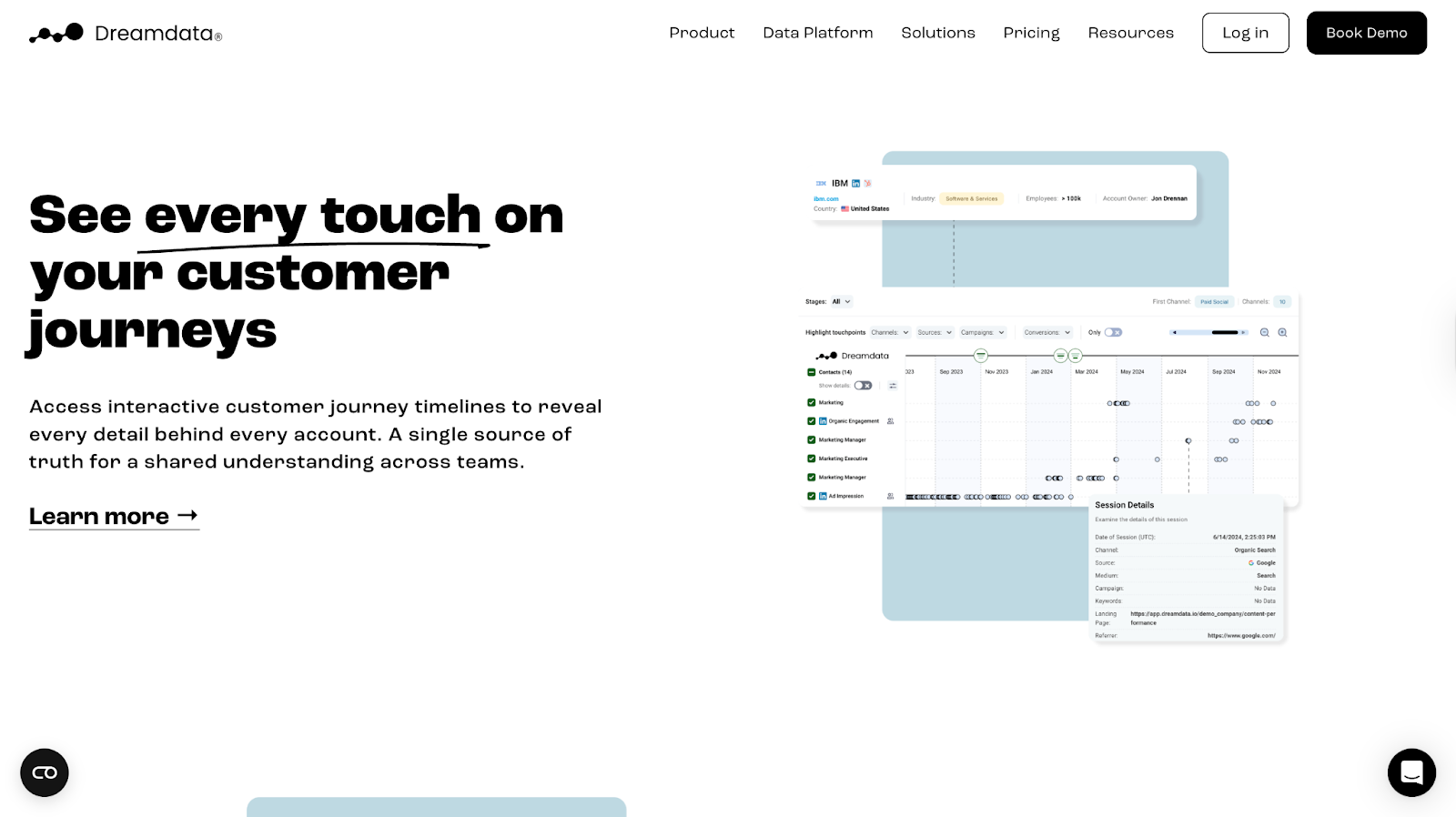
Best for: Mid-market teams that need revenue-linked account journeys without enterprise complexity.
Pros:
- Deep account-level visibility with journey maps and timelines
- Strong multi-source stitching across ads, web, and CRM
- Seamless LinkedIn ad data capture via CAPI integration
- Clean CRM syncing with HubSpot, Pipedrive and Salesforce
Cons:
- 5-10 seat caps per tier, teams outgrow it fast
- Limited reporting flexibility for complex RevOps questions
- UI feels dated compared to newer attribution tools
Bottom Line: Solid mid-market pick for account journey clarity, but you'll feel the limits as the team scales.
💡Also Read: Factors Vs DreamData and Factors Vs Marketo Engage (Bizible)
6. Factors.ai

Best for: High-growth B2B teams needing attribution + account intelligence without enterprise complexity.
Pros:
- Unlimited seats, perfect for high-growth teams
- Endless custom user stage models to segment leads
- Dedicated support on all plans, unlike Dreamdata
- More out-of-the-box integration options compared to Marketo Measure (9 vs 6)
- Onboarding in less than 30 minutes
- Larger IP database than Demandbase (4.6M vs 3.6M)
- LinkedIn AdPilot shows which companies saw ads and returned
- Doesn't deanonymize individual contacts
Cons:
- Doesn't integrate with Microsoft Dynamics 365
- There's a learning curve for custom reporting and advanced setup
- Doesn't deanonymize individual contacts
Bottom Line: Great for teams looking to cut stack bloat. Attribution + account intelligence + ABM in one tool. Expect a light learning curve as you scale into custom reporting.
💡Also Read: How Squadcast used Factors to reduce prospecting time by 25% using Factors.ai's account intelligence
ABM Tools
ABM tools identify which accounts are in-market right now, so sales stops playing eeny-meeny-miny-mo with leads who downloaded a PDF versus those checking pricing three times.
ABM-aligned companies grow revenue by 208% and increase profits 27% over three years.
What to look for:
- Account identification and intent signals: Who's in-market and what they're researching
- Cross-channel orchestration: Run LinkedIn, email, display ads, and direct mail from one place
- Shared account intelligence: Everyone sees the same signals and buying behaviors
7. 6sense
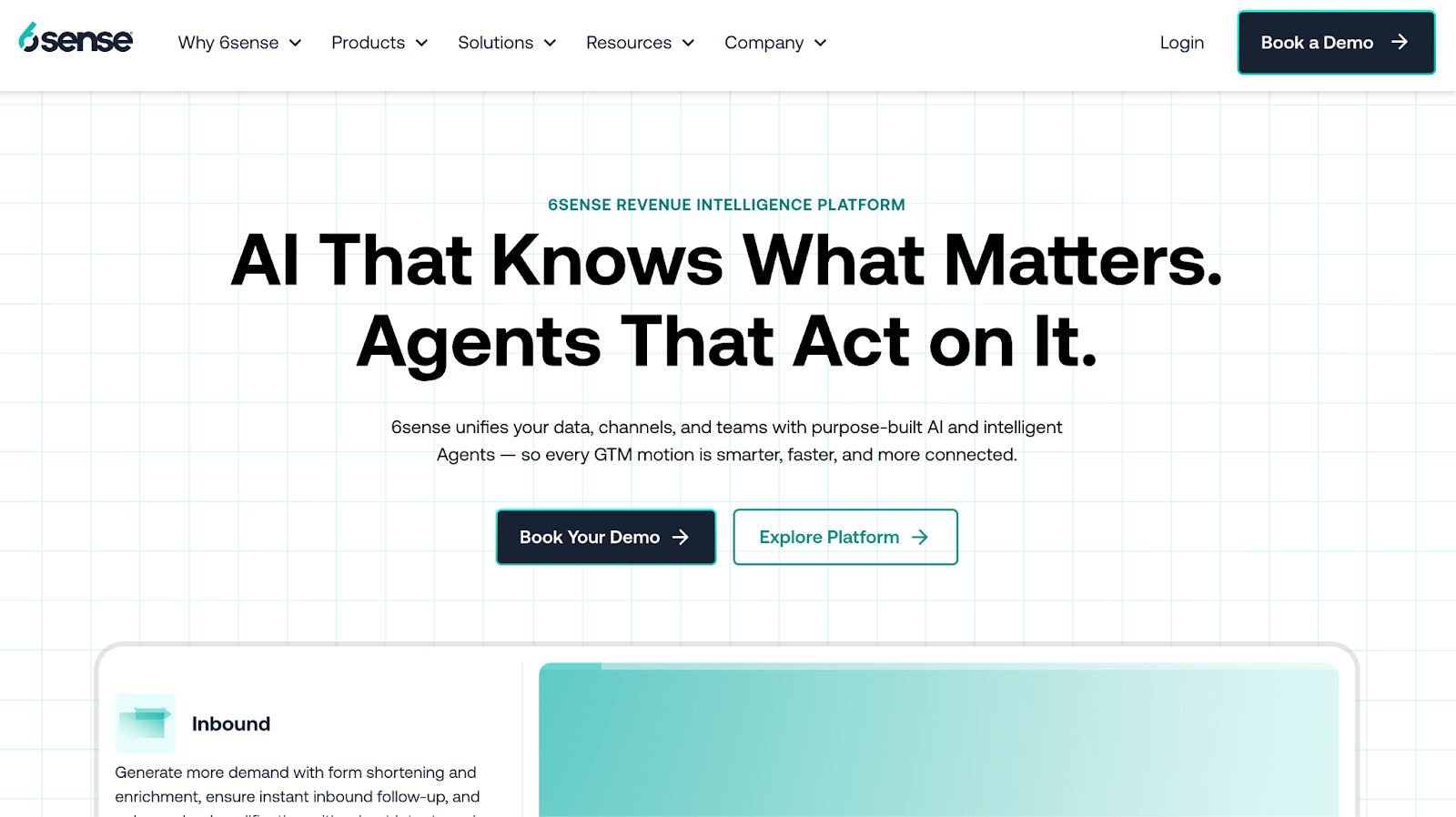
Best for: Enterprise GTM teams with strong RevOps support managing 200+ accounts per SDR.
Pros:
- Identifies accounts to prioritize from large lists
- Strong Salesforce fit once configured
- Catches early intent like competitor spikes or category interest
Cons:
- Needs a dedicated RevOps owner
- Data accuracy issues (stale contacts, false positives)
- Weak EMEA coverage
Bottom Line: Best for complex enterprise sales. Smaller teams struggle to get value, and it becomes shelfware.
8. Demandbase
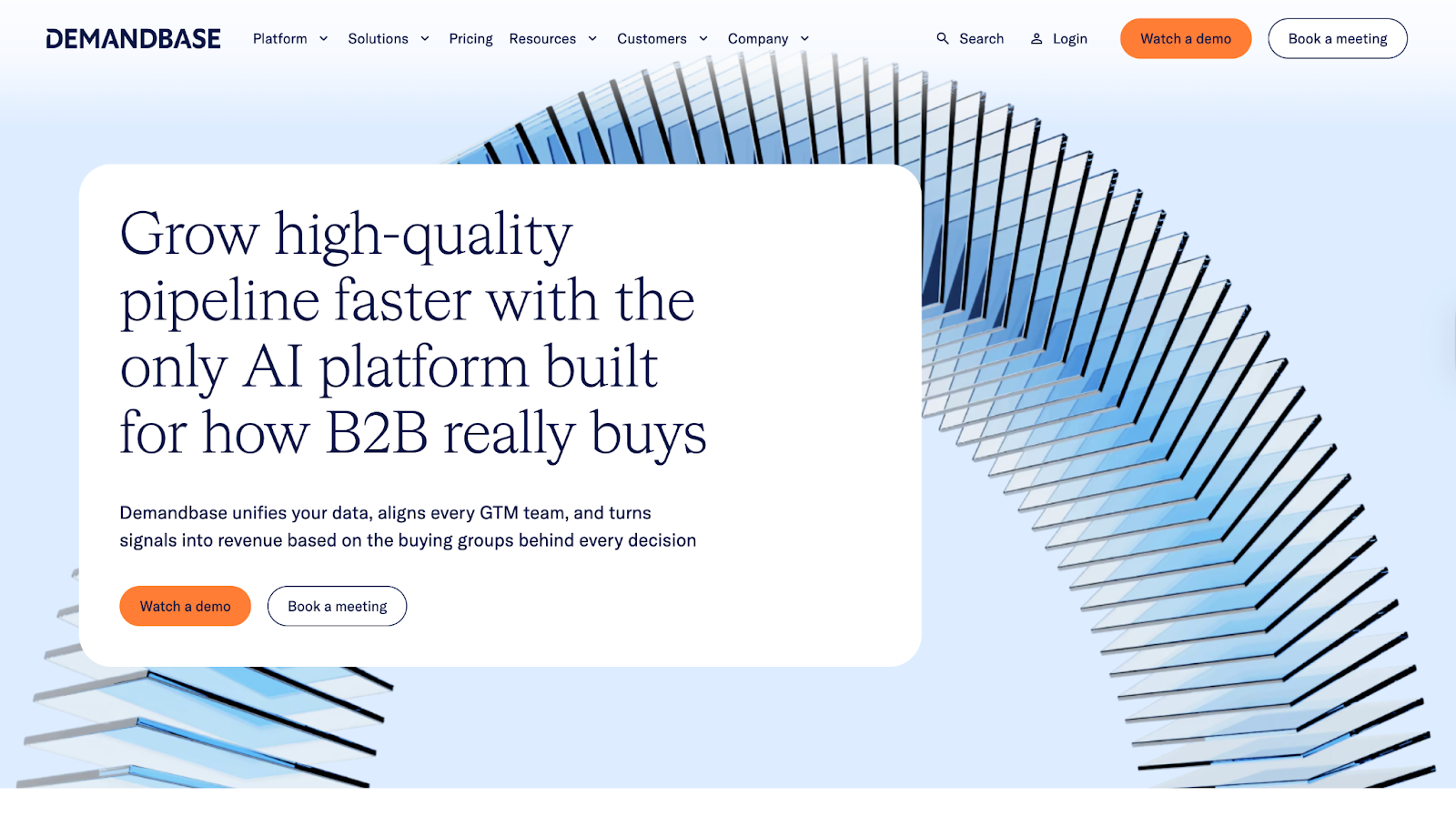
Best for: Enterprise teams running heavy paid ads targeting full buying committees.
Pros:
- Strong account-level ad targeting across buying groups
- Hands-on support
- Integrates with Salesforce, HubSpot, Marketo, LinkedIn
- ABM + light sales intelligence in one
Cons:
- Intent signals need manual validation
- Limited segmentation
- Outdated UX
Bottom Line: Works well for big-budget ads. Less useful for outbound sales teams.
The CRM: Where marketing and sales data connect
Without a shared CRM, marketing can't prove ROI, and sales can't see buying signals. 90% of executives say unified customer data is critical; it's the difference between aligned teams and constant firefighting.
Your CRM is that single source of truth. Marketing tracks engagement and attribution. Sales logs calls and moves deals. Both teams work from the same data.
What to look for:
- Bi-directional sync: Marketing pushes leads in, sales pushes deal data back out
- Full-funnel visibility: Track from first touch to closed revenue in one system
- Automatic logging: Emails, calls, meetings, and campaign activity captured without manual entry
9. Salesforce
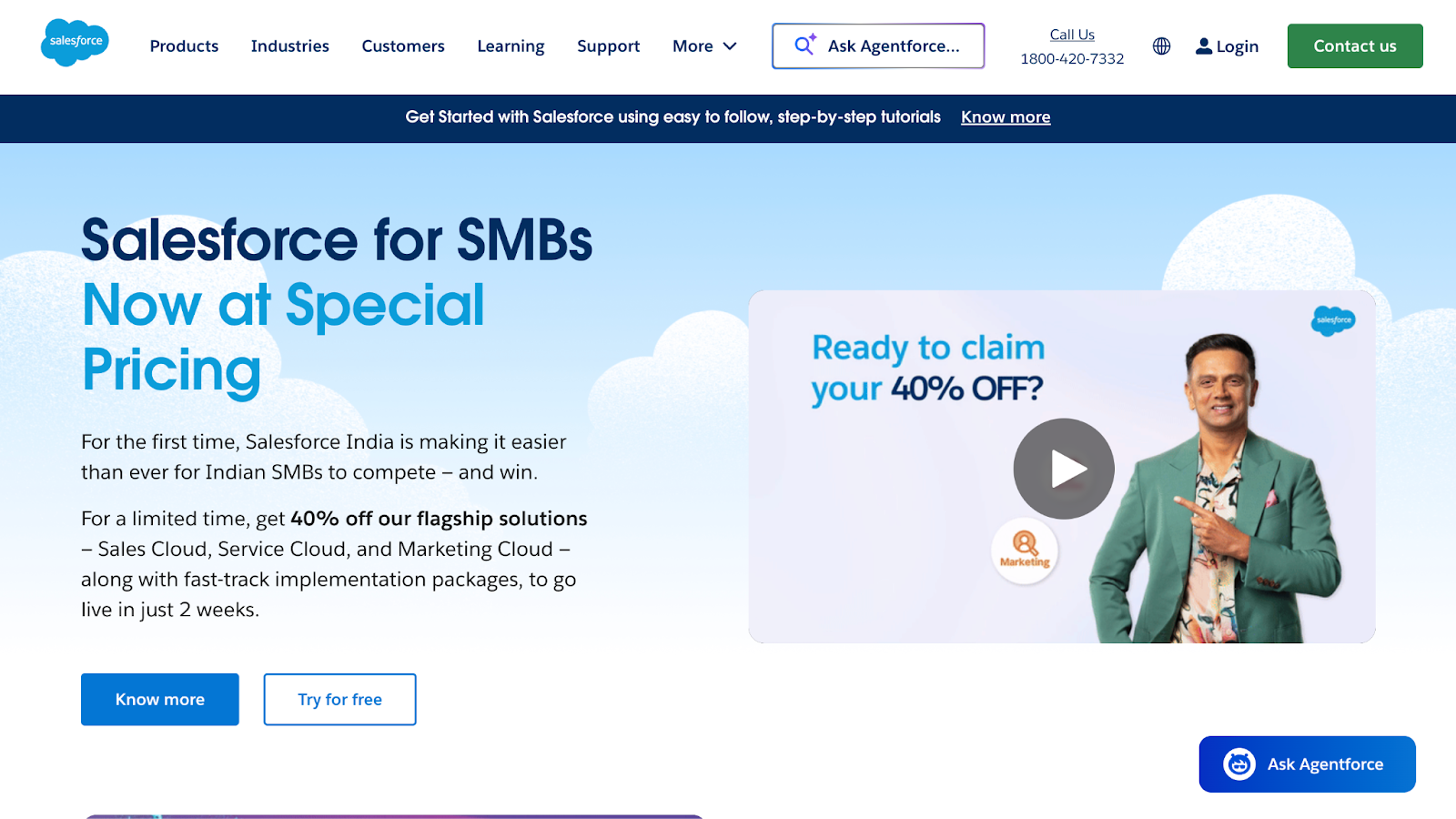
Best for: Enterprise GTM teams with complex processes and a Salesforce-centric revenue stack.
Pros:
- Highly customizable for intricate workflows
- Strong enterprise-grade security and governance
- Integrates well with tools across the revenue stack
- Deep automation + strong reporting with cross-team visibility
Cons:
- Requires a dedicated ops/admin owner
- Expensive as you scale modules and seats
- Steep learning curve for non-technical users
Bottom line: Strong choice for teams with ops support, heavy customization needs, and cross-visibility requirements. Lean teams may struggle with the overhead.
10. HubSpot CRM
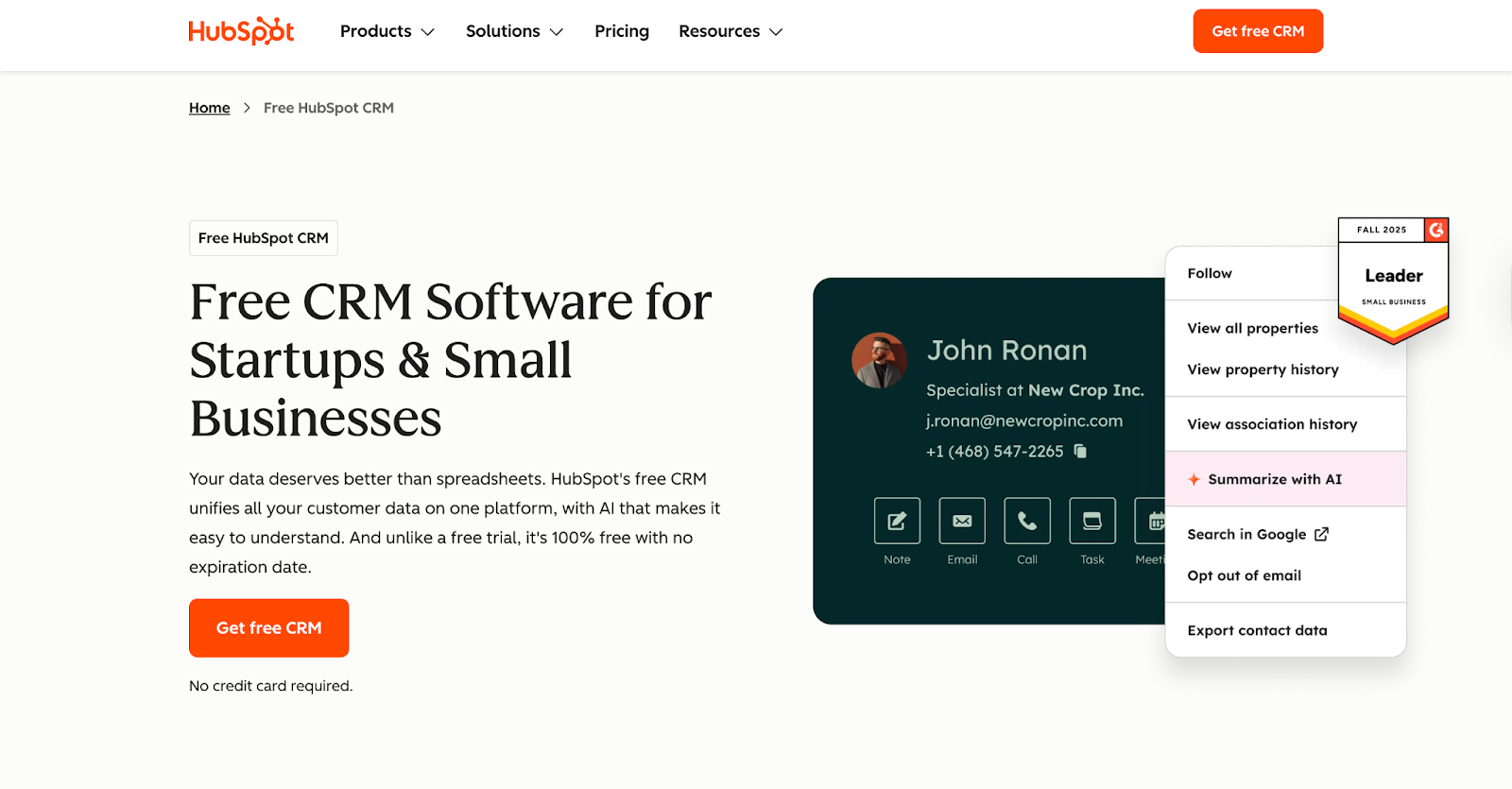
Best for: Small–mid GTM teams who want fast adoption, tight marketing alignment, and minimal admin support.
Pros:
- Sales + Marketing data in one system, lifecycle clarity without stitching tools
- Integrates well with tools already in your revenue stack (Outreach, Gong, Factors, Marketo, etc.)
- Easy to set up, less dependence on RevOps
- Works well for simple pipelines and straightforward GTM motions
Cons:
- Less flexible data model than Salesforce
- Annual contracts, cancellation is cumbersome
- Advanced reporting and automation sit behind higher tiers
Bottom line: Perfect for basic CRM + marketing flows, but not ideal if you need heavy customization, deep reporting, or complex workflows.
11. Zoho CRM

Best for: Budget-conscious, sales-driven teams that need CRM + ops + support in one place, and have basic ops/admin help for setup and upkeep.
Pros:
- CRM + email marketing + support desk + basic workflows in one suite
- Highly customizable for ops-heavy teams
- Low per-seat cost compared to HubSpot (good for scaling)
- Integrates with common GTM tools (LinkedIn Sales Navigator, Zapier, Slack, Google, Factors, Outreach, Gong)
Cons:
- Clunky UI, steeper learning curve
- Reporting and automation often need custom work
- Requires ongoing ops/admin ownership
Bottom line: Works well for custom ops setups, not the best if you need a simple, rep-friendly CRM.
Types of B2B Sales Tools
Once leads get qualified, it’s the sales team’s job to move them toward conversions. At this stage, they mainly focus on three jobs:
- Track every deal in one place: A CRM that stores contacts, conversations, and opportunities.
- Find the right people inside each account: Sales intelligence that identifies decision-makers and champions.
- Reach them efficiently: Engagement tools that automate outreach, schedule meetings, and reduce friction.
And the tools to get these jobs done are:
Sales Intelligence Tools
ABM shows which accounts are ready. Sales intelligence tools show who to contact within those accounts, along with their roles, seniority, buying authority, and engagement signals.
Two people from the same account may see your content, but only one is checking pricing or has decision-making power. Sales intelligence tools make that clear, so reps don't waste time.
What to look for:
- Fresh, accurate data: 70%+ verified contacts with weekly updates, stale data means bounced emails and dead calls
- Complete contact profiles: Direct dials, emails, LinkedIn URLs, roles, and job changes
- Account structure visibility: Org charts and buying committees to navigate multi-stakeholder deals
12. LinkedIn Sales Navigator

Best for: Teams doing high-volume LinkedIn outreach or social selling
Pros
- Advanced filters for B2B prospecting (function, growth signals, Boolean)
- Real-time signals (job changes, role updates, company news)
- Great for identifying decision-makers and mapping org structures
- Integrates with major CRMs (Salesforce, HubSpot, Zoho)
Cons
- Scraping/export automations carry real account-ban risk
- Native exports are limited, third-party tools needed
- High per-seat cost
Bottom line: Perfect for targeting and intelligence inside LinkedIn, but you’ll still need another tool for verified emails and mobile numbers.
13. ZoomInfo
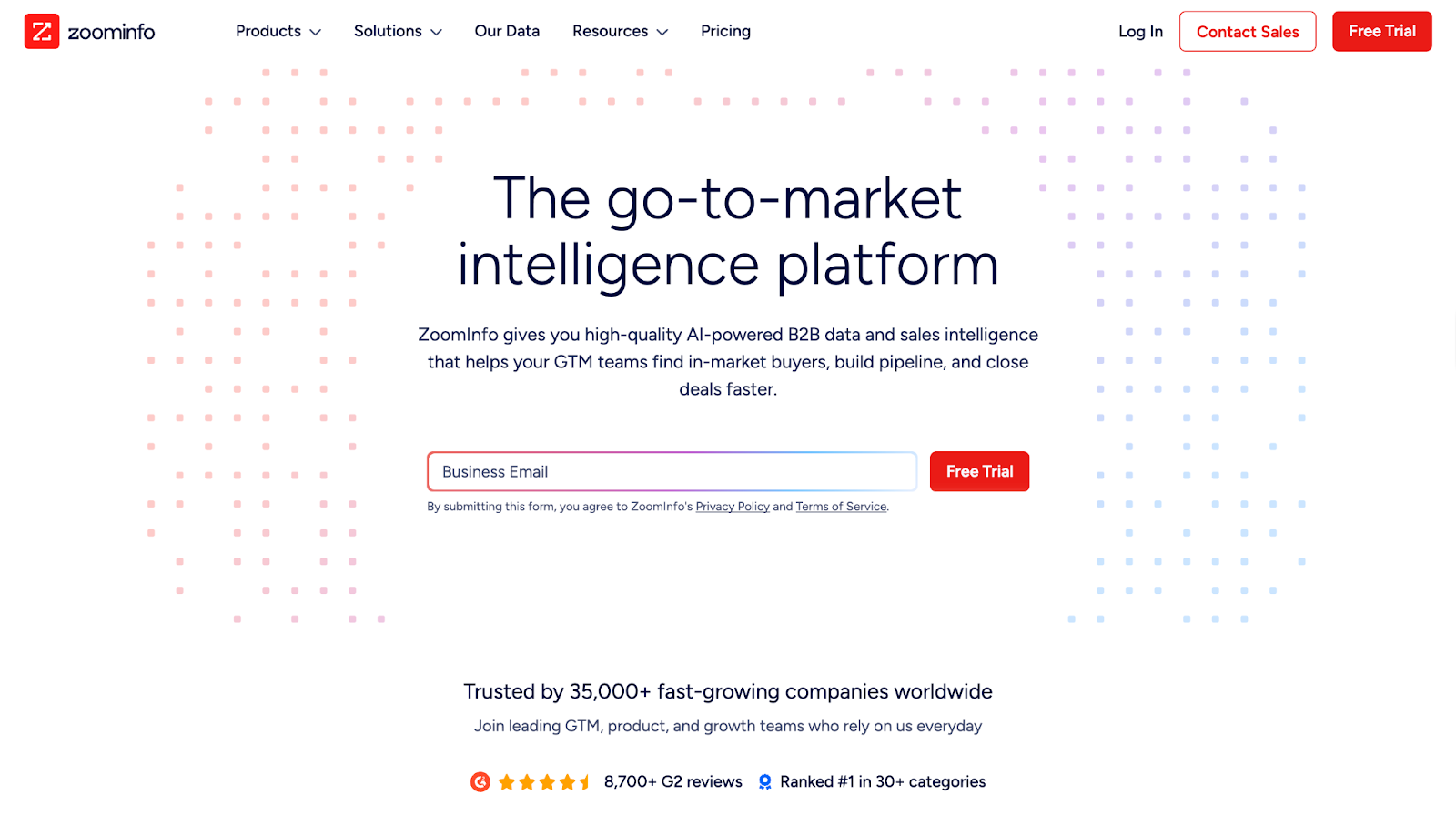
Best for: US outbound teams needing comprehensive contact data and org charts
Pros
- 85% data accuracy
- Fast enrichment and one-click CRM pushes
- Deep contact & account coverage - direct dials, verified emails, buying-committee visibility
- Strong intent signals and internal buying triggers that help prioritize in-market accounts
- Highest hit-rate for US tech + mid-market/enterprise personas
Cons
- Very expensive compared to Apollo, and Lusha
- EMEA/APAC data coverage is weaker and less reliable than US
Bottom line: Industry leader for data depth and accuracy. Expensive but worth it for teams doing serious outbound at scale.
14. Apollo

Best for: Budget-conscious GTM teams that want broad contact coverage, built-in outreach, and solid data without enterprise-tool overhead.
Pros:
- 210M+ contacts, 35M+ companies (70–80% accuracy)
- Strong value for price, ZoomInfo-like depth at lower cost
- Easy CRM integrations (HubSpot, Salesforce, Zoho, Pipedrive)
- Prospecting + sequencing in one platform across all paid plans
Cons:
- Phone/mobile accuracy weaker compared to ZoomInfo
- Data freshness varies, some roles outdated
- Daily send limits on lower-tier plans
Bottom line: ZoomInfo-level depth at a more competitive pricing. Expect 10–15% lower accuracy but 40–50% cost savings.
You can also pair Apollo with Factors.ai to identify and score in-market accounts first, then pull contact details for faster, higher-quality outreach.
Sales Engagement Tools
Sales engagement tools handle the repetitive work (sequences, follow-ups, meeting scheduling, next-step suggestions) so reps can focus on selling, not admin.
What to look for:
- Multichannel sequencing: Email, LinkedIn, calls, SMS, and follow-ups from one place
- Built-in calling + meetings: Native dialer with recordings and frictionless scheduling
- Personalization at scale: Dynamic fields and clear reply/meeting metrics
15. Klenty
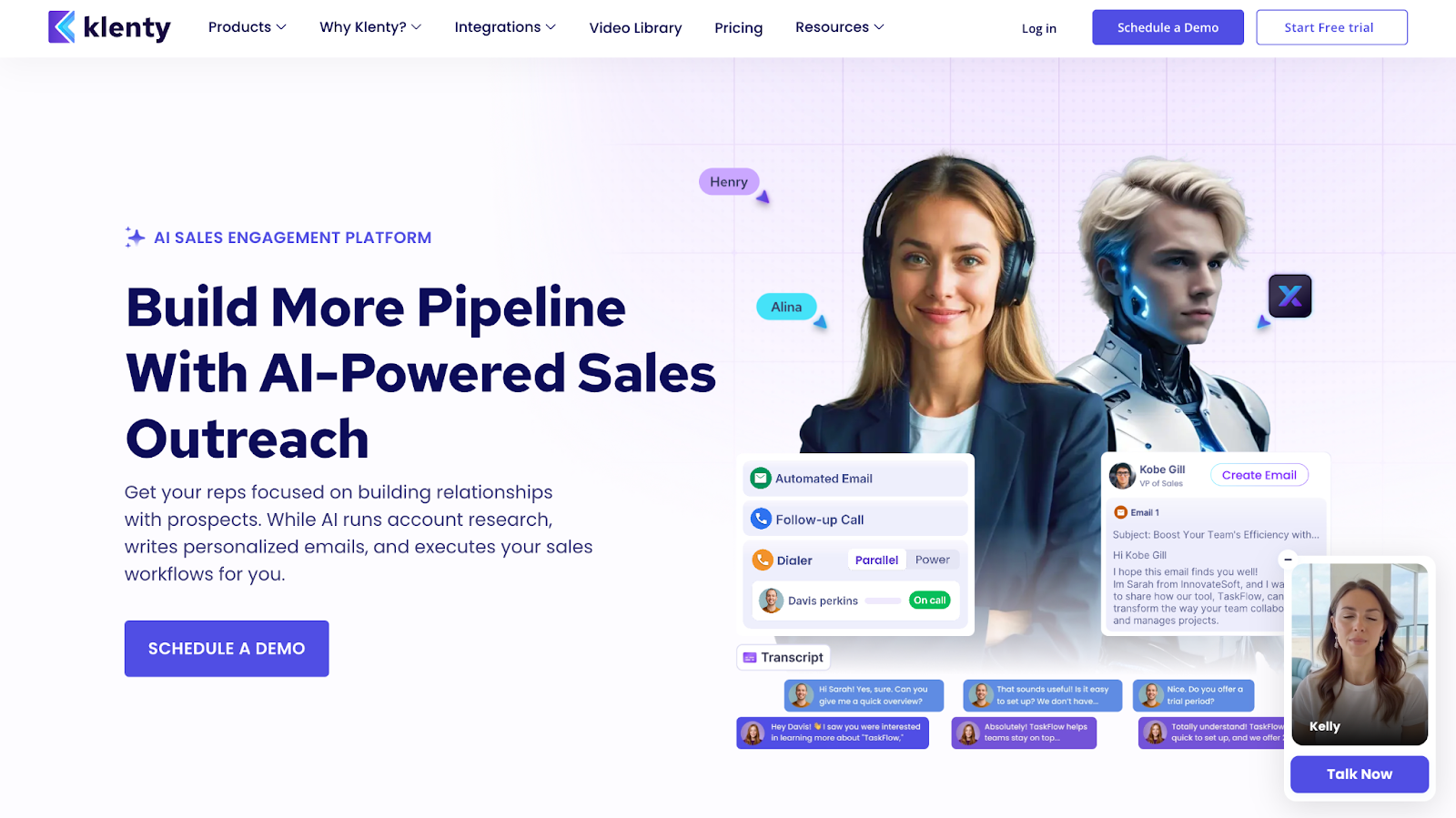
Best for: Small–mid sales teams that want fast, email-first outreach, smooth CRM syncing, and minimal setup.
Pros
- Lightweight to operate, no admin or training needed
- Strong email sequencing with high-volume support
- Built-in deliverability boosters (random send intervals, mailbox rotation)
- Smooth CRM integrations (HubSpot, Salesforce, Pipedrive, Zoho)
Cons
- Limited LinkedIn automation
- Paywalled features on lower plans
- Less customization than bigger platforms
Bottom line: A fast, no-friction outreach tool for email-first teams. Great for simple, high-volume execution, not the choice if LinkedIn or deep customization matters.
💡Case study: Klenty increased conversion rate by 34% using Factors.ai's intent data for sequence triggering.
16. Salesloft
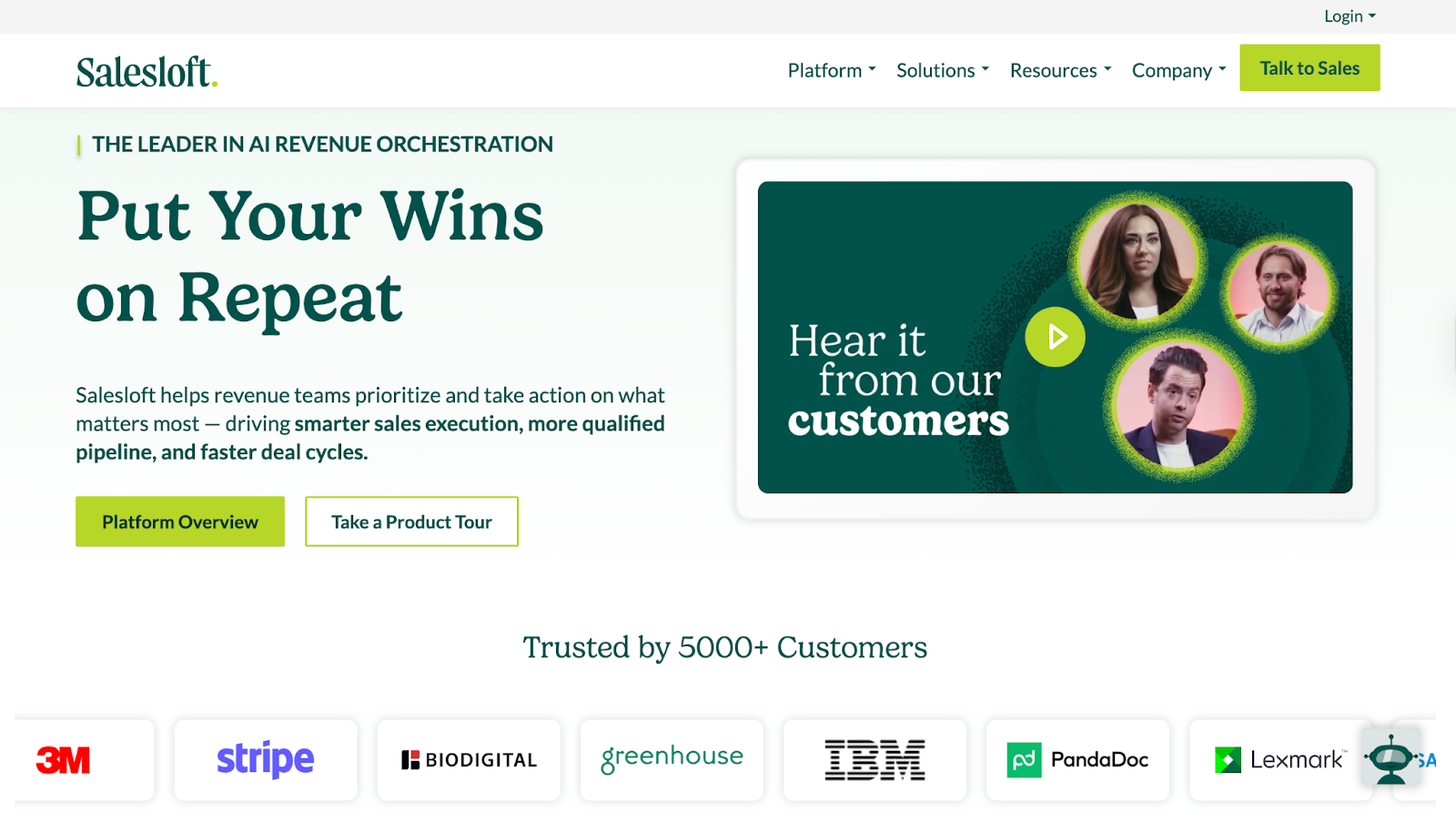
Best for: Mid to large sales teams running multichannel outreach who need deep Salesforce integration, deep reporting and analytics
Pros
- Powerful multichannel cadences across email, calls, LinkedIn
- Deep Salesforce integration with reliable bi-directional syncing
- Strong analytics, activity dashboards, and AI-driven task prioritization
- Conversation intelligence and deal insights for pipeline visibility
Cons
- Steep learning curve for new users
- Higher cost than most alternatives
- UI can feel heavy or cluttered for simple outreach needs
Bottom line: Strong for pipeline visibility and deep CRM integration. Skip if you need lightweight tools or tight budgets.
17. Outreach
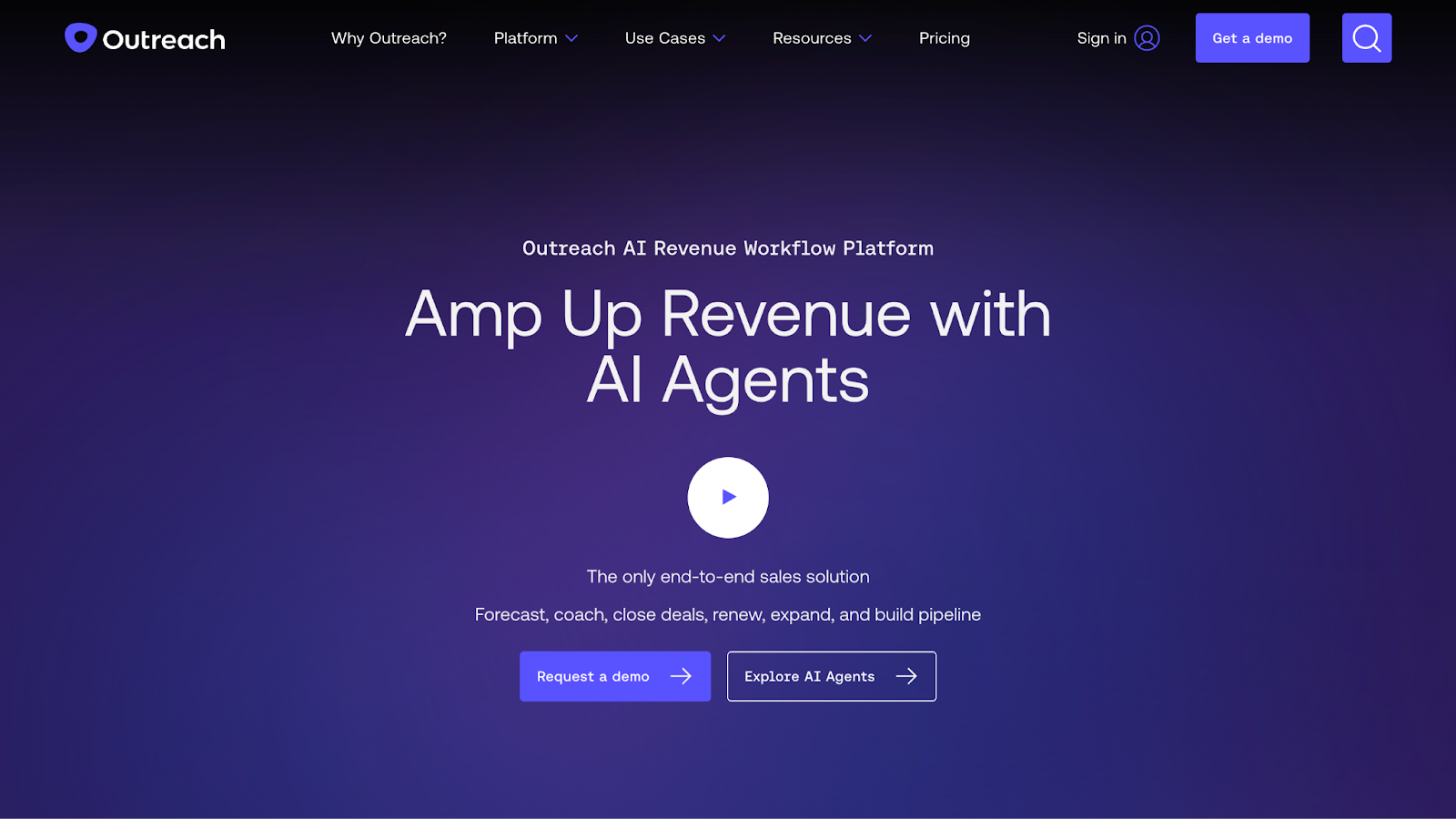
Best for: Enterprise teams that need deep visibility into pipeline activity and one system to manage outreach, calls, and deal tracking.
Pros
- Clear visibility from lead handoff to closed deal
- Outreach + conversation intelligence + revenue forecasting in one tool
- Great option for enterprise teams
- Handles high-volume outreach without breaking down
Cons
- Overly complicated UI
- Unresponsive customer support
- Limited automation flexibility
Bottom line: Best for enterprise teams needing forecasting and conversation intelligence in one platform. Too heavy for lean teams with under 50 reps.
💡Also Read: How Klenty increased their conversion rate by 34% with Factors.ai
Consolidation opportunities: How to cut your stack from 16 to 6 tools

AI Sales Tools: Do you need them?
Searches for ‘AI sales tools’ and ‘sales AI tools’ are exploding. Threads list 70 plus options. But here’s the thing: You probably already have AI.
Look at what you already have:
- HubSpot / Marketo → AI lead scoring, send-time optimization
- Factors.ai / Dreamdata → ML-driven conversion prediction + account scoring
- Klenty / Salesloft → AI email writing, call summaries, next-step suggestions
- Salesforce → forecasting, opportunity scoring, pipeline health
- Outreach / Gong → AI deal insights, risk detection, talk-track breakdowns
- ZoomInfo → intent scoring + predictive buyer signals
- Apollo → AI research + AI scoring baked in
But none of it is useful in isolation. Unless every tool is integrated with your CRM, you only get a partial picture or end up spending time shuttling between multiple tools. AI is only as good as the data it’s fed.
How to choose the right marketing and sales tools?
Choosing the right sales and marketing in 2026 can be quite overwhelming. You open one blog and find 47 "best tools" lists. G2 shows 4.7 stars, but reviews say "great for enterprises, terrible for teams under 50." Three hours later: 23 tabs open, zero decisions made.
If that sounds like a day in your life, here’s how you can evaluate what belongs in your revenue stack:
1. Start with the gap, not the category
Ask: "What's actually breaking in our funnel?" Map the tool to your buyer journey. If prospects drop off after initial engagement, you need nurture automation. If sales can't tell who's serious, you need intent signals.
2. Integration with your CRM
No tool is worth buying if it doesn't sync cleanly with your CRM. Broken integrations create more problems than they solve. Check for native integrations first, not just ‘API available.’
3. User experience
Let your team decide. Take free trials to gauge ease of use. If reps won't use it, it's wasted budget.
4. Security and AI transparency
Ask: Where does the data come from? Does the AI learn from your closed deals or generic patterns? For sales intelligence tools, verify 70%+ data accuracy.
5. Pricing and contract terms
Calculate total cost: seat licenses, onboarding, training, and admin time. Before signing, confirm you can scale or cancel mid-contract.
Next Steps: Your 3-Step Stack Audit
Step 1: Map your current sales and marketing tools against the revenue stack
List every tool you're paying for. Which category does it serve? Look for functional overlaps. For example, if you have 2 tools doing attribution, you've found bloat.
Step 2: Look for consolidation opportunities
- Paying for attribution + ABM separately? Consolidate to one platform (like Factors.ai)
- Have ZoomInfo and Lusha? Choose one that offers deeper intelligence
- Using multiple engagement tools? Pick one that includes calling, sequencing, and scheduling
Step 3: Test before you cut
Run free trials for at least a month on new tools before replacing the older ones. If adoption sticks and data flows cleanly to your CRM, make the switch.
And that's how you build a sales and marketing tool stack that does more with less.
Start here: Try Factors.ai free to consolidate attribution + ABM + intent in one platform.
FAQs for Marketing and Sales Tools
1. What are marketing and sales tools?
Marketing and sales tools are platforms that generate demand, nurture leads, and convert customers. They include SaaS marketing tools, CRMs, ABM platforms, sales intelligence tools, and sales engagement software.
2. What are AI sales tools?
AI sales tools (also called sales AI tools) use artificial intelligence or machine learning to automate sales tasks like lead scoring, content generation, call/email assistance, and account research. Unlike normal automation that uses if-then clauses, AI learns from past wins to figure out the next best steps.
3. How is machine learning used in sales?
Machine learning automates a variety of sales tasks, including churn prediction, lead scoring, forecasting accuracy, and deal health scoring. These tools gauge buyer behavior and historical performance to determine the best way forward to move deals across the pipeline.
4. What are the best AI tools for sales?
The best sales AI tools depend on your tech stack, CRM, team size, and workflows. Pick based on the biggest gap in your funnel, whether that's assistants/copilots, predictive forecasting, or prospecting tools.
5. What are business development tools?
Business development tools (also called sales development tools) help teams find new opportunities and reach out to them. This includes prospecting platforms, sales intelligence tools, meeting-scheduling software, proposal tools, and LinkedIn-based outreach tools.
6. What are SaaS marketing tools?
SaaS marketing tools are platforms designed to help software companies attract, engage, and convert customers through digital channels like email, content, SEO, and paid advertising.

Best Clay Alternatives for GTM Teams in 2026
If you’ve used Clay, you know it’s impressive. It pulls data from the deepest corners of the world, lets you shape it exactly how you want, and helps build flexible workflows with a high degree of control. For fast-moving teams, this gives a powerful edge.
But once Clay becomes part of day-to-day GTM operations, it loses steam. 🌫️
Yes, Clay keeps doing its part well, but it stops short of actual execution. If I had to tell you another thing that bothered me… it would be maintenance. I spent more time keeping existing workflows running than I expected. I also had to jump between tools just to act on the data, while outreach, ads, and intent signals were all on different platforms.
I could prepare everything perfectly, but I still had to decide (through human intervention) what to do next and where to do it. At this stage, it really started to feel like automation that isn’t automated?!
The pattern became obvious for me: Clay helped me get ready, but it didn’t help me execute.
That’s when I understood why GTM teams start looking for alternatives. While Clay does its job pretty well, it’s not enough anymore. Job requirements have changed. GTM motions have grown more complex, and the question has shifted from “How do I enrich this data?” to “How do I turn real signals into action without jumping between different tools?”
This guide is for that moment.
TL;DR
- Clay is great for data enrichment and workflow building, but it falls short when it comes to execution.
- Apollo and ZoomInfo solve specific problems, but don’t unify GTM workflows.
- As GTM motions mature, teams need systems that connect intent, action, and CRM updates.
- Factors.ai stands out by focusing on signal-driven activation, not just data prep.
- The right tool depends on your GTM maturity, not feature checklists.
Criteria for Evaluating Clay Alternatives in 2026
Yes, Clay is good at what it does (There’s a reason so many growth teams adopted it early). But the way teams evaluate alternatives today is very different. These teams know firsthand that connecting multiple tools is like playing Jenga: Each workflow works fine on its own, but one small change (like a broken sync, or a missed signal) and the whole thing starts wobbling.
That’s why I have evaluated Clay alternatives that align with the changing requirements - a new system that helps you choose “better alternatives”:
- Unified data and activation:
The first thing I look for now is unified data and activation. Clean data matters, but it’s useless if it can’t trigger action. The system should know when something important happens and act on it without waiting for manual steps.
- CRM hygiene:
CRM hygiene is next. If the tool doesn’t keep records clean, updated, and consistent, everything downstream suffers. A modern GTM tech stack should prevent mess, not create more of it.
- Intent integration:
Teams need real buyer intent signals (not static worksheets) that show when an account is warming up along with the ICP.
- Workflow automation:
Workflow automation still matters, but the bar is higher. It’s moved on from just building clever logic to whether workflows actually reduce work across teams.
- AI-driven routing and prioritization:
This one helps in deciding what deserves attention right now.
- Cost efficiency:
Cost plays a bigger role, too. Tools that look affordable initially can become expensive once usage scales.
- Integration:
Integration is another non-negotiable. Any serious alternative needs to work cleanly with LinkedIn Ads, Google Ads, and the CRM. If those connections are weak, the system won’t hold.
And finally, I asked one simple question: Can this tool function as growth engineering infrastructure, or is it just a one-off solution?
These are the criteria on which I have chosen the seven Clay alternatives.
What Is Clay Better At (But Where It Falls Short)
But, before we get down to the alternatives, there are a few upsides and downsides to Clay (you start to feel these just as soon as you catch momentum) that need to be looked at.
Clay does a lot of things (genuinely) well:
- It is excellent at data enrichment.
- The spreadsheet-style interface feels familiar.
- The workflows are flexible.
- Its ability to layer logic on top of data is impressive (and powerful).
For research-heavy GTM work or one-off growth experiments, it’s hard to beat.
It’s also great for teams that like to build. If you enjoy tinkering, testing prompts, and building complex workflows, Clay gives you a big sandbox. That flexibility is the reason so many growth teams opt for it in the first place.
But, here’s where it falls short:
- Clay isn’t built to run end-to-end GTM automation:
There’s no native prioritization layer (to help you decide which accounts matter right now), and it doesn’t even give you a sense of timing (so you know when to outreach prioritized accounts). Everything still depends on someone checking workflows, exporting data, and deciding what to do next.
- Clay assumes technical expertise:
It assumes your team has the technical skills to manage workflows on their own. Your team has to own the logic, watch credit usage, debug broken workflows, and keep everything in sync, which works when volume is low or the team is small. Scaling with it becomes harder, when SDRs, marketers, RevOps, and growth teams all depend on the same system.
- Clay doesn’t unify GTM touchpoints:
Fragmentation is its biggest limitation. Clay can’t unify GTM touchpoints on its own. Ads data, contact details, website intent, all are managed separately. CRM updates happen after the fact. Yes, Clay is in the middle of all this, but it doesn’t close the loop.
So, while Clay remains a strong data enrichment and workflow tool, it struggles to become the system that runs GTM. If your team is hustling toward full GTM engineering, this gap is hard to ignore.
Now, let’s take a look at the alternatives.
Top Clay Alternatives for GTM Tools & Growth Teams
Note: Not every Clay alternative (listed here) is trying to replace the same thing. Some replace data enrichment, some sequencing, while a few others try to replace the system Clay often ends up sitting inside.
- Factors.ai (Best for unified GTM automation: intent, ads, signals)
If Clay is your prep kitchen (it helps you source ingredients, clean them, cut them, label them, and keep them ready), Factors.ai is your head chef + service flow (it watches what guests are doing, who just walked in, who is lingering, and who looks ready to order).
Factors.ai combines strong enrichment with workflow automation, helping GTM teams act on data instead of just collecting it.

Factors.ai starts with account-level intelligence and is designed to turn signals into action. This means it:
- Captures intent and engagement across touchpoints, including website activity and account behavior
- Syncs that context into the CRM, keeping records current without manual updates
- Routes signals to sales teams in real time, so outreach happens when timing is right
- Triggers action across channels, including outbound motions and LinkedIn and Google Ads through AdPilot.
- Maintains closed feedback loops between signals, actions, and CRM updates
By orchestrating website activity, account signals, ads, and CRM feedback loops in one system, it removes much of the manual data movement that slows GTM teams down. For teams doubling down on growth engineering motion, Factors.ai comes up to be one of the cleanest Clay alternatives.
Related Read: How Factors.ai connects intent, signals, and activation across the full GTM funnel
- Apollo.io (Best for scaling cold outreach quickly)
If Clay is your prep kitchen, Apollo is your serving line (where the focus is on getting plates out fast rather than perfecting ingredients. Speed matters more than nuance).
At first glance, Clay vs Apollo feels like a simple choice: Clay is technical and flexible, while Apollo is practical and ready to use. But that framing misses the MAIN question GTM teams should be asking.
Apollo has its own database and works well as an email automation tool when speed is your goal. If you need sales reps to send emails fast, Apollo removes friction. Lead lists, sequences, replies, and basic reporting all come together in one place, making it easy to get an SDR motion off the ground without much operational/administrative work.
With Apollo.io, you get:
- A large contact database that makes list-building fast
- Built-in email sequencing, so that reps can move from list to outreach quickly
- A straightforward outbound setup with minimal operational friction
- An easy path to spinning up SDR motions without heavy tooling or setup

But Apollo’s data is broad, and context can feel thin. Meaning,
- You get the job titles without any real insights
- Personalization feels templated because the intent signals aren’t clear.
Where Clay fits:
Clay is on the opposite end of the spectrum. It focuses on data enrichment and workflow building, with strong automation features for shaping and transforming data.
Where Clay falls short:
Clay doesn’t activate outbound on its own. It doesn’t have native sequencing, prioritization, or timing sense. Apollo, meanwhile, activates outbound easily but doesn’t always give teams confidence in who they’re reaching or why now is the right moment.
So GTM teams end up connecting the two: Clay prepares the data and Apollo runs the sequences.
Simple, right? Not so much…Turns out connecting the two creates handoffs and sync issues.
Why teams move past the Clay vs Apollo debate
At this point, GTM teams move away from the ‘Clay vs Apollo’ debate, towards GTM workflows. Instead of alternating between better data and sequencing, they want a unified platform that not only silences this debate but also takes away the pain of connecting different tools.
Factors.ai helps you achieve this seamlessly. Using company-level intelligence and intent data, Factors.ai identifies an account that’s warming up and triggers activation automatically. That activation can be outbound, ads through AdPilot (Google and LinkedIn), CRM updates, or alerts to sales teams to amplify their outreach efforts.
- ZoomInfo (Best for enterprise data quality and depth)
If Clay is your prep kitchen (where the ingredients are sourced from different suppliers), ZoomInfo is your walk-in freezer stocked by a national supplier (where everything is labeled, organized, reliable, and comes from one large, dependable source).
The Clay vs ZoomInfo comparison usually comes up when GTM teams start questioning the data itself, instead of just how fast they can act on it.
ZoomInfo stands out when accuracy and coverage matter more than flexibility. Large teams rely on it for firmographics, org charts, and buyer intent, especially in US-focused sales motions. You get some of the most accurate contact data, especially for the US, and buyer intent is part of the package. For sales teams that want confidence in who they’re reaching and whether an account fits their target market, ZoomInfo feels reliable. It gives leadership confidence that the data foundation is solid.
The downside here is how that data is used. ZoomInfo isn’t built to adapt to custom GTM workflows or to support rapid experimentation. Activation usually happens elsewhere, and teams rely on downstream sales tools to turn data into action. Cost also becomes a factor as usage scales.
ZoomInfo is strong at answering who exists. It’s less strong at helping teams coordinate what happens next.
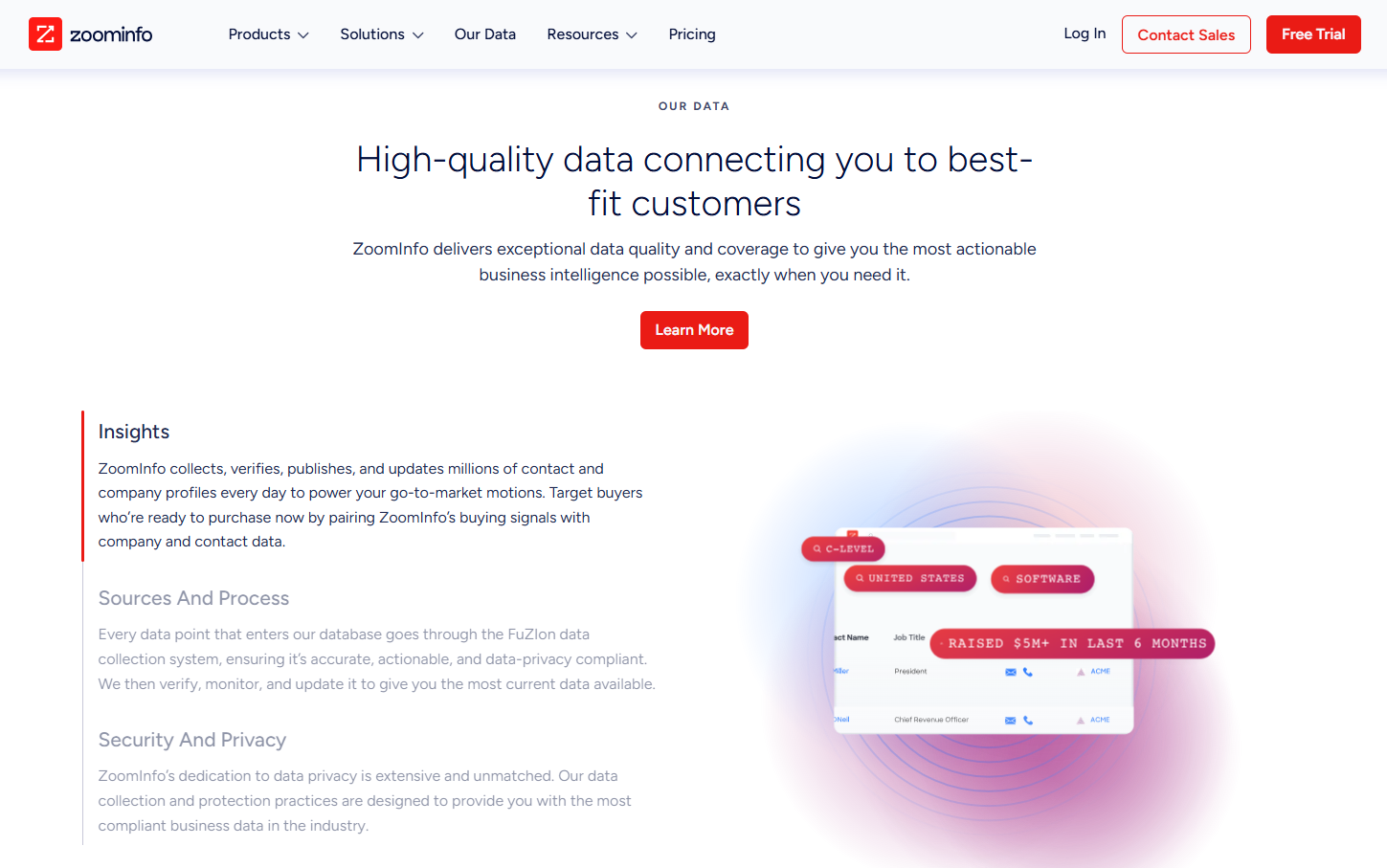
Where Clay fits:
Clay flips that. Clay is all about flexibility. You can combine data sources, apply logic, and shape data to fit your process. If the problem is adapting data to your GTM motion, Clay gives you room to do that.
Where both tools fall short is execution (again). Neither is built for multi-channel GTM engineering. Intent, outbound, ads, and CRM updates still live in different places, which means manual stitching and fragile feedback loops.
Some GTM teams take a step back from this data depth vs workflow flexibility row. Instead, they look for systems that handle both intent and activation together. Factors.ai does this seamlessly. By ingesting account-level intent and triggering activation from the same place, it reduces the need for constant handoffs and data silos.
Clay and ZoomInfo solve different problems well. But once GTM becomes system-level, data alone isn’t enough.
Related Read: Detailed comparison of Factors.ai vs ZoomInfo
- 6sense / Terminus (Best for ABM and intent signal programs)
If Clay is your prep kitchen (focused on getting ingredients ready), 6sense and Terminus are your banquet planning system (they decide which tables matter, what meals are being served, and how the evening is structured) that assumes you have well-trained staff and set menu.
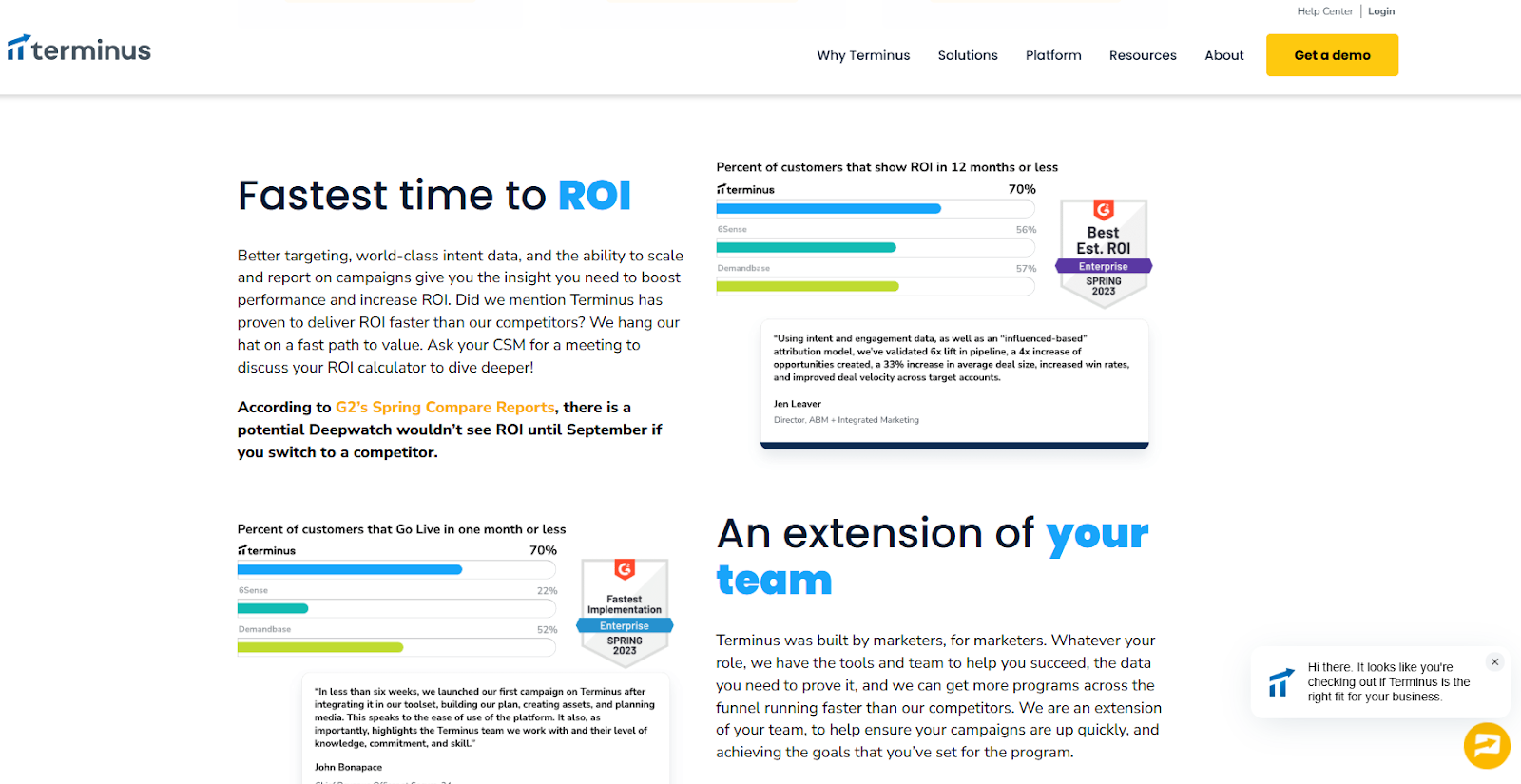
6sense and Terminus are purpose-built for account-based motions. They bring intent data, account insights, and advertising together under an ABM framework. For enterprise teams running planned, top-down GTM programs, this structure works well.
The challenge is weight. These platforms take time to implement, require alignment across teams, and come with higher cost. They’re opinionated systems, which makes them powerful in the right environment but less flexible for teams still evolving their GTM motion.
For mid-market or lean teams, they can feel like committing to a GTM model before it’s effectiveness is clear.
- n8n (For GTM teams with in-house engineering muscle)
If Clay is your prep kitchen, n8n is the plumbing and wiring behind the building. It’s powerful, flexible, and gives you full control, but it doesn’t know anything about GTM on its own.
n8n is an open-source workflow automation tool. It’s loved by technical teams because you can self-host it, customize it deeply, and build exactly what you want using APIs and custom logic. For GTM engineering teams with strong developer support, this is appealing. You can recreate enrichment flows, routing logic, and tool-to-tool syncs without being boxed into a predefined GTM model.

However, n8n doesn’t understand concepts like intent, accounts warming up, buying stages, or prioritization. You have to define all of that yourself. Every scoring rule, every trigger, every edge case becomes your responsibility. Maintenance scales with complexity.
n8n works best when:
- You already have engineers supporting GTM
- You want maximum control over workflows
- You’re comfortable building and maintaining logic long-term
It’s less ideal if you want GTM intelligence and execution out of the box. n8n moves data extremely well, but it doesn’t tell you what matters or when to act unless you explicitly build that intelligence yourself.
- Make (For teams that want flexibility without full engineering)
If Clay is your prep kitchen, Make is the conveyor system that moves ingredients between stations quickly and reliably.
Make (formerly Integromat) is a low-code automation platform designed for speed and accessibility. Compared to n8n, it’s easier to set up and friendlier for RevOps or growth teams that don’t have deep engineering support. You can connect tools, automate handoffs, and build fairly complex workflows without writing code.
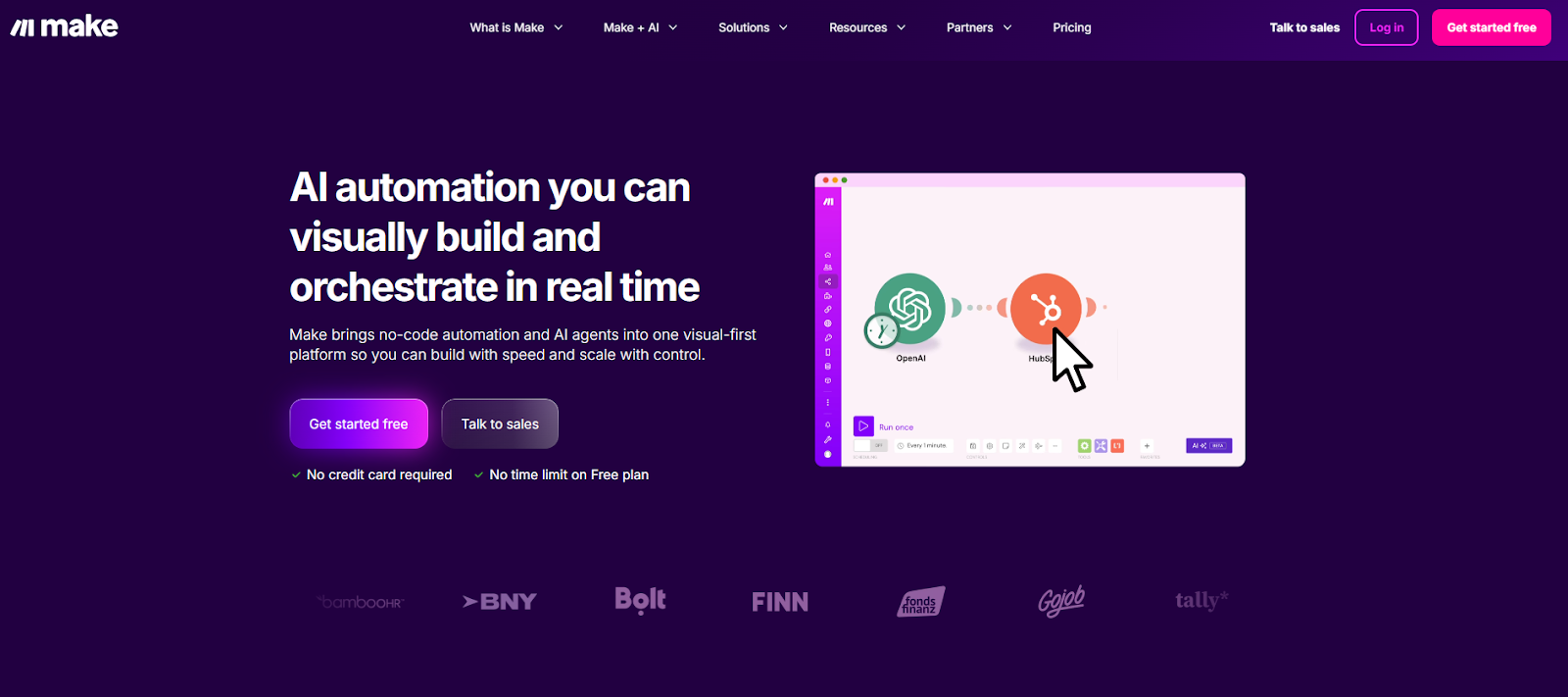
That ease comes with limits. Like n8n, Make doesn’t understand GTM context. It doesn’t know what an intent spike is, how to score accounts, or when outreach should happen. You can automate actions, but you still have to decide the logic manually, often using static rules or scheduled checks.
As GTM motions grow more complex, Make workflows can become fragile. Small changes in tools or logic often require manual fixes, and prioritization still lives outside the system.
- Clearbit, People Data Labs, Datagma (Breadcrumb-style enrichment tools; Good for data, not for GTM workflows)
If Clay is your prep kitchen (where ingredients are turned into something usable), Breadcrumb tools such as Clearbit, People Data Labs, and Datagma are ingredient suppliers (they just deliver high-quality ingredients at your doorstep).
Tools like Clearbit, People Data Labs, and Datagma enrich records, fill gaps, and improve data quality inside your CRM or warehouse. But they stop at enrichment. There’s no orchestration, no activation, and no feedback loop. Teams still need other systems to route leads, trigger outreach, run ads, or prioritize accounts.
They work best as supporting pieces in a larger tech stack if your goal is end-to-end GTM automation.
Deep Dive: Why GTM Engineering Teams Prefer Unified Platforms
Growth engineering has pushed GTM teams to think in systems. The focus is no longer on what a single tool can do, but on how everything works together once real volume and multiple channels are involved.
That’s why Clay alternatives are increasingly evaluated at the system level.
- Unified view of account activity:
GTM teams want one common view for account activity and intent. When signals, engagement, and context live in different tools, decisions slow down and confidence drops.
- Multi-Channel Activation From One Signal:
They also want multi-channel activation built into the same workflow. A meaningful signal should trigger the right actions across outbound, ads, and the CRM without manual coordination.
- CRM hygiene automation:
This has become just as important. Rather than fixing routing or fields as problems appear, growth engineering teams want systems that keep records clean as signals change.
- Real-time signal-based routing:
Static rules miss timing. Teams want actions triggered by actual behavior over scheduled batches and fixed logic.
- Turning Intent Into Ads Automatically:
And finally, insights need to flow directly into ad activation. When intent stays locked in dashboards, value is lost. The strongest systems push those insights straight into LinkedIn and Google automatically.
Tools like Factors.ai work well because they operate as a unified system for account intelligence and activation, connecting signals, routing, CRM updates, and ads in one place. Factors.ai also works across LinkedIn, Google, CRM, Slack, and HubSpot workflows, aligning closely with how growth engineering teams run GTM today.
Related Read: Intent data platforms and how they work
Case Study Highlights: Common Patterns Across Factors Customers
Teams from Descope, HeyDigital, and AudienceView show a similar shift in how they run GTM once they move to a unified setup with Factors.ai.
Rather than centering GTM around spreadsheets and enrichment workflows, these teams focused on account-level signals and automation.
Here, using company intelligence as the trigger for action, website engagement and account activity acted as the starting point. This then flowed into downstream GTM actions without manual handoffs.
Next, they activated multiple channels from the same signal. The same account insight informed outbound outreach and ad activation, rather than maintaining separate lists for SDRs and marketing. This reduced lag and kept messaging aligned.
CRM data hygiene also improved as a result. Instead of cleaning records after issues appeared, routing, ownership, and key fields updated automatically as engagement changed. Now, RevOps involvement shifted from constant maintenance to oversight.
By changing the operating model, i.e. keeping intent, activation, and CRM data updates in one place, these teams reduced operational drag and made GTM execution easier to scale and trust.
Related Read: Turning anonymous visitors into warm pipeline
Pricing Comparison: Clay Alternatives
Who should choose what:
- Lean teams experimenting with enrichment and workflows often start with Clay.
- Outbound-heavy teams that value speed and predictable pricing lean toward Apollo.
- Enterprise teams from established companies prioritizing data depth and coverage typically choose ZoomInfo.
- GTM engineering teams focused on intent, automation, and system-level execution tend to prefer other platforms like Factors.
Final Recommendation: Best Clay Alternative by GTM Maturity
Simply put: There’s no universal winner. The right choice depends on where your team is currently and how much GTM engineering you actually want to run. Evaluate the path that fits your maturity, rather than opting for a tool that looks powerful on paper.
FAQs for Best Clay Alternatives
Q. Is Clay a data provider or an orchestrator?
Clay is primarily an orchestration and enrichment platform. It aggregates third-party data sources and layers workflows and AI research on top, rather than owning a single proprietary database.
Q. Which Clay alternative has the best US contact data?
For US contact coverage and depth, ZoomInfo is most often cited in community discussions. Apollo.io is commonly chosen for price and ease of use, with mixed views on accuracy.
Q. Can Apollo replace Clay?
Sometimes. Apollo bundles contact data and sequencing, which makes it a simpler and cheaper option for solo users or small teams. Power users often keep Clay for research and personalization, then export it into Apollo for sending. Teams that move toward signal-based GTM often replace both with systems like Factors.ai, where activation is driven by intent rather than static lists.
Q. What’s a good Clay alternative for signal-based prospecting?
LoneScale is frequently mentioned for real-time buyer signals at scale. Some teams layer it with platforms like Factors.ai to combine signal ingestion with downstream activation across outbound sales processes and CRM workflows.
Q. If I just need automation, not databases, what should I try?
Tools like Bardeen, Persana, or Cargo focus on automation rather than owning data. If you need automation tied to GTM signals and activation, Factors.ai fits better than general-purpose automation tools.

LinkedIn Benchmarks for B2B Success OR The B2B Benchmark Report: What Will Actually Move Pipeline in 2026
The B2B world is noisy right now… almost as much as a honk-y traffic jam in Times Square.
There’s too much going on at once. Organic search feels unpredictable, CPCs are climbing (and jittery) like they’ve had too much caffeine, and gated content is… well, let’s just say no one wants to open those gates.
So instead of guessing what’s working, we analyzed performance data from 100+ B2B companies and survey responses from 125+ senior marketers.
The result is our 67-page Benchmark Report packed with uncomfortable truths, delightful surprises, and a snowman hidden somewhere in the middle. Yes, really.
If you want the short version, here’s the state of B2B marketing in 2025, backed entirely by what the data actually shows.
TLDR
- B2B buyer behavior has changed significantly, and traditional channels aren’t performing as they used to.
- LinkedIn is becoming the center of modern GTM because it influences buyers long before they enter a formal evaluation.
- The platform isn’t just a top-of-funnel channel anymore; it amplifies paid search, outbound, and content performance across the entire buying loop.
- Creative formats and brand-first strategies are evolving fast, with richer in-feed content outperforming old-school gated plays.
- To win in 2026, marketers must operate in a non-linear loop, show up early, and empower buying committees with consistent, credible engagement across channels.
B2B Benchmark Report: The B2B market shift you can’t ignore
- Organic Search Is Getting Tougher
Search is still important, but it’s no longer the dependable traffic engine it once was.
- The median organic traffic change was –1.25%
- Among companies with large traffic volumes (50K+), 67% saw a decline
But, here’s the thing, even with traffic dropping, organic conversion rates increased by 21.4% on average for those with declining traffic
Fewer people are arriving, but the right people still are. Basically, quality is still winning.
- Paid Search Is Under Real Pressure
Paid search is having a rough year.
- Median paid search traffic dropped 39%
- CPCs increased 24%
- And 65% of companies saw conversion rates decline
This is the channel equivalent of “it’s not you, it’s me.” No matter how well you optimize, auction dynamics and buyer behavior are changing the economics.
- Gated Content Isn’t Pulling Its Weight
The gates aren’t just creaking, they’re closing with loud thuds.
- Webinar registrations dropped 12.7%
- Ebook downloads dropped 5%
- Report downloads dropped 26.3% among established programs
Buyers now prefer research through LLM summaries, peers, communities and platforms like LinkedIn.
- Demo Requests Are Holding Strong
Despite turbulence up-funnel, demo requests grew:
- Median demo growth was 17.4%
- And 63% of organizations reported an increase in demos
It lines up with a key Forrester insight included in the report: 92% of B2B buyers begin their journey with at least one vendor in mind, and 41% already have a preferred vendor before evaluation begins.
By the time they fill a form, the decision is already halfway made.
Why is LinkedIn quietly becoming the new B2B Operating System?
You’ve probably noticed CMOs talking a lot more about LinkedIn lately. That’s not nostalgia for early-2000s networking. It’s because the data shows a decisive shift.
Budgets are moving at the speed of light
Between Q3 2024 and Q3 2025:
- LinkedIn budgets grew 31.7%
- Google budgets grew 6%
- LinkedIn’s share of digital budgets increased from 31.3% to 37.6%
- Google’s share reduced from 68.7% to 62.4%
This is not your usual “let’s test and learn” moment, it’s more like the Great Reallocation (at the executive level).
Brand and Engagement Are Back in Fashion
Marketers finally have proof that brand pays off.
- Brand awareness and engagement campaigns increased from 17.5% to 31.3% of objective share
- Lead generation campaign share dropped from 53.9% to 39.4%
When buyers form preferences early, showing up early matters.
Creative Formats Are Evolving
What’s working:
- Video ads and document ads both increased their spend share (from 11.9% to 16.6%)
- Single-image ads declined sharply
- CTV spend increased from 0.5% to 6.3%
- Offsite delivery increased from 12.9% to 16.7%
Buyers want richer stories, not static rectangles.
The Most Interesting Finding: LinkedIn Makes Every Other Channel Better
This section is where marketers usually lean in.
Across the companies evaluated:
- Paid Search Performs Better After LinkedIn Exposure
- Paid search leads were 14.3% influenced by LinkedIn first
- ICP accounts convert 46% better in paid search after seeing LinkedIn ads
- Outbound Performs Better
- SDR meeting-to-deal conversion increased 43% when accounts had seen LinkedIn ads
- Content Performs Better
- ICP accounts converted 112% better on website content pages after seeing LinkedIn ads
My point is, LinkedIn is amplifying everything.
So, where do you stand? Don’t be shy… come, benchmark yourself
Here are some of the medians pulled from the Benchmarking Framework:
- Organic traffic: –1.25%
- Organic conversion rate: –2.5%
- Paid search traffic: –39%
- Paid search conversion: –20%
- Demo requests: 17.4%
- LinkedIn budget share: Around 40.6%
If you're above these numbers, great. If you're below them, also great… you now know exactly what to fix.
So What Should Marketers Actually Do With All This?
1. Build Presence Before Buyers Enter the Market
Since 92% start with a vendor already in mind, waiting for in-market buyers is a losing game. Show up with:
- Executive thought leadership
- Ungated value content
- Category POVs
- Insight-rich document ads
2. Treat LinkedIn as a Full-Journey Channel
Awareness, interest, consideration, validation… LinkedIn supports all of it, especially with:
- Thought Leader Ads
- Document Ads
- Website retargeting
- Predictive Audiences
- Matched audiences
3. Shift From Linear Funnels to Non-Linear Loops
Modern buyers loop, pause, reappear, consult peers and re-research.
Your marketing has to follow them, not force them into a stage.
4. Track What Actually Moves Accounts Forward
This is where tracking and measuring tools step in.
How Factors Helps (This is not a sales pitch, or is it?)
The report makes one thing obvious. To operate in a loop instead of a funnel, you need clean, connected buyer intelligence.
- Company Intelligence (LinkedIn’s new API + Factors)
Unifies:
- Paid LinkedIn engagement
- Organic LinkedIn activity
- Website behavior
- CRM activity
- G2 and intent data
This lets you create buying-stage rules and trigger the right plays when accounts heat up.
- LinkedIn CAPI
With automated bidding rising from 27.6% to 37.5% of campaigns, accurate server-side conversions matter more than ever.
Factors helps send pipeline events like MQLs, SQLs and meetings straight to LinkedIn.
- AdPilot for LinkedIn
Helps you:
- Control impressions at an account level
- Reduce over-serving top accounts
- Redistribute spend to underserved ones
Descope used this to increase ROI by 22% and reduce wasted impressions by 17%..
Okay, that’s enough from me, you can directly download the full Benchmark Report here. Trust me, your future pipeline will thank you.
In a Nutshell
Paid search is under pressure, organic traffic is thinning, and gated content is losing traction… LinkedIn is rewriting the rules of B2B go-to-market strategy. This benchmark report, built from the data of over 100 companies and 125+ senior marketers, reveals a shift in buyer behavior and the growing dominance of LinkedIn across the full funnel.
From surging demo requests (+17.4%) to skyrocketing ad effectiveness when paired with LinkedIn exposure, the platform isn’t just top-of-funnel anymore; it’s influencing decisions throughout the buying loop. Creative formats like document and video ads are outperforming legacy assets, while brand and engagement budgets have more than doubled.
More tellingly, paid search, outbound, and even website content convert significantly better when LinkedIn is part of the journey. With LinkedIn budgets growing 5x faster than Google’s, this is less a trend and more an executive-level reallocation.
To compete in 2026, marketers need to operate in loops, not funnels, showing up early, tracking behavior across platforms, and using connected tools to move accounts forward with credibility and precision.
FAQs for B2B Benchmark Report
Q. Why is organic traffic declining even though conversion rates are improving?
Because buyers aren’t browsing the web the way they used to. They are researching through LLM summaries, LinkedIn, communities, and trusted sources. Those who do arrive are higher-intent, which explains the 21.4% uplift in organic conversions despite median traffic dropping 1.25%
Q. Should we reduce paid search budgets since results are dropping?
Not necessarily. Paid search isn’t dead; it’s just strained. With median traffic down 39% and CPCs up 24%, the math has changed. The best performers are pairing paid search with LinkedIn exposure, which lifts search conversions by 46%
Q. Is gated content still worth producing?
Only if it’s exceptional. The report shows steep declines in webinar, ebook, and report performance (down 12.7%, 5%, and 26.3%, respectively). Buyers now prefer ungated content, document ads, and in-feed value.
Q. Why did LinkedIn budgets grow 5x faster than Google?
Because marketers are following return on investment, not trends. LinkedIn delivered stronger performance across the buying committee, better ICP alignment, and a 44% revenue return advantage over Google. Budgets grew 31.7% on LinkedIn vs 6% on Google.
Q. Is LinkedIn only good for brand awareness?
Not at all. Yes, brand and engagement campaigns increased from 17.5 to 31.3%, but LinkedIn also drives:
- Better paid search conversions
- Stronger outbound success (43% lift)
- Higher content conversions (112%)
- Larger ACVs (28.6% higher than Google-sourced deals)
LinkedIn is becoming a full-journey channel.
Q. What creative formats work best on LinkedIn now?
Video and document ads. Both increased from 11.9 to 16.6% of spend. Single image ads are declining as buyers prefer richer formats and in-feed content consumption. CTV and offsite delivery also saw strong growth.
Q. How do I know where my company stands?
Use the Benchmark Framework in the report. Some medians:
- Organic traffic: –1.25%
- Paid search traffic: –39%
- Demo requests: 17.4% growth
- LinkedIn budget share: roughly 40.6% for median performers
If you're above or near these values, you’re aligned with top performers.
Q. Where does Factors come in without this feeling like a sales pitch?
The report makes it obvious that modern buying requires:
- Connected account journeys
- Visibility across paid and organic LinkedIn
- Better conversion signals for automated bidding
- Account-level impression control
Factors helps with LinkedIn CAPI, Company Intelligence, Smart Reach, and AdPilot, all of which support the behaviors the report uncovers.

The Decline of Gated Content: What the Data Says and What To Replace It With
Remember the golden days of yesteryear when gating an eBook felt like a secret hack to marketing success? When every webinar registration made your lead gen dashboard light up like a Christmas tree? When downloading a whitepaper in exchange for an email address was just... how things worked?
Those glory days are over.
TL;DR
- Gated content performance is collapsing, with major drops in webinar signups, eBook downloads, and report requests.
- Buyers now prefer ungated, native content, using AI tools and social platforms to gather information before ever signaling intent.
- LinkedIn ads and brand campaigns are rising, with marketers prioritizing reach, trust, and mental availability over form fills.
- Retargeting and bottom-funnel content are replacing lead forms as key mechanisms to convert high-intent traffic into pipeline.
The Numbers Don't Lie (But Your Dashboard Might)
Let's rip off the rose-tinted band-aid. Our recent analysis of 100+ B2B marketing teams reveals that gated content is in freefall.
Webinar registrations are down 12.7% overall. And before you blame Zoom fatigue, this decline is systemic across the board. The median company saw a 42% drop in webinar registrations, with the bottom quartile experiencing a brutal 70.2% decline.
eBook downloads dropped 5% among companies with established content programs. These aren't companies just testing the waters with their first eBook. We're talking about organizations that had more than 100 downloads in the previous year's comparable quarter. They built the machine, and now it's running out of gas.
Industry reports? Down 26.3% for companies with mature report programs. Again, these are organizations that had proven track records (100+ downloads previously). The content that used to be your ace in the hole is now more like a two of clubs.
This isn't about content quality. Your eBooks didn't suddenly become boring. Your webinars aren't less valuable than they were last year.
The game itself has changed.
Why Buyers Are Breaking Up With Your Lead Forms
The decline of gated content isn't random. Three shifts have converged to make lead forms feel as outdated as a fax machine.
1. The LLM Revolution Changed How Buyers Research
89% of B2B buyers now use generative AI in their purchasing process. Think about what that means. Instead of downloading your "10 Best Practices" PDF, buyers are asking ChatGPT for 50 best practices, comparison tables, implementation frameworks, and ROI calculators. All in about three minutes. No email address required.
Your gated eBook isn't competing with other vendors' eBooks anymore. It's competing with AI that can synthesize information from hundreds of sources instantly. And frankly, the AI is winning on convenience.
2. Buyers Form Preferences Before You Even Know They Exist
According to Forrester, 92% of B2B buyers start their journey with at least one vendor already in mind. And 41% have already selected their preferred vendor before formal evaluation even begins.
By the time buyers are filling out your webinar registration form, the decision is often already made. They're not in "learning mode" anymore. They're in "validation mode" or "building internal consensus mode."
That changes everything about what content needs to do.
3. Digital Fatigue Is Real
Marketing automation and AI-generated content have flooded the market with generic, samey messaging. Buyers can smell a lead gen magnet from a mile away. They know that downloading your eBook means entering a nurture sequence. They know their inbox is about to get lit up by your SDR team. They know the game.
And increasingly, they're opting out.
But Wait, There's Good News (Kind Of)
Before you burn down your content calendar and quit marketing forever, here's what's working:
Demo requests are up 9.5% overall. The median company saw a 17.4% increase, and 63% of organizations reported growth in demo requests. The 75th percentile? A whopping 56.1% increase.
This tells us that bottom-of-funnel intent is alive and well. Buyers still want to engage. They're just done with the foreplay.
They don't want your 20-page eBook. They want to see if your product actually does what they need it to do. They don't want to sit through a 45-minute webinar about industry trends. They want a demo with someone who can answer their specific questions.
The data also reveals another fascinating trend: among companies that saw traffic decline, conversion rates actually improved. Companies experiencing a 28% decline in traffic saw conversion rates increase by 18%.
Why? Because the traffic that is coming is higher-intent. As informational research migrates to LLMs and social platforms, website visitors increasingly represent people who have already narrowed their vendor shortlist. They're showing up ready to convert, not browse.
Lower volume, higher intent. That's the new reality.
So What Replaces Gated Content?
If lead forms are dying, what fills the void? The answer isn't to abandon content. It's to fundamentally rethink how and where you distribute it.
1. Build Brand Presence Where Buyers Actually Are
While gated content declined, LinkedIn advertising budgets grew 31.7% year-over-year. That's not a typo. LinkedIn ad spend is growing 5X faster than Google Ads (which grew just 6%).
Why? Because B2B marketers are finally catching on to where the real action is happening.
71.9% of marketers report that leads from LinkedIn Ads align more closely with their ideal customer profile and are more likely to be senior-level decision-makers. When 92% of buyers already have a vendor shortlist before active evaluation, being present and visible where they consume professional content becomes the entire ballgame.
2. Shift From Lead Generation to Brand Awareness
Here's a stat that should make you rethink everything: LinkedIn campaign objectives shifted dramatically in 2025. Brand awareness and engagement campaigns grew from 17.5% to 31.3% of total spend. Meanwhile, lead generation objectives dropped from 53.9% to 39.4%.
The smartest marketers are realizing that preferences form before buyers signal intent. You need to build mental availability well before you enter the market.
That means:
- Executive thought leadership (not just company posts)
- Ungated, valuable content distributed through Thought Leader Ads
- Consistent presence across both paid and organic channels
- Document Ads that let buyers consume content natively on LinkedIn without friction
Document Ads, specifically, saw spend increase from 6.4% to 10.7% of total LinkedIn budgets. Why? Because they enable native content consumption without requiring landing page visits. Buyers can get value without entering a lead form. And paradoxically, this builds more trust and engagement than gating ever did.
3. Make Organic Content Your Lead Engine
The most successful B2B brands aren't gating content anymore. They're amplifying it.
53% of B2B marketers now amplify organic posts with Thought Leader Ads. They're taking genuinely valuable content from executives and founders and putting ad spend behind it to reach the right ICP accounts.
This approach solves for both the 95% who aren't in-market now (building awareness for future demand) and the 5% showing intent today (capturing attention at the moment of consideration).
4. Focus on Bottom-of-Funnel Conversion Assets
Since demo requests are growing while top-of-funnel gated content declines, double down on conversion optimization:
- Make demos easy to book (remove friction, not add it)
- Create interactive product experiences
- Build ROI calculators that work without email capture
- Offer assessments that provide immediate value
Save the "give us your email" ask for when someone is actually ready to talk. Not as a toll booth for basic information.
5. Retarget High-Intent Accounts Intelligently
Here's where the magic happens. While you're building brand awareness and distributing ungated content, you're also identifying accounts showing genuine interest. Accounts visiting your pricing page. Accounts reading competitive comparison content. Accounts from your ICP showing repeated engagement.
These accounts get retargeted on LinkedIn with bottom-of-funnel offers. Not another eBook. Not another webinar registration. A direct path to conversation.
This is where 75% website visitor identification becomes a superpower. When you can identify which accounts are engaging with your content across channels (website, LinkedIn, G2), you can build precise retargeting audiences without ever needing a lead form.
The Content Isn't Dead, The Gate Is
Let me be crystal clear: this isn't about creating less content. Or dumbing down your content. Or giving up on content marketing.
This is about your distribution strategy.
Your eBook is probably still valuable. Your webinar content is probably still insightful. Your industry reports likely still contain proprietary data buyers want.
But the lead form between buyers and that value? That's what's dying.
The companies winning right now are taking the same quality content and:
- Publishing it openly on LinkedIn
- Distributing it through Document Ads
- Turning it into organic thought leadership
- Making it discoverable without friction
- Using engagement as a signal (not a lead form submission)
They're building audiences, not lead lists. They're earning attention, not extracting email addresses. They're playing for mental availability with the 95% who aren't buying today, while staying top-of-mind for the 5% who are.
The Bottom Line
The data is unambiguous. Gated content is in systematic decline. Webinar registrations down 12.7%. eBook downloads down 5%. Industry reports down 26.3%.
Meanwhile, LinkedIn ad budgets are up 31.7%. Brand awareness campaigns nearly doubled their share of spend. Document Ads are growing. Thought Leader Ads are becoming standard practice.
The shift is happening with or without you. The only question is whether you're going to adapt or keep watching your webinar registration numbers slowly thin out until your audience is three people (two of whom are staff).
Your buyers have already voted with their behavior. They want valuable content without the friction. They want to learn on their own terms. They want to control their journey.
Give them what they want. Build presence where they already are. Earn trust through consistent value. And save the "enter your email" ask for when someone is actually ready to have a conversation.
FAQs for why is gated content declining
Q1: Why is gated content no longer effective in B2B marketing?
Gated content is losing effectiveness because buyers now prefer on-demand, ungated access to information. They use AI tools, peer networks, and native content formats to research independently, avoiding lead forms that trigger sales outreach.
Q2: What does the data say about gated content performance?
Recent analysis shows webinar registrations are down 12.7%, eBook downloads dropped 5%, and industry report requests fell 26.3%, even among companies with well-established content programs.
Q3: What’s replacing gated content in 2026?
Marketers are shifting to ungated content distributed via Document Ads, LinkedIn thought leadership, and targeted retargeting. These methods build brand trust and drive conversions without forcing email captures.
Q4: Should B2B companies stop using lead forms entirely?
Lead forms still have a place—but only when intent is clear. Use them for demo bookings or ROI tools where buyers are ready to engage. For earlier touchpoints, focus on value-first content without friction.
Q5: How are top B2B brands adapting their content strategy?
Leading companies are investing in brand visibility across LinkedIn, amplifying organic content with paid distribution, and measuring success by pipeline quality, not MQL volume or form fills.

The Un-Paradox: Why Search Conversions Are Down but Demos Are Up
Your analytics dashboard is sending mixed signals. It’s like the person who meets for a date, says they’d love to meet again, and then sends three messages every four days for the next six weeks (he’s just not into you, BTW).
Paid search conversion rates are down 20% at the median. Organic traffic is declining 1.25% for the median company. The charts are red. Your search agency is scrambling for explanations. Your CFO is asking uncomfortable questions about your Google Ads ROI.
But then you look at demo requests. Demo requests are up 9.5% overall.
And this isn’t just a ‘you’ thing, this is across the board. The median company saw demo requests grow by by 17.4%. Sixty-three percent of organizations reported increases. Some companies in the 75th percentile are seeing 56% growth in demo bookings.
What. The. Heck.
Welcome to the great B2B marketing paradox of 2026. Search is struggling, but bottom-of-funnel conversions are thriving. Traffic is down, but sales conversations are up. Traditional demand gen metrics are tanking, but pipeline quality is improving.
This isn't a bug, nor is it some hot-and-cold romantic prospect. It's a fundamental restructuring of the B2B buyer journey. And if you understand what's driving it, you can stop panicking about declining search metrics and start optimizing for what actually matters.
TL;DR
- Search conversions are falling due to reduced top-of-funnel activity, especially from paid channels.
- Demo requests are rising because buyers now engage only when they’re close to a decision.
- AI tools and peer networks are replacing traditional search during early research stages.
- B2B marketers must refocus on brand visibility, high-intent engagement, and quality pipeline over vanity metrics.
The Data: Two Trends Moving in Opposite Directions
Let's start with the search situation, because it's genuinely rough out there.
In our report, we found that paid search is under severe stress:
- Overall paid search traffic grew just 4.9%, but that masks massive divergence
- The median change in paid search traffic was -25.2%
- The bottom quartile saw traffic declines of -58.9%
- Conversion rates from paid search declined for 65% of companies
- The aggregate conversion rate from paid search dropped 8%
- The median conversion rate change was -20%
To make matters worse, cost per click increased by a median of 24%. So you're paying more, getting less traffic, and that traffic is converting at lower rates. It's the trifecta of paid search pain.
Organic search isn't much better. Overall organic traffic grew just 1.7%, but the median company experienced a -1.25% decline. The bottom quartile saw traffic drop by 25%.
Now here's where it gets weird.
Demo requests are absolutely crushing it:
- Overall demo requests grew 9.5%
- Median growth was 17.4%
- The 75th percentile saw growth of 56.1%
- 63% of organizations reported increases in demo requests
These trends are moving in completely opposite directions. Search metrics (the top and middle of your funnel) are declining. Demo requests (bottom of your funnel) are growing.
How is this possible?
The Answer: Higher Intent, Lower Volume
Here's the key insight that explains the entire paradox: website traffic is becoming more concentrated among high-intent, later-stage buyers who have already narrowed their vendor shortlist.
What does that mean, without the marketing gobbledegook?
When organizations experience traffic decline but their conversion rate improves, it’s because buyers are doing a new and different thing to discover vendors. LLM-based tools and social validation are the culprits for this change.
Among companies that saw organic traffic decline, even though overall traffic dropped -28%, conversion rates grew 18%.
Lower volume. Higher conversion. This is the pattern.
The buyer journey has been restructured by two massive forces:
1. LLMs Have Absorbed Informational Research
89% of B2B buyers now use generative AI in their purchasing process, according to Forrester research.
Think about what that means for search behavior. Buyers aren't Googling "what is marketing automation" or "best practices for demand generation" anymore. They're asking ChatGPT. They're using Perplexity. They're getting synthesized answers from Claude.
And all that informational, top-of-funnel search traffic is evaporating.
LLM platforms don't show up in your analytics. So you have a black box in your marketing equation, with no way of knowing what’s happening in a crucial part of your strategy.
The remaining searches are high-intent, vendor-specific queries from buyers who already know what they want and are narrowing their options.
2. Buyers Know What They Want Before Signaling Intent
According to Forrester, 92% of B2B buyers start their journey with at least one vendor in mind. Even more striking: 41% have already selected their preferred vendor before formal evaluation even begins. That’s four out of ten buyers who have already decided who they're going to buy from, before they ever contact you.
By the time they're searching for your brand, clicking your ads, or visiting your pricing page, they're not in "learning mode." They're in "validation mode" or "building internal consensus mode."
This is why demo requests stay strong while search conversions decline. Buyers are researching elsewhere (LinkedIn, peer networks, G2, LLMs), forming preferences, and only visiting your website when they're ready to evaluate.
The Vendor Pre-Selection Phenomenon
Traditional funnel thinking assumes buyers move linearly: Awareness → Consideration → Decision. You catch them at the top with content and paid search, nurture them through the middle with email sequences and retargeting, then convert them at the bottom with demos and sales conversations.
That model is dying. Dead, some marketers say.
Modern buyers are conducting extensive research through channels you don't control and can't measure. They're:
- Asking peers in Slack communities and LinkedIn groups
- Reading reviews on G2 and TrustRadius
- Consuming executive thought leadership on LinkedIn
- Using LLMs to compare features, pricing, and use cases
- Watching product demos on YouTube
By the time they land on your website, they've already:
- Identified their problem
- Educated themselves on solutions
- Compared multiple vendors
- Formed initial preferences
- Maybe even built internal consensus
What looks like a website visitor in your analytics is actually a buyer who's most of the way through their journey.
That's why conversion rates from organic content pages are improving for accounts that have seen your LinkedIn ads (+112% lift), why paid search conversion rates are higher for ICP accounts exposed to LinkedIn (+46%), and why demo requests are growing even as top-funnel metrics decline.
The funnel hasn't disappeared. It's just happening somewhere else.
This Means You Need To Stop Optimizing for Vanity Metrics
This shift requires a fundamental rethinking of how you measure marketing success.
If you're still judging performance primarily on:
- Total website traffic
- Number of leads generated
- Top-of-funnel conversion rates
- MQL volume
You're measuring the wrong things. Or more accurately, you're measuring lagging indicators of a system that's already changed. You’re a dinosaur, measuring dinosaur things.
The companies winning right now are focusing on:
- Share of voice in professional communities
- Brand presence where buyers do research (LinkedIn, peer networks)
- Quality and intent level of the traffic they do get
- Velocity from interest to demo
- Bottom-of-funnel conversion rates
Shiyam Sunder, from TripleDart, says “Buyers today don't wander around the internet. They go where the signal is. LinkedIn has quietly become the research layer for B2B, and only high-intent users even bother coming to your site. Lower traffic with higher conversions is a quality upgrade, not a problem.”
You don't have a traffic problem. You have a visibility problem in the places where research actually happens now.
What’s Your Strategy Now?
So, what do you actually do with this information? How do you restructure your marketing strategy around this new reality?
1. Invest in Brand Before Demand
If 92% of buyers start with a vendor in mind, the battle is won or lost before they ever signal intent. That means brand investment isn't a nice-to-have. It's the prerequisite for everything else working.
This is why LinkedIn advertising budgets grew 31.7% year-over-year while Google spending grew by just 6%. CMOs are realizing that being present and visible where buyers conduct research is more valuable than catching them at the moment of search.
Brand awareness and engagement objectives grew from 17.5% to 31.3% of LinkedIn campaign spend. Marketers are shifting dollars from bottom-funnel lead capture to top-funnel presence and trust-building.
2. Accept That Most Touchpoints Are Now In An Invisible Black Box
End-to-end tracking shows that most demos come from multiple marketing touchpoints but ultimately appear as direct website traffic in your analytics.
A buyer might:
- See your CEO's LinkedIn post about industry trends
- Click a Thought Leader Ad to read a case study
- Visit your G2 profile to read reviews
- Ask ChatGPT to compare your product to competitors
- Discuss options in a Slack community
- Finally visit your website directly and book a demo
In your attribution model? That shows up in a roundabout way as "direct traffic."
You can't measure everything anymore. But you can make sure you're present in the channels where invisible research happens. LinkedIn. G2. Peer communities. Executive thought leadership.
3. GI:GO
The old playbook was about volume. More traffic. More leads. More MQLs. Pointless blogs. Erratic posting. Just getting things in front of people. Garbage? No problem.
The new playbook is about precision. Right accounts. Right intent signals. Right timing.
This is why cost per ICP account engaged matters more than cost per lead. Why 75% website visitor identification is becoming table stakes. Why account-level analytics is replacing lead-level tracking.
If you're still celebrating 10,000 monthly website visitors, but only 200 are from your ICP and only 50 are showing high intent, you don't have a traffic asset. You have noise.
4. Rethink Your Search Strategy
Here's what not to do: panic and slash your search budget.
Paid search is still valuable. It still captures bottom-funnel intent. It still drives demos. But its role has changed.
Search is no longer a standalone demand generation engine. It's a capture mechanism for buyers who were influenced elsewhere.
This means you need to:
- Accept lower traffic volumes as the new normal
- Optimize aggressively for conversion rate, not click volume
- Focus search budget on high-intent, branded, and competitor terms
- Stop trying to use search for education and awareness (that's gone to LLMs)
- Measure success on demos and pipeline, not form fills
Kamil Rextin, General Manager at 42 Agency, puts it this way: "B2B is finally realizing how important brand is because technology is becoming more and more commoditized, and everybody is doing the same thing. And then we also have better measurements of brand through qualitative surveys and statistical modeling, so I think it's easier to understand how brand impacts the bottom line."
Search still matters. But only after your branding has done its job.
The Upside: Better Leads, Better Pipeline, Better Deals
There's a silver lining in all of this. Yes, your search metrics look worse, and you’re getting questioning looks from the money-crunchers. But your pipeline is probably getting better.
Lower-volume, higher-intent traffic means:
- Shorter sales cycles (they've already done research)
- Higher conversion rates (they're ready to buy)
- Better product fit (they understand what you do)
- Larger deal sizes (they've identified real use cases)
The companies experiencing this shift report that even though they're generating fewer leads, those leads are converting to opportunities and closed-won at much higher rates.
You're not losing effectiveness. You're gaining efficiency.
This Isn't a Paradox at All
Search conversions are down, but demos are up. Once you understand what's actually happening, it's not a paradox. It's a logical consequence of buyer evolution.
Buyers are doing more research in places you can't track (LLMs, peer networks, LinkedIn). They're forming preferences before signaling intent. They're only visiting your website when they're already 70% of the way through their journey.
You can’t change this. The genie isn't going back in the bottle.
Your job is to adapt. Build brand presence where research actually happens. Accept that most touchpoints are invisible. Optimize for quality over quantity. And measure success on demos and pipeline, not traffic and MQLs.
The companies that figure this out will look at declining search metrics and shrug. Because they'll be too busy handling the flood of qualified demo requests.
Want to understand which accounts are engaging with your brand across LinkedIn, your website, and other channels before they signal intent through search? Factors.ai unifies account intelligence across all your GTM data so you can identify high-intent buyers earlier in their journey.
FAQs for Why Search Conversions Are Down but Demos Are Up
Q1: Why are search conversions declining while demo requests are increasing?
Search conversions are declining because buyers are no longer using search engines for early-stage research. They now rely on AI tools, peer reviews, and communities, arriving at websites only when ready to evaluate, hence the increase in demo bookings.
Q2: How has the buyer journey changed in B2B marketing?
Today’s B2B buyer often pre-selects vendors before formal evaluation. Most research now happens off-site: on LinkedIn, G2, Slack groups, and AI platforms, leading to fewer visits but more decisive actions.
Q3: What should marketers measure instead of traffic or MQLs?
Marketers should focus on metrics like demo-to-opportunity conversion rate, velocity from interest to meeting, and engagement from ICP (ideal customer profile) accounts. These offer a clearer picture of revenue impact.
Q4: Should B2B companies stop investing in paid search?
No, but its role has shifted. Paid search should be used to capture, not generate, demand. Focus spend on high-intent keywords, brand terms, and competitor searches, and judge success by demos and revenue, not clicks.
_%20A%20Long-Tail%20Playbook%20with%20Keyword%20Mapping.jpg)
How to Research Keywords for a Niche (US): A Long-Tail Playbook with Keyword Mapping
Broad keywords get you broad results in a larger market. When businesses targeting a niche need every click to matter, the effort to find niche keywords is your leverage point.
Instead of competing for overly competitive terms like "project management software" with companies that have six-figure monthly Google Ads budgets, you can target "construction project management for small crews" and speak directly to potential customers who are genuinely interested in your solution.
This guide walks you through a step-by-step process that produces a prioritized keywords plan mapped to specific pages on your site, not just a list of terms with high search volumes.
What is an SEO Keyword?
An SEO keyword is a term or phrase people type into search engines when looking for information, products, or services. Initial research involves identifying these search terms based on search volume (how often people search), competition levels (how difficult it is to rank), and search intent (the intent behind a given search query).
For example, someone searching "how to fix a leaky faucet" has informational intent, while "emergency plumber near me" signals transactional intent. Understanding this distinction helps you create content that matches what searchers expect to find.
What are Long-Tail Keywords?
Long-tail keywords are multi-word, intent-rich search phrases that typically have lower search volumes but higher conversion rates.
Where "running shoes" might get 100,000 monthly searches, "best trail running shoes for wide feet" gets maybe 500. But those 500 people know exactly what they want. And although such keywords individually don’t bring a lot of search traffic, over 91% of all search queries on Google are long-tail keywords.
Fortunately, they’re also easier to rank for because there is less competition, and the traffic converts better because you're answering specific questions.
What is Keyword Optimization (vs. Research)?
Keyword optimization is the ongoing process of placing the right keywords in high-value elements like titles, headers, URLs, and body copy to match user intent.
Keyword research helps you find keywords. Optimization puts them to work. After identifying "eco-friendly office gifts under $50" as a target keyword, optimization means using it in your page title, H1 tag, first paragraph, and alt text for product images.
Do note that keyword optimization isn't a one-time task but rather a continuous refinement as you track performance and adjust based on what ranks.
The 7-Step Niche Keyword Research Workflow (US)
Alright, now that we have the basics out of the way, let’s go over the steps to perform keyword research. The steps here apply to pretty much any target audience that you may want to target.
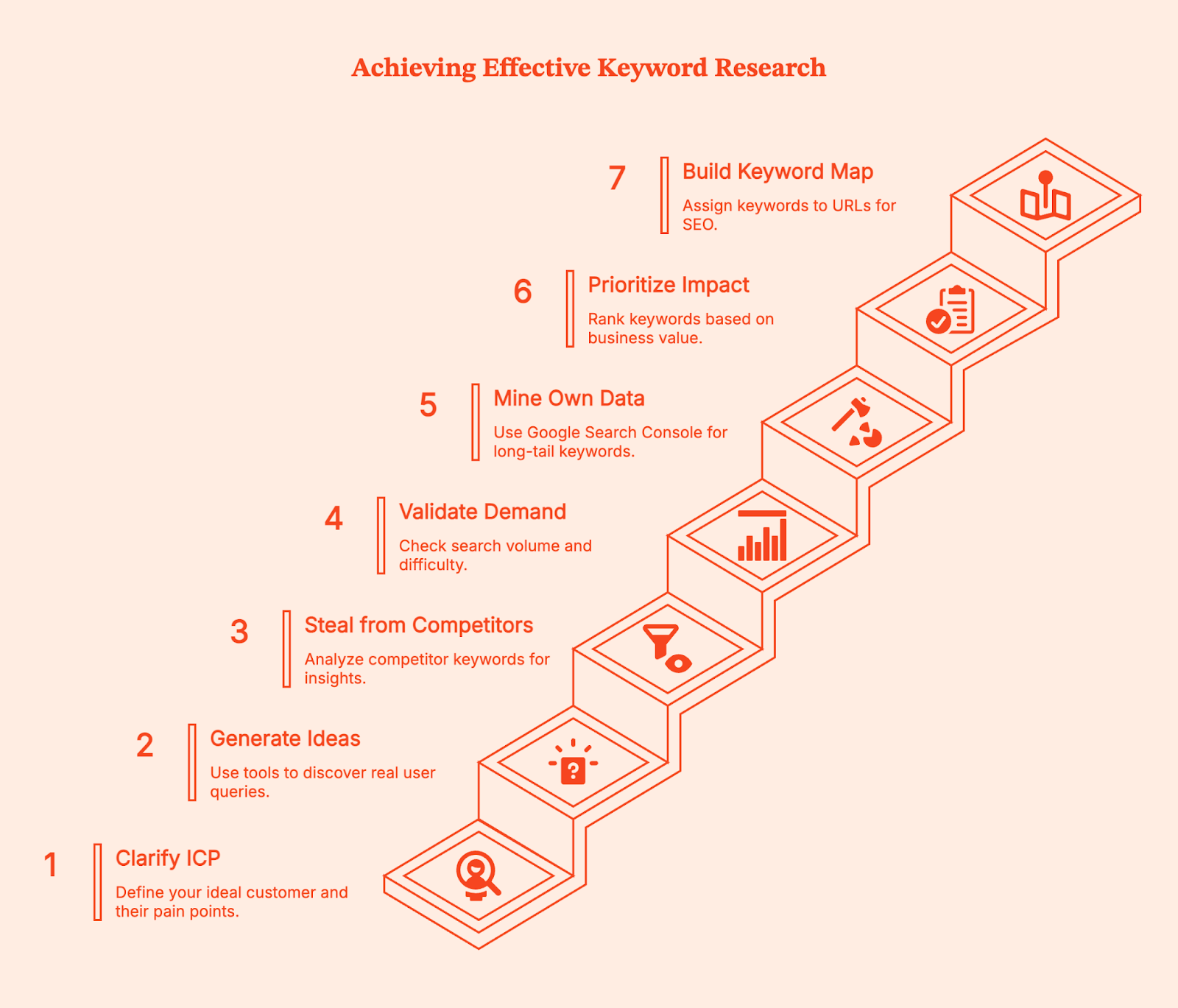
Step 1: Clarify Your ICP and List Seed Keywords
Start by defining the right audience and what specific problems keep them searching at 2 AM.
Your ideal customer profile determines everything downstream. If you run a B2B SaaS tool for accounting firms, your seed keywords might include "audit automation," "tax workflow management," and "client portal software."
Write out 5-7 pain points your customers face, then turn each into phrases related to your niche. Don't overthink this step with formal buyer personas. Just list the actual terms your customers use when describing their problems.
Step 2: Generate Keyword Ideas from Autocomplete and PAA Tools
Feed your seed topics into question mining tools to discover what real people actually ask. Start with a platform like Soovle to aggregate autocomplete suggestions across multiple search engines.
You could also use AlsoAsked, AnswerThePublic, and KeywordsPeopleUse to mine People Also Ask (PAA) questions. For "audit automation," you might discover "can audit automation integrate with QuickBooks" or "what tasks can audit automation handle."
Using your Google Ads account, set your Google Keyword Planner location to the United States to ensure you're getting US-specific volume data. These questions become content angles that align with search intent.
Step 3: Steal from Competitors (Systematically)
Drop 3-5 top competitors into a keyword research tool and harvest content gaps and competitors keywords.
Go to Ahrefs Site Explorer or Semrush's Organic Research tool.
Enter a competitor's domain, then filter their organic keywords by question modifiers (who, what, where, when, why, how). Sort by traffic to find their top ranking pages.

We consistently recommend competitor mining as it reveals proven keywords that already drive organic traffic. You're not copying their content but rather identifying validated search demand.
Redditors on the r/SEO subreddit often mention competitor research as the fastest way to generate keywords.

Step 4: Validate Demand and Difficulty
Check potential keywords for monthly search volume, keyword difficulty (KD), and SERP composition before committing to create content.
Use Ahrefs Keywords Explorer to see if your target keywords actually get searches in the US market. As a general rule, a keyword with 10 monthly searches isn't worth targeting unless it's extremely high-intent.
Look at KD scores (Ahrefs calculates these based on backlinks needed to rank), but more importantly, manually review the SERP. If you see forums, old sites, or thin content ranking in positions 3-7, that's a signal you can compete.
You can also read through Google's SEO Starter Guide which emphasizes matching content type to search intent over chasing vanity metrics.
Step 5: Mine Your Own Data for Long-Tail Gold
Use Google Search Console (GSC) with regex patterns to surface longer queries that already bring you traffic.
Open Search Console, go to Performance > Search Results, click "New" under Queries, then select "Custom (regex)."
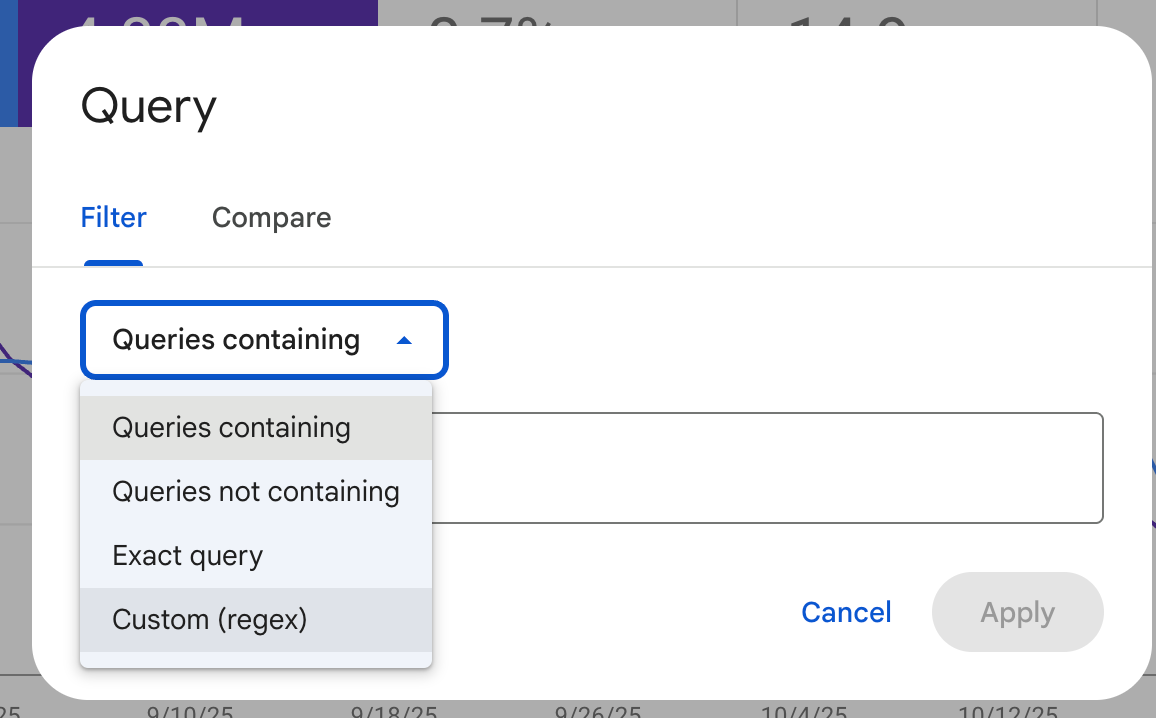
Enter the pattern .{25,} to filter for queries with 25 or more characters. This regex technique reveals the specific phrases people use to find your content.
You might discover "how to automate recurring invoices in accounting software for small businesses" brings 5 clicks per month at position 12. That's an easy optimization win where you can create dedicated content to capture more targeted traffic or optimize existing blog articles to capture that intent.
For B2B companies, layer in behavioral intelligence from your target accounts. If you're running account-based marketing, platforms like Factors show which companies visit your site, what relevant topics they engage with, and where they spend time. This reveals interest in a particular topic that search volume data can't capture.
Step 6: Prioritize for Business Impact
Rank keywords by "pain proximity" (how close they are to your solution), achievable KD, and internal link support you can provide.
Not all new keywords deserve equal effort. Create a simple scoring system: high commercial intent (ready to buy) = 3 points, medium intent (comparing options) = 2 points, low intent (learning) = 1 point. Then factor in whether you can realistically rank.
A KD of 30 with 200 monthly searches beats a KD of 65 with 2,000 searches if you're working with limited domain authority. Consider which existing pages can link to your new content, as strong internal linking from related pages makes ranking easier.
“Internal linking is one of those underrated SEO strategies that quietly does the heavy lifting for your website. It’s about connecting pages, but also about helping search engines and users better understand your site. When done correctly, internal links can enhance crawlability, improve your search engine rankings, and boost your topical authority.” – Edwin Toonen on the Yoast blog
Step 7: Build Your Keyword Map
Assign one primary keyword per URL, cluster related secondary terms around it, and map content types to search intent. Open a spreadsheet and start assigning keywords to pages. Each row represents one URL on your site.

For instance, your homepage might target "construction project management software." A feature page could target "time tracking for construction crews."
You can also use Backlinko's keyword mapping methodology where you group semantically related keywords under one primary term.
If you have "best time tracking apps for contractors," "contractor time tracking software," and "construction crew time management" all ranking for similar results, put them on one page as primary/secondary targets instead of creating three competing pages.
Create Your 'Keywords Plan' Sheet
Your keyword plan should live in a spreadsheet with specific columns that guide initial research and content creation.
Here’s a Google sheet you can duplicate to get started with your tracking.
SEO Tracking Spreadsheet Template
If you prefer setting up manually, here are the 13 columns you need along with the values they can have.
Keyword, Intent (Informational/Commercial/Navigational/Transactional), US Volume (from Keyword Planner), Keyword Difficulty, CPC (to gauge commercial value), Priority (1-3 ranking), Funnel Stage (Awareness/Consideration/Decision), Page Type (Guide/Product/Category/Comparison), Primary or Secondary designation, PAA Questions to Answer, Target URL, Internal Link Opportunities, and Notes.
For example, a row might look like:
- Keyword: "best accounting software for nonprofits"
- Intent: Commercial
- US Volume: 320
- KD: 42
- CPC: $18
- Priority: 1
- Stage: Consideration
- Page Type: Comparison Guide
- Primary/Secondary: Primary
- PAA: "Does QuickBooks work for nonprofits?" / "What accounting software do 501c3s use?"
- Target URL: /accounting-software-nonprofits
- Internal Links: Blog post on nonprofit bookkeeping, Nonprofit resources hub
- Notes: Competitor X ranks with thin content, opportunity to outrank
This format keeps your research organized and makes it simple to hand off to writers who need clear guidance on what to create.
Keyword Best Practices for Marketing Strategy
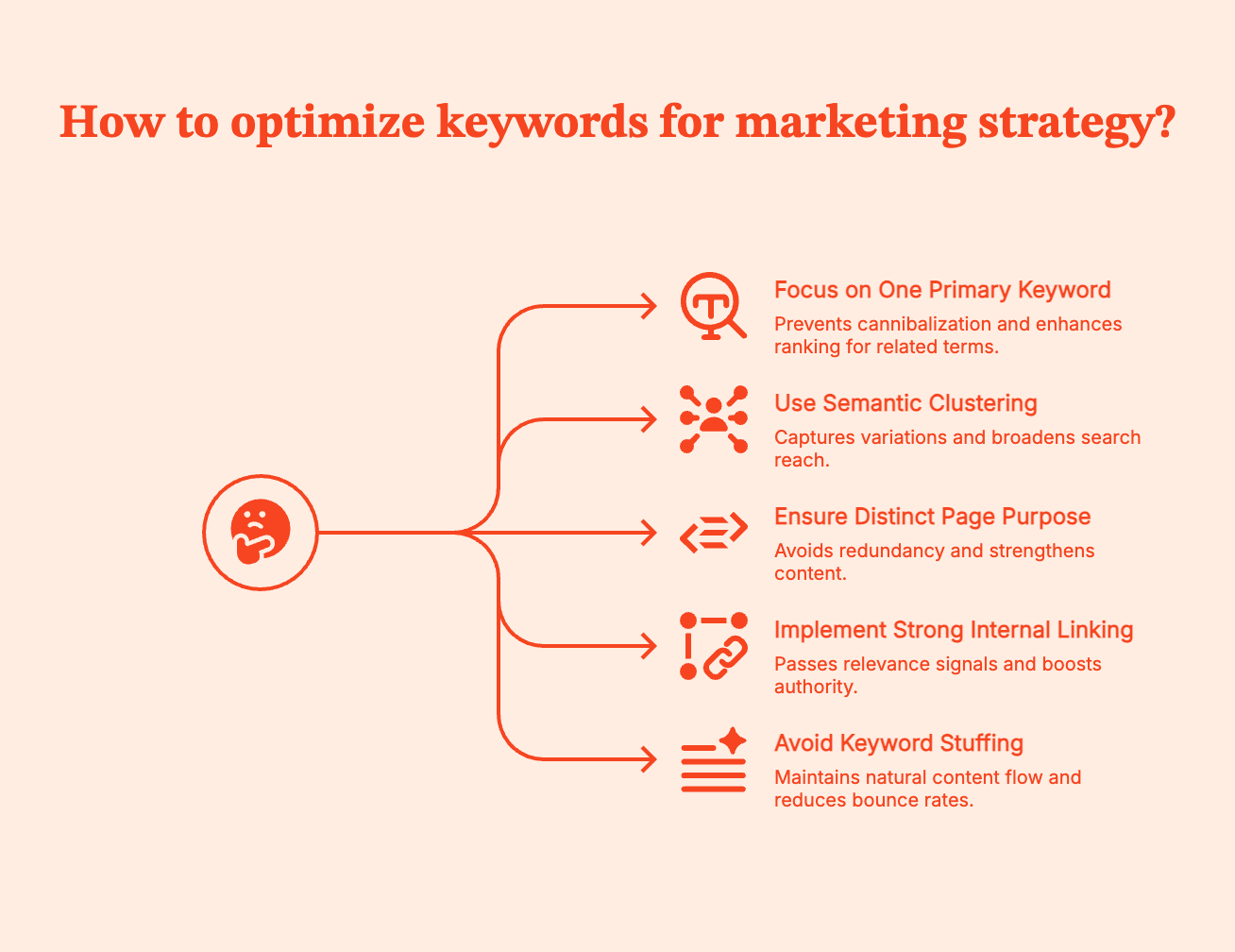
One primary keyword per page prevents cannibalization, while semantic clustering captures related search variations.
According to Ahrefs' research data, pages that rank for their target keyword also rank for an average of 1,000+ related terms. This happens when you build comprehensive content around one primary focus. Your title tag, H1, and URL should all contain your primary keyword naturally. Your H2 and H3 subheadings can target secondary keywords and PAA questions.
Each page needs a distinct purpose. If you have two pages targeting nearly identical keywords, consolidate them to make a stronger piece.
You also need strong internal linking from high-authority pages to newer content using keyword-rich anchor text. For example, when you write "check out our guide to construction project management" and link those words to your target page, you're passing relevance signals.
And no matter how tempting it may seem, avoid the old-school SEO tactics.
- Don't stuff keywords unnaturally into your copy (targeting a 2-3% keyword density is outdated advice).
- Don't hide keywords in white text or behind images. Google's guidelines are clear: write for humans first, optimize for search engines second.
- If your content reads awkwardly because you forced keywords into every sentence, you'll see high bounce rates even if you rank temporarily.
Free and Paid SEO Tools
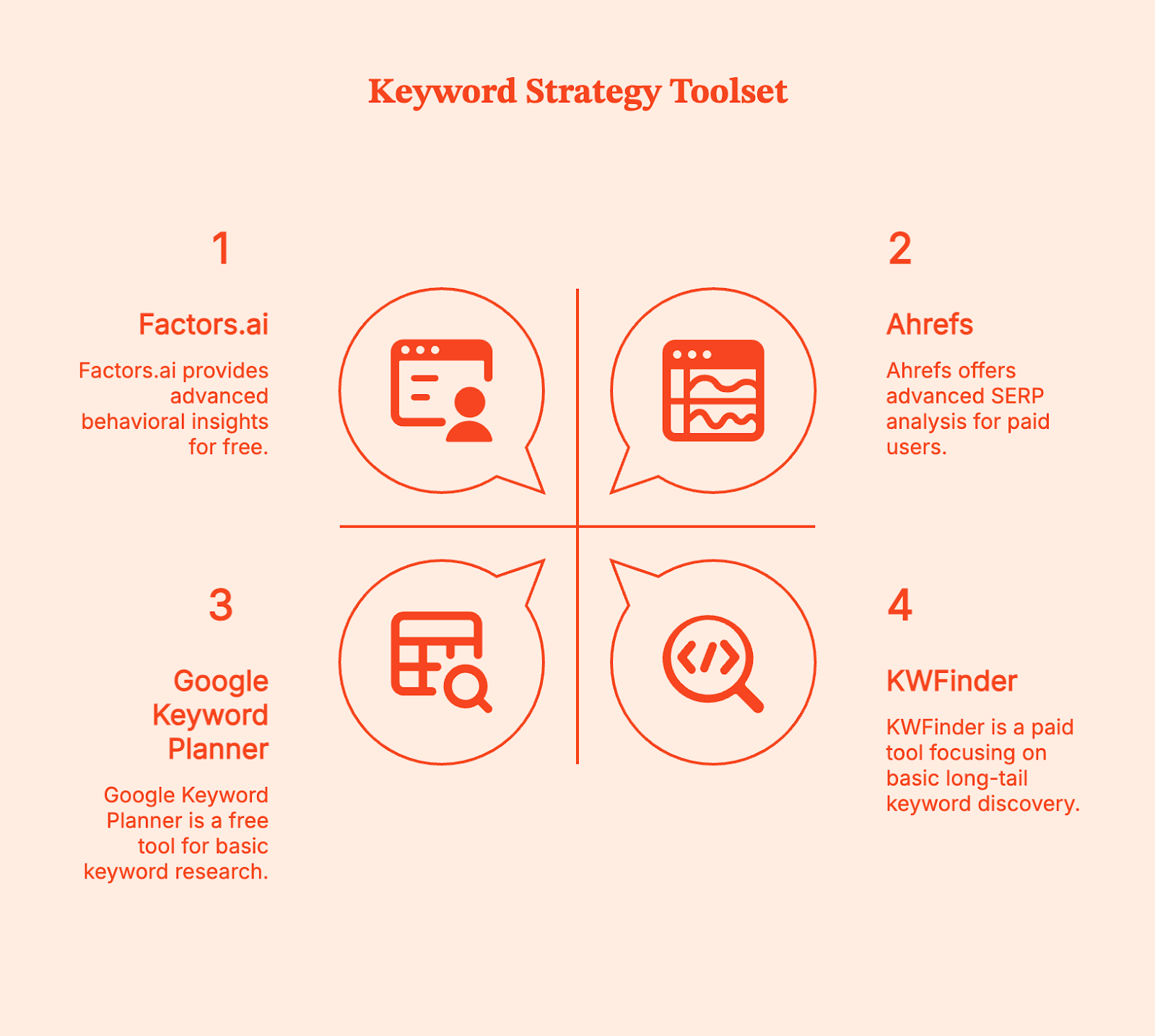
Start with free tools to validate your niche, then invest in paid platforms when you're ready to scale competitor analysis.
Free Tools
- Google Keyword Planner (set location to United States for accurate volumes)
- AnswerThePublic limited free searches
- Answer Socrates for question-based discovery
You can export data from these tools and build your initial keyword list without spending anything.
Paid Tools
- Ahrefs ($129/month) and Semrush ($199/month) provide keyword difficulty scores, SERP analysis, and competitor gap reports.
- KWFinder from Mangools ($43.85/month) focuses specifically on long-tail discovery with an interface built for finding low-competition terms.
These platforms aggregate billions of keywords and show you which ones competitors rank for but you don't, making the investment worthwhile when you're producing content regularly.
Account Intelligence for B2B Keyword Strategy
For B2B companies running account-based strategies, Factors.ai adds a behavioral layer that traditional keyword tools miss. While Ahrefs tells you search volumes, Factors shows which target accounts actually engage with specific content topics on your site. This reveals keyword opportunities based on real buyer behavior rather than just search data.
Factors identifies anonymous website visitors at the company level, tracks their content engagement patterns, and connects this to your CRM and ad platforms.
When you see that multiple high-value accounts repeatedly visit content about "SOC 2 compliance automation" but spend minimal time on "unique features," that's a signal to create more content around the specific compliance angle, even if search volumes look similar.
Common Pitfalls of Keyword Research
Keyword research fails when people optimize for the wrong signals or create overlapping content without a map. Here are some of the most common mistakes:
- Chasing volume over intent is the most common mistake. A keyword with 10,000 monthly searches looks attractive until you realize it's informational ("what is project management") and your product page won't rank because Google shows definitions and guides in those results. Always check the actual SERP before committing.
- Duplicating primary keywords across multiple pages creates keyword cannibalization where your own content competes with itself. Without a keyword map, you might have three blog posts all targeting "best time tracking software" in slightly different ways. Google doesn't know which to rank, so none rank well.
- Ignoring SERP features costs opportunities. If your target keyword triggers a People Also Ask box and a Featured Snippet, you need to structure your content to capture those. Use clear H2 questions and provide direct answers in the following paragraph.
- Not localizing to US search behavior when you're targeting US customers leads to volume miscalculations. Always set your keyword tool location filters appropriately.
- Keyword stuffing and hidden text still happen, usually with AI-generated content that someone didn't edit. Google penalizes these tactics, and they make your content unreadable to actual humans who might convert.
FAQs
Q: What is an SEO keyword?
A: An SEO keyword is a word or phrase people enter into search engines, chosen by website owners based on search volume, competition level, and intent during keyword research to optimize their content.
Q: How do I search for long-tail keywords in a niche?
A: Use PAA mining tools like AlsoAsked, AnswerThePublic, and Soovle for autocomplete suggestions. Run competitor domains through Ahrefs to find keyword ideas they rank for, and use GSC regex (.{25,}) to surface 25+ character queries your site already gets.
Q: What's a good 'low-competition' signal?
A: Check SERP quality first. If you see forums, outdated sites with thin content, or low domain authority pages in positions 3-7, that signals an opportunity. Ahrefs' keyword difficulty under 30 is generally achievable for newer sites, but manual SERP inspection matters more than the number. Look for an intent match where the ranking content type aligns with what you plan to create.
Q: How many primary keywords per page?
A: Typically one primary keyword per URL, supplemented with semantically related secondary terms. This prevents keyword cannibalization, where multiple pages compete for the same rankings. Use a keyword map to track which page owns which primary term.
Q: What is keyword mapping?
A: Keyword mapping assigns specific target keywords to individual pages on your site, reflecting your site structure and preventing overlap. You organize keywords into clusters around primary terms, then map each cluster to one URL with supporting secondary keywords.
Q: What is 'keyword optimization'?
A: Keyword optimization is placing selected keywords strategically in high-value page elements (title tags, H1, H2, body copy, URLs, image alt text) while maintaining natural readability and matching user search intent. It's an ongoing process of refinement based on performance data.
Q: Which free tools should I start with for US data?
A: Google Keyword Planner (set location to United States) for volume estimates, AnswerThePublic for question discovery (3 free searches daily), Answer Socrates for additional PAA questions, and Soovle for autocomplete across multiple search engines.

How to Check Competitor Website Traffic: Tools, Benchmarks & Keyword Wins
You might think you know what a competitor’s SEO strategy looks like. But are you really going to market on gut feel alone?
Sure, if you had an unlimited budget, you could afford to guess. Most of us don’t.
When you’re working with near-zero budgets and million-dollar growth targets, assumptions get expensive fast. What you actually need is real data on which content formats bring in visitors before you spend a single rupee.
That visibility comes from analyzing competitor website traffic.
The only catch is, you cannot access their first-party data through Google Analytics or Search Console.
So, let’s talk about the next best method to find competitor website traffic and keywords so you can compete for them on the SERPs.
What tools do you need for Competitor Website Traffic Analysis?
Before jumping into competitor analysis, you need the right website traffic analysis tools. Here’s a quick list of the free and paid ones you can use based on what your budget is and how deep you want to go into your analysis.
Free Tools for Quick Checks and Analysis
- Similarweb Website Traffic Checker provides directional visits, traffic sources, and country breakdowns with five free daily comparisons.
- Semrush Website Traffic Checker offers 10 free traffic reports per month showing estimated traffic, channel mix, and accuracy scores.
- Neil Patel's Ubersuggest gives limited daily searches for traffic estimates and top keywords.
These free options work well for occasional competitor checks or when you're just starting to build competitive intelligence.
But when you need comprehensive website traffic data across multiple competitors with historical data tracking, premium tools become worthwhile investments.
Paid Tools for Deeper Analysis
Semrush Traffic Analytics + Market Explorer compares traffic share, audience overlap, and growth velocity across five domains. Key features include the Growth Quadrant showing who's gaining or losing position. According to Semrush's documentation, their clickstream data covers over 200 million users.
- Ahrefs Site Explorer excels at organic search intelligence with traffic estimates, top pages, and traffic share by domains. Ahrefs updates hourly, making it reliable for tracking recent ranking changes and gaining a competitive advantage over slower-moving competitors.
- Semrush paid plans are powerful and offer additional features, such asquite powerful and offer additional features, like Semrush Trends, advertising research, social media tracker, and more.
- SE Ranking provides organic and paid breakdowns with geographicgeography distribution. Their AI algorithm adjusts click-through rates based on SERP features.
- SpyFu specializes in PPC intelligence with budgets, paid keyword history, and ad copy variations. SpyFu tracks 15+ years of historical data, revealing seasonal patterns and campaign trends.
Step-by-Step: How to Check Competitor Traffic
Running a one-time competitor check gives you a snapshot. Building a repeatable process gives you actionable traffic insightstraffic insights you can act on. The workflow below helps you move from curiosity about competitor traffic to actionable insights that plug directly into your content marketing calendar and paid campaigns.
1. Build Your Competitor List
Track both direct competitors (same products, same audience) and search competitors (ranking for your keywords).
Semrush Organic Research helps you expand beyond obvious rivals by showing sites competing for the same organic keywords.
Your direct competitor might be another project management tool, but your search competitor could be a productivity blog ranking for "how to organize team tasks." Both steal potential customers at different funnel stages. And you need to pay attention to both.
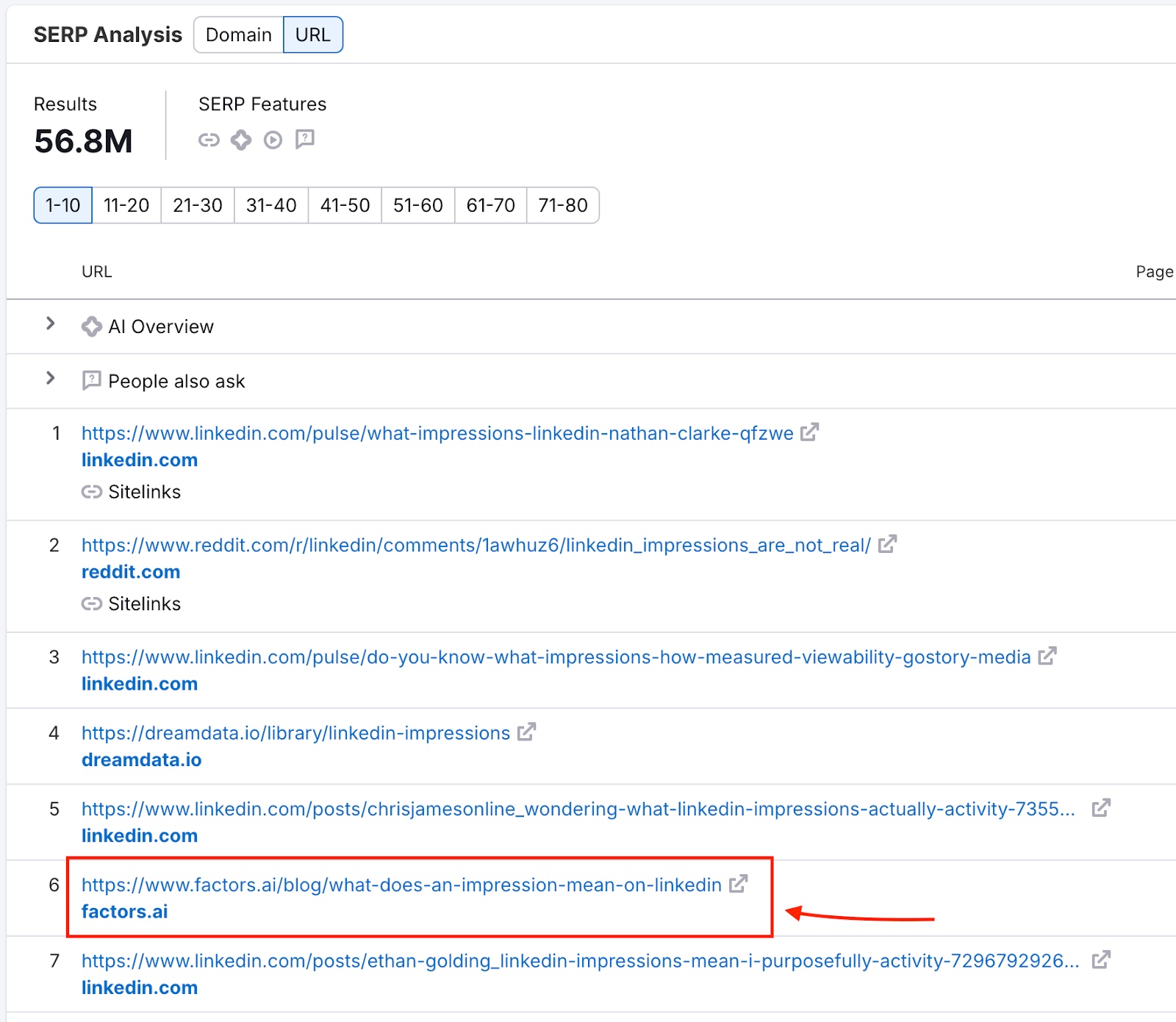
Both steal potential customers at different funnel stages. And you need to pay attention to both.
Here’s how you could go about it:
- Start by listing 3-5 companies you know that you know are compete for the same deals.
- Enter your domain in Semrush, navigate to Organic Research > Competitors, and you'll discover 2-3 sites you never considered.
- Pay attention to competitors with 30-50% keyword overlap. A CRM might compete with a sales automation tool and a lead generation guide for "sales pipeline management."
2. Get Traffic & Channel Mix
Pull up each competitor in Similarweb or Semrush. Then, note estimated monthly visits (US-filtered), channel split (organic, paid, direct, referral, social), and three-month traffic patterns.

Channel mix reveals resource allocation.
- Competitor A shows 150k monthly visits: 65% organic, 15% paid.
- Competitor B shows 180k visits: 35% organic, 45% paid.
Despite similar traffic, they run different SEO playbooks.
In this above case Competitor A has built an SEO moat while Competitor B relies on paid acquisition with higher customer costs and ad platform vulnerability.
3. Benchmark Share & Growth
Semrush Market Overview shows traffic share percentages and positions competitors in a Growth Quadrant: "Game Changers" (high growth, rising share), "Leaders" (high share, stable), or declining players.
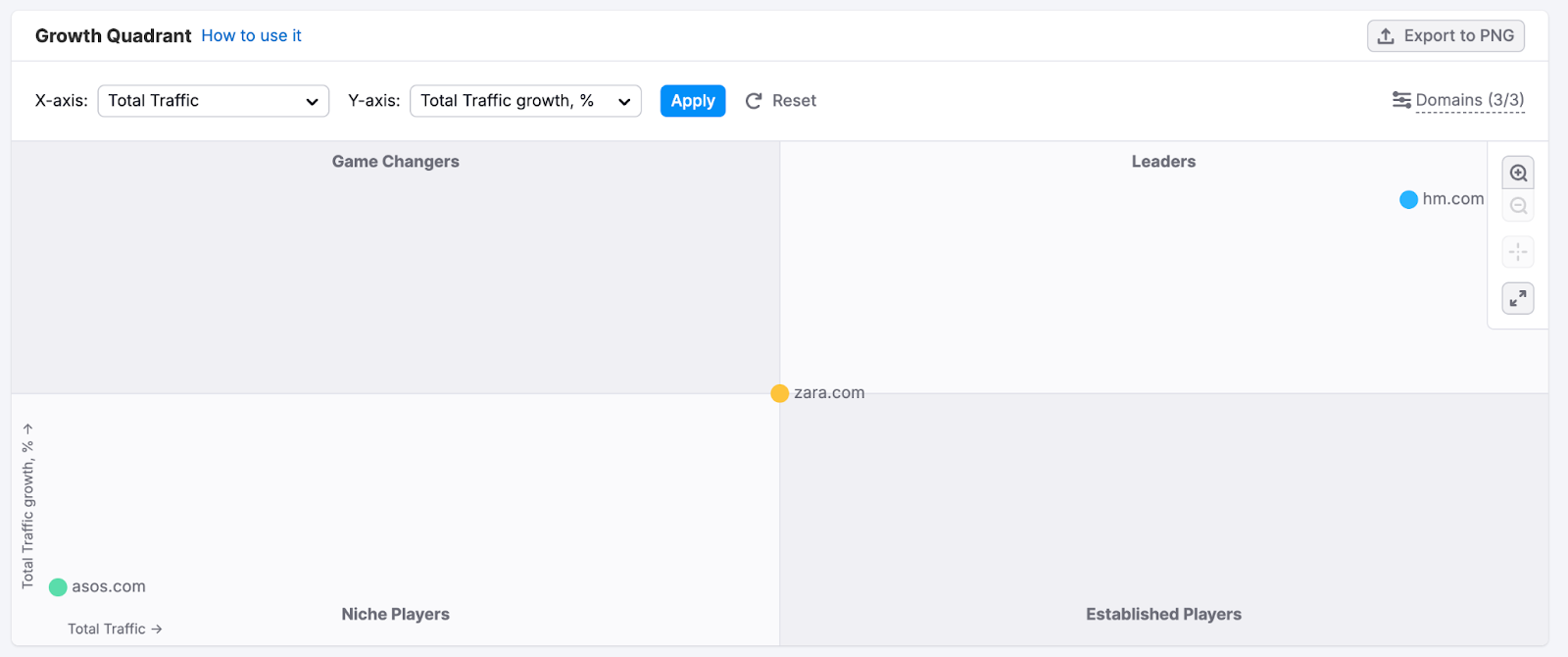
For instance, you may celebrate 100k monthly visits while competitors capture 500k each. Then you discover the total addressable search volume sits at 5M monthly searches. You're fighting for 2% market share while three competitors own 10% each. That 70% unclaimed territory represents your real opportunity for gaining a competitive edge.
4. Identify Top Pages
Semrush Traffic Pages shows which URLs drive the most visits. The question you want to be asking is, does your competitor dominate with comparison pages, long-form guides, or product landing pages?

Go through 10-20 SERP competitors and look for repeatable content patterns. For instance, if 60% of your competitors have “A vs. B” comparison pages ranking in the top 10 and you don’t, that’s a clear gap you need to fill.
5. Monitor Changes
Set weekly snapshots in your chosen tool. For example, a tool like Visualping alerts you when competitor pages update.
You can create a simple tracking dashboard for the same. Every Monday:
- Log each competitor's total traffic, top 5 ranking changes, and new content published.
- Watch for sudden traffic spikes.
- Check Google Trends for the target keyword.
- Flat trend means they improved the content.
- A rising trend means they caught a wave.
Also set up Visualping to track their pricing page, features page, and main landing page. Pricing changes often precede major campaigns. New feature launches reveal product roadmap priorities.
When three competitors simultaneously increase paid spend, industry competition is heating up. When all reduce content output, that's your window to dominate organic search.
Going from Competitor Traffic to Competitor Keywords and Beyond
Traffic numbers tell you what. Keywords tell you the how.
Knowing a competitor gets 500k monthly website visitors means little until you understand which search terms and paid campaigns actually drive those visitors. So let’s look at the extraction process.
Organic Keyword Extraction
Semrush Organic Research shows every term competitors rank for, with position, search volume, difficulty, and traffic share. Filter for positions 1-10 with volume above 500 to surface their money keywords. Keyword Gap reveals shared keywords (you both rank, they outrank you), missing keywords (they rank, you don't), and weak keywords (you rank outside the top 20).
Ahrefs Site Explorer takes a page-level approach. Click any top page to see its organic keywords and traffic drivers. The "Traffic share by domains" report shows which competitors own visibility for specific keyword clusters.
Organic keyword research reveals what content attracts searchers. Paid keywords reveal where competitors invest actual budget, making them more reliable indicators of what actually converts.
PPC Competitor Keywords
SpyFu shows every keyword competitors bid on, estimated CPC, monthly spend, and ad copy variations. SpyFu's Kombat tool reveals keywords multiple competitors bid on for strong conversion signals. According to Directive Consulting, keyword overlap identifies high-value terms validated by competitor budgets.
Semrush Advertising Research and Ahrefs Paid Keywords show search ads copy, landing pages, and spend trends. Google Ads Keyword Planner offers free keyword discovery. Just enter a competitor's domain under "Discover new keywords."
Build Your Tracking Dashboard
Raw website traffic data doesn't help without organization.
Create a spreadsheet with these columns: Domain, US Visits (est.), Traffic Share %, Channel Mix, Top Pages, Top Organic Keywords, Top Paid Keywords, Change vs Last Month %, and Notes. Populate monthly to spot patterns like paid plan budget shifts, new content hubs, or post-redesign traffic drops.
Accuracy Expectations
According to Reddit practitioners, estimates vary across tools. SpyFu's accuracy sits around 85-90% for US keyword data. Ahrefs acknowledges its data is "approximated for relative performance."
Absolute numbers fluctuate between tools, and trends remain consistent. Low-traffic sites have wider error margins; high-traffic sites generate more accurate estimates. Focus on share of voice rather than raw visits. Whether you own 15% or 45% of search visibility matters more than exact category size.
What External Tools Can't Show
You'll never see exact Google Analytics data, conversion rates, or real user behavior metrics. Email and app traffic stay largely invisible. MonsterInsights confirms: "First-party data gives exact numbers only for properties you control. Third-party tools provide estimates."
While these tools excel at tracking Google search visibility and organic rankings, they can't reveal what happens after visitors land on your competitor's site. You won't see bounce rates, time on page, or which pages drive conversions. For your own site's performance analysis, combine competitor traffic tools with Search Console data for complete visibility.
Turn Competitor Traffic Into Your Content Strategy
Checking competitor traffic shows what's already working in your market. With that data, you're simply gathering validated strategies, then building better ones or filling in overlooked gaps.
To get started, pick one competitor and run them through Similarweb for traffic overview, Semrush for market share and top pages and organic keyword gaps. Export their top 20 ranking keywords and compare against your rankings. You'll typically find 5-10 terms where you could rank and haven't created content yet.
That's your roadmap. For paid campaigns, download their SpyFu keywords and filter for consistent monthly spend (conversion signals). Then test a few keywords in your campaigns with lower bids, tracking performance against existing keywords.
Set monthly check-ins to find traffic share changes, content launches, and ranking shifts. When a competitor gains 20% more organic traffic, investigate what changed. New content hub, site speed improvements, fresh backlinks. Learn from their wins while avoiding their losses.
Web traffic analysis works because it proves what converts in your market. Your competitors already ran the experiments and validated the demand. You just need to analyze the results and execute better. Combine these website traffic checker insights with other tools like Google Analytics and Search Console for your own properties to build complete market intelligence.
Frequently Asked Questions
Q: How can I see how much traffic a website gets?
A: Similarweb or Semrush provides directional estimates for understanding growth patterns and channel mix. Adding Ahrefs reveals organic keyword data and top pages. Treat numbers as trends, not exact figures. Cross-referencing multiple tools improves accuracy.
Q: What's the most accurate way to check traffic?
A: No external view matches internal analytics. Reddit practitioners recommend combining Semrush, Ahrefs, and Similarweb while validating with keyword rankings and backlink signals. When three tools show 25-35% growth, trust the trend even when exact numbers vary.
Q: How do I compare competitors' traffic against mine?
A: Semrush Market Explorer shows traffic share and growth quadrants. Ahrefs Domain Comparison provides side-by-side organic metrics. Both reveal relative positioning better than absolute visit counts.
Q: Which tools show competitors' top pages?
A: Semrush Traffic Analytics and Ahrefs Top Pages surface the highest-traffic URLs with engagement metrics, revealing which content formats drive sustained growth.
Q: How do I find competitors' PPC keywords?
A: SpyFu provides paid keyword lists, ad spend estimates, and ad copy history spanning 15+ years. Semrush Advertising Research and Ahrefs Paid Keywords also surface active terms and landing pages.
Q: Any free ways to get competitors' keywords?
A: Google Ads Keyword Planner offers zero-cost discovery. Navigate to "Discover new keywords" and enter a competitor domain. Ubersuggest provides limited free daily searches.
.jpg)
Factors.ai vs Gojiberry: Best AI GTM Tool for Scalable Revenue
If you’ve ever been in a GTM meeting where five dashboards are open, three people are talking at once, and someone says,
“Okay but… what actually moved pipeline this month?”… you already know where this is going.
Website traffic is up.
LinkedIn replies look decent.
Sales says conversations feel “warmer.”
CRM data is… let’s not talk about the CRM.
And yet, nobody can confidently answer whether any of this activity will turn into revenue, or if we’re all just professionally busy (and traumatized).
This is usually the moment teams start Googling things like “AI GTM tools”, “intent data platforms”, or “something that makes this mess make sense.”
That’s where Factors.ai and Gojiberry tend to show up in the same shortlist.
At first glance, they feel similar. Both talk about intent. Both use AI agents. Both promise to help your GTM team move faster and catch buying signals before competitors do. On paper, it looks like you’re choosing between two flavours of the same solution… except one sounds like an exotic ice-cream flavour… (I’m obviously talking about Factors.ai… what did you think?!)
Okay, let’s get back… now, once you get past the landing pages and into how these tools actually work day-to-day, the difference becomes pretty obvious.
Gojiberry is built for LinkedIn-led outbound. It monitors signals such as role changes, funding announcements, and competitor engagement, then helps sales teams jump into conversations while the lead is still scrolling.
Factors.ai looks at the chaos and says, “Cool, but buyers don’t live on one channel.” It pulls intent from your website, ads, CRM, product usage, and platforms like G2, then connects all of it into one journey… so marketing, sales, and RevOps are finally looking at the same story.
So this isn’t really a debate about which tool is ‘better.’
It’s about whether your GTM motion is:
- starting conversations fast, or
- building a system that turns signals into predictable revenue
If you’re trying to decide between Factors.ai and Gojiberry, this guide breaks down how they actually behave in the wild… what they’re great at, where they stop helping, and which kind of GTM team they’re built for. Get the full ‘scoop’ here (or a double-scoop?).
Let’s get into it.
TL;DR
- Gojiberry is ideal for LinkedIn-centric sales teams needing fast, affordable outreach automation. It’s built for startups and outbound-heavy workflows with minimal setup.
- Factors.ai delivers multi-source intent capture, full-funnel analytics, ad activation, and enterprise-ready compliance, best for scaling teams needing structure and visibility across GTM.
- Analytics is where they split: Gojiberry tracks replies and leads; Factors.ai attributes pipeline to campaigns, stages, and signals.
- Choose Gojiberry if your GTM motion lives in LinkedIn DMs.
- Choose Factors.ai if you want to operationalize a full-stack GTM engine.
Factors.ai vs Gojiberry: Functionality and Features
When evaluating GTM platforms, the first question most teams ask is: what can this tool actually do for me? On the surface, both Factors.ai and Gojiberry are intent-led tools, but their depth of functionality reveals very different approaches.
Most intent-led platforms stop at visibility. They’ll tell you who’s out there, but the heavy lifting of turning those signals into pipeline still falls on your team. The real differentiator is not just what you see, but what you can do once you’ve seen it. This is where Factors.ai and Gojiberry diverge.
Factors.ai vs Gojiberry: Functionality and Features Comparison Table
Factors.ai Functionality and Features

Factors.ai positions itself as more than just a signal-capturing tool, it’s an orchestration engine. Instead of feeding you raw data, it structures the entire buyer journey and enables activation at every step.
Key capabilities include:
- Multi-Source Intent Capture: Pulls data from website visits, ad clicks, CRM stages, product usage, and review platforms like G2.
- Visitor Identification: Identifies up to 75% of anonymous visitors using multi-source enrichment (Clearbit, 6sense, Demandbase, etc.).
- Customer Journey Timelines: Creates unified timelines that map every touchpoint across channels into a single, coherent story.
- AI-Powered Agents: Handle account scoring, surface buying groups, suggest next best actions, and even support multi-threaded outreach strategies.
- Ad Platform Integrations: Native sync with LinkedIn and Google Ads lets you activate intent signals in real time.
- Real-Time Alerts: Sends high-context Slack notifications for critical moments (e.g., demo revisit, pricing page view, form drop-off).
In short, Factors.ai highlights your warmest leads and guides you on the following steps to maximize their potential.
Gojiberry Functionality and Features

Gojiberry takes a narrower, but highly focused approach. Instead of multi-channel orchestration, it goes deep into LinkedIn as the single source of truth for GTM signals.
Key capabilities include:
- LinkedIn Signal Tracking: Monitors 10+ LinkedIn intent signals such as competitor engagement, funding rounds, new roles, and content interactions.
- Always-On AI Agents: Run 24/7 to spot new leads that match your ICP and surface them before competitors do.
- Automated Outreach: Launches personalized LinkedIn campaigns at scale, reducing manual prospecting effort.
- Performance Metrics: Provides weekly counts of new leads, reply rates, and campaign-level results.
- Integrations: Syncs with Slack for real-time notifications and connects with CRMs like HubSpot and Pipedrive.
Where Factors.ai orchestrates multiple channels, Gojiberry specializes in making LinkedIn-led outbound as efficient as possible.
Factors.ai vs Gojiberry: Verdict on Functionality and Features
Gojiberry shines when your GTM motion is LinkedIn-first and you need a fast, efficient way to identify warm prospects and automate outreach. It’s focused, lightweight, and designed for outbound-heavy teams.
Factors.ai, on the other hand, extends far beyond lead discovery. By combining multi-source intent signals, unified customer journeys, and AI-driven orchestration, it functions as a true GTM command center. Instead of just finding leads, it equips your team to nurture, activate, and convert them across the funnel.
In short:
- Gojiberry = LinkedIn discovery & outreach tool.
- Factors.ai = full-funnel GTM orchestration platform.
Factors.ai vs Gojiberry: Pricing
Pricing is often where teams start their evaluation, but it’s also where many make the mistake of comparing numbers instead of value per dollar. A lower monthly fee doesn’t necessarily translate into cost efficiency if the tool requires you to buy multiple add-ons or still leaves gaps in your GTM motion.
Both Factors.ai and Gojiberry take very different approaches to pricing, reflective of the problems they aim to solve.
Factors.ai vs Gojiberry: Pricing Comparison Table
Factors.ai Pricing

Factors.ai is not just another point tool; it is a platform, and that philosophy is reflected in its pricing.
- Factors.ai offers a free plan with limited features.
- Moving on, even the base package includes capabilities that typically require multiple point tools stitched together:
- Visitor identification with up to 75%+ accuracy using waterfall enrichment (Clearbit, 6sense, Demandbase).
- Contact enrichment via integrations (Apollo, ZoomInfo, Clay).
- CRM sync & account scoring based on ICP fit, funnel stage, and engagement intensity.
- AI agents that research accounts, surface contacts, generate outreach insights, and support multi-threading.
- Slack alerts triggered by high-intent actions.
- Native ad activation on LinkedIn and Google Ads (with audience sync and conversion feedback).
- Full-funnel analytics & attribution dashboards to tie activity to pipeline and revenue.
- Optional GTM Engineering Services
For teams with limited RevOps bandwidth, Factors offers a service layer at an additional cost. This includes:- Custom ICP modeling and playbook design.
- Set up enrichment, alerts, and ad activation workflows.
- SDR enablement: post-meeting alerts, closed-lost reactivation, and buying group mapping.
- Ongoing reviews, optimization, and documentation of the GTM motion.
Takeaway: While Factors.ai’s entry point is higher, the scope is significantly broader. Instead of buying a visitor ID tool, a LinkedIn retargeting tool, a separate attribution platform, and an enrichment service, you get it all in one system. The additional GTM Engineering Services make Factors not just a tool, but an extension of your team.
Read more about the pricing tiers.
Gojiberry Pricing

Gojiberry keeps things straightforward with a seat-based model.
- Pro Plan - $99/month per seat
Designed for startups, founders, and lean sales teams looking for predictable pipeline through LinkedIn-led outbound. It includes:- Tracking of 15+ LinkedIn intent signals (e.g., funding rounds, competitor engagement, role changes, event activity).
- Connection of one LinkedIn account.
- Running of unlimited LinkedIn campaigns.
- AI-powered outreach with basic lead scoring.
- CRM & API integrations (HubSpot, Pipedrive, etc.).
- 100 verified emails included per month.
- Elite Plan - Custom Pricing
Built for scaling teams needing more seats and deeper integrations. It includes everything in Pro, plus:- Tracking of unlimited intent signals.
- A dedicated Customer Success Manager (CSM).
- SLA guarantees for support and uptime.
- Support for +10 additional seats.
- Deeper integrations across the stack.
- Higher volumes of phone and email credits.
Takeaway: Gojiberry’s pricing is attractive to small teams looking for affordability and ease of entry. But its value is tied closely to LinkedIn-based workflows. If your GTM play relies on multi-channel activation (ads, website, CRM, product signals), you’ll need to supplement it with additional tools.
Factors.ai vd Gojiberry: Verdict on Pricing
If you’re an early-stage startup or a lean sales team, Gojiberry offers a low-cost, low-barrier entry into AI-driven LinkedIn outreach. For $99/month per seat, you can uncover warm signals and start conversations quickly.
But if you’re evaluating true cost vs. value, Factors.ai offers more ROI at scale. At $416/month, you consolidate multiple workflows, visitor ID, enrichment, ad sync, analytics, and attribution, into one platform. Plus, with GTM Engineering Services, you’re not just buying software; you’re investing in an operating system for revenue.
In short:
- Gojiberry = affordable outreach assistant.
- Factors.ai = GTM platform that scales with you.
Factors.ai vs Gojiberry: Analytics and Attribution
Seeing who’s engaging is one thing. Proving which efforts actually drive pipeline and revenue is another. This is where Factors.ai and Gojiberry diverge sharply.
Factors.ai vs Gojiberry: Analytics and Attribution Comparison Table
Factors.ai Analytics and Attribution

Factors.ai was built from the ground up as a full-funnel analytics and attribution platform. Instead of stopping at replies or meetings booked, it connects every touchpoint to pipeline outcomes.
Key analytics capabilities include:
- Multi-Touch Attribution
- Stitch together interactions across web, ads, product usage, CRM, and G2.
- Attribute pipeline and revenue back to specific channels and campaigns.
- Answer questions like: “Did LinkedIn or Google Ads influence this deal more?”
- Funnel Stage Analytics
- Track movement from MQL → SQL → Opportunity → Closed Won.
- Identify which campaigns or signals accelerate progression, and where drop-offs happen.
- Customer Journey Timelines
- Unified, chronological view of every action an account has taken.
- See how anonymous visits, ad clicks, demos, and nurture campaigns map into deals.
- Segmentation & Custom Dashboards
- Break down performance by geography, ICP fit, industry, product line, or segment.
- Compare campaigns across personas or buyer stages.
- Drop-Off & Bottleneck Detection
- Visualize where accounts fall out of the funnel.
- Spot “silent churn” signals like demo visits with no follow-up.
- AI-Powered Insights (coming soon)
- Ask natural language questions like: “Which campaign influenced the most revenue last quarter?” without digging through dashboards.
With Factors, analytics aren’t just about visibility, they’re about actionable GTM strategy.
Gojiberry Analytics and Attribution

Gojiberry’s analytics stay close to its core use case: LinkedIn-led outreach. The platform is optimized to show you which signals and campaigns generated responses, and how your outreach is performing week over week.
Key analytics capabilities include:
- Campaign Performance Metrics
- Reply rates broken down by campaign (e.g., Campaign A: 18%, Campaign B: 27%).
- Weekly counts of leads generated and replies received.
- Signal-Level Insights
- See which LinkedIn triggers (competitor engagement, new funding, new roles, etc.) yielded the most conversations.
- Spot top-performing signals like “Engaged with your competitors” or “Recently raised funds.”
- Basic CRM/Slack Integration Reporting
- Track which signals or campaigns convert into meetings.
- Push lead data into CRM tools for follow-up.
- Real-Time Alerts
- Notifications in Slack when new warm leads are uncovered, with basic context about the signal.
In other words, Gojiberry tells you:
- “This signal is working.”
- “This campaign got replies.”
- “Here are the warm leads to follow up with.”
But what it doesn’t do is tie those interactions to broader GTM outcomes. You won’t see multi-touch attribution, funnel progression, or which channels (beyond LinkedIn) contribute to revenue.
Factors.ai vs Gojiberry: Verdict on Analytics & Attribution
Gojiberry does its job well: it shows you which LinkedIn signals get the most replies, which campaigns are working, and when new warm leads appear. That’s useful for small teams focused on direct outbound outreach.
But if you’re a GTM team looking to justify spend, optimize campaigns, and scale pipeline predictably, Factors.ai is in another league. It gives you the ability to prove which touchpoints created revenue, not just which messages got replies.
In short:
- Gojiberry = outreach analytics.
- Factors.ai = revenue analytics.
Factors.ai vs Gojiberry: Ad Activation and Retargeting
Intent signals are only half the battle. The real question is: how quickly and effectively can your team act on those signals? That’s where the differences between Factors.ai and Gojiberry become clearest.
Factors.ai vs Gojiberry: Ad Activation and Retargeting Comparison Table
Factors.ai Ad Activation and Retargeting
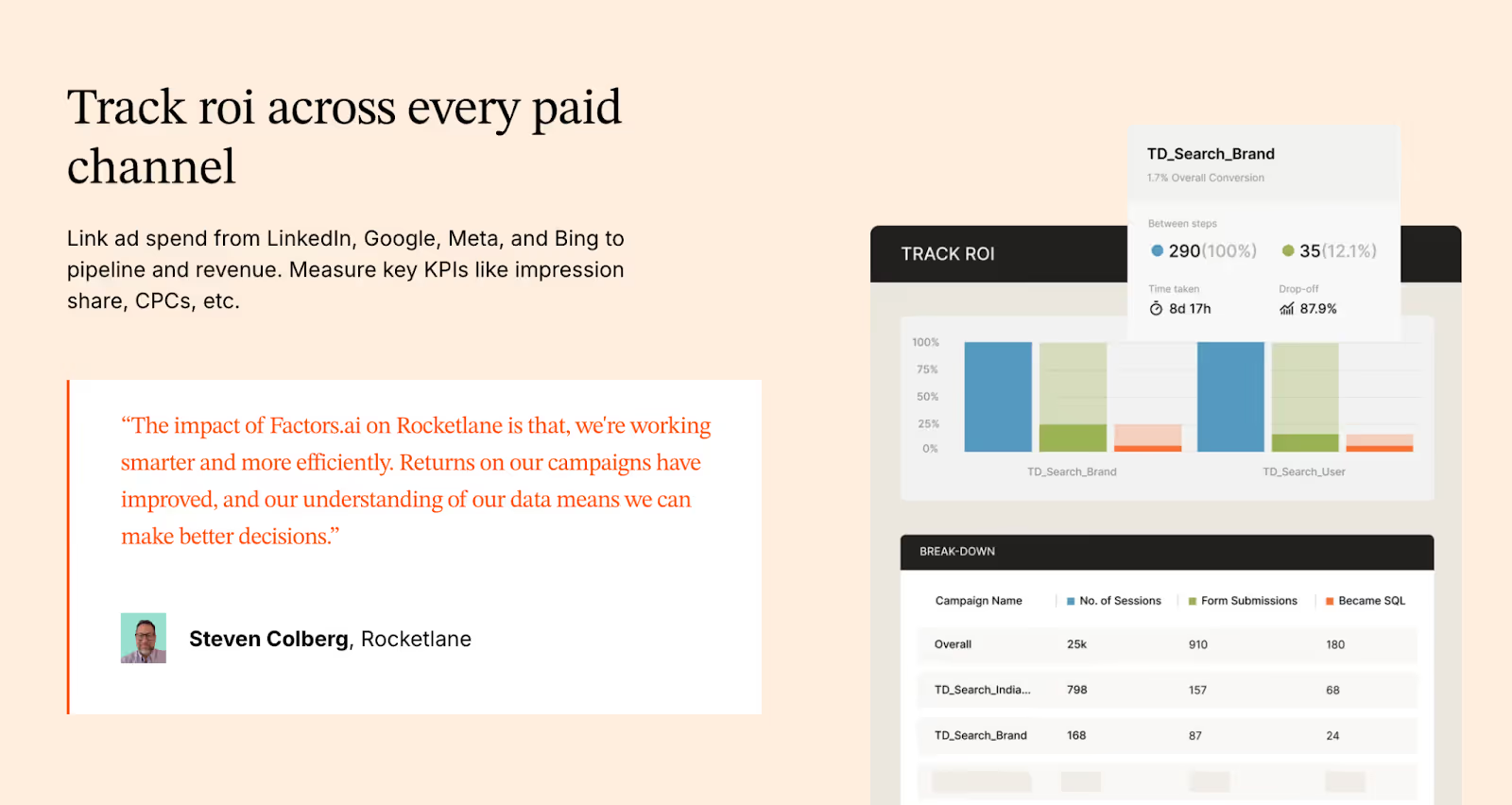
Factors.ai, on the other hand, treats ad activation as a core GTM motion. The platform is an official partner for LinkedIn and Google, which means it doesn’t just tell you who’s ready to buy, it helps you reach them instantly with the right ads.
Key ad activation capabilities include:
- Real-Time LinkedIn Audience Syncs
- Automatically build and refresh audiences based on ICP fit, funnel stage, or recent engagement.
- Keep ad campaigns aligned with buying signals, no more manual CSV uploads.
- Google Ads Integration
- Retarget accounts who’ve clicked high-value terms, visited competitor pages, or engaged with your site.
- Feed conversion data back to Google via CAPI, making every ad impression smarter.
- Conversion Feedback Loops
- If your SDRs mark a lead as high-quality, Factors sends that feedback into LinkedIn and Google Ads.
- This ensures platforms optimize toward the accounts most likely to convert.
- Impression & Budget Control
- Control ad frequency at the account level.
- Avoid overserving a handful of accounts while starving others.
- Cross-Signal Retargeting
- Retarget not just website visitors, but also accounts showing intent via G2, product usage, or CRM activity.
This creates a closed-loop system: intent signals → dynamic audiences → optimized ads → enriched pipeline.
Gojiberry Ad Activation

Gojiberry is designed around LinkedIn outreach automation, not paid media orchestration. Its activation layer is focused on:
- AI-Powered LinkedIn Messaging
- Automatically sends personalized LinkedIn messages to warm leads.
- Templates can be customized, but the workflow is largely centered around direct outreach.
- Slack Notifications
- When new warm leads are discovered, teams get real-time alerts in Slack.
- This ensures SDRs can jump into outreach quickly.
- Basic Campaign Tracking
- Performance measured in reply rates and lead responses.
What Gojiberry does not provide:
- No integration with LinkedIn Ads or Google Ads for audience targeting.
- No dynamic audience syncs.
- No ability to retarget based on multi-source signals (website visits, CRM stage, G2 engagement).
- No feedback loops from sales activity back into ad platforms.
In short, Gojiberry’s “activation” is outreach-only. It’s effective for teams running heavy outbound on LinkedIn, but it doesn’t extend into paid media channels.
Factors.ai vs Gojiberry: Onboarding and Support
A tool is only as effective as your team’s ability to use it. Onboarding and ongoing support are what determine whether software turns into real pipeline impact or just another unused subscription.
Here again, Factors.ai and Gojiberry take very different approaches.
Factors.ai vs Gojiberry: Onboarding and Support Comparison Table
Factors.ai Onboarding and Support
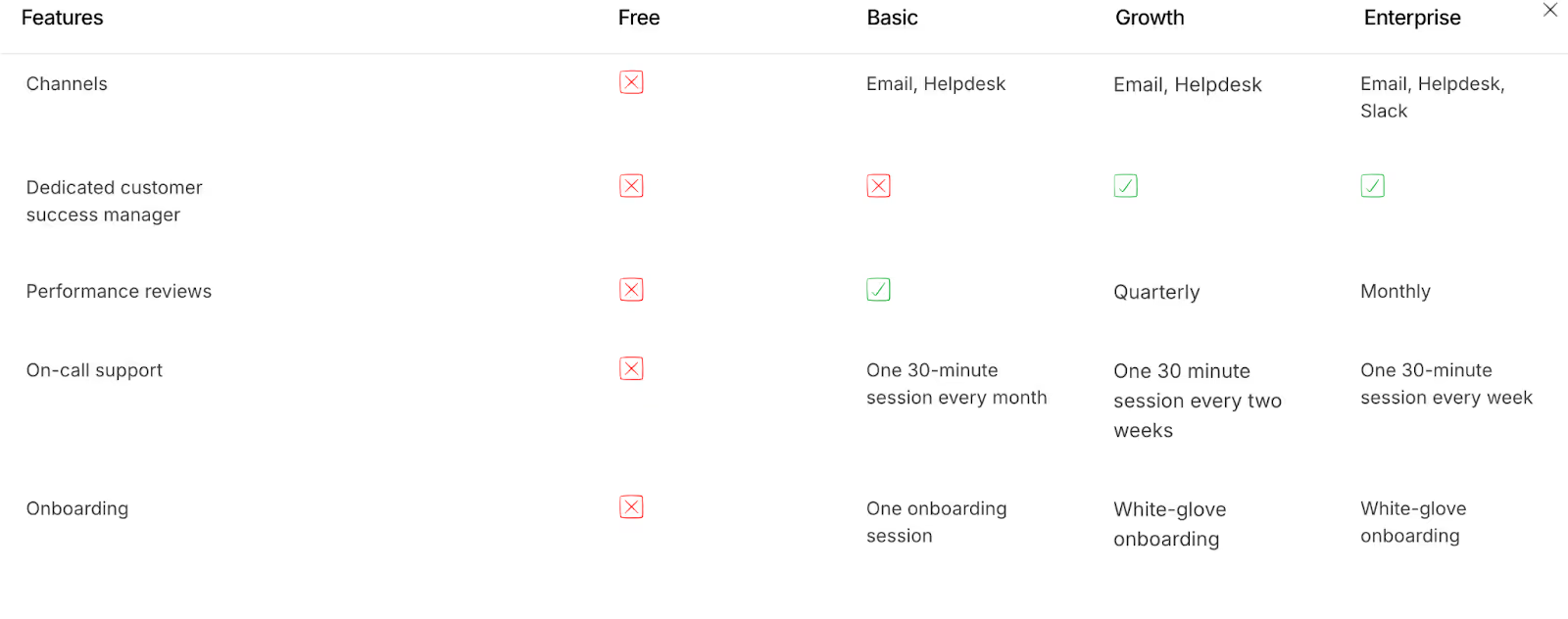
Factors.ai takes a very different approach. Instead of a plug-and-play install, the onboarding is positioned as a partnership to build your GTM motion (can vary based on plans).
Here’s what you get:
- White-Glove Onboarding
- Setup is tailored to your ICP, funnel stages, and sales/marketing workflows.
- No cookie-cutter playbooks; the onboarding aligns Factors to your GTM strategy.
- Dedicated Slack Channel
- Customers get a direct line to their CSM and solutions engineers via Slack.
- This means real-time troubleshooting and collaboration, not waiting for tickets to be resolved.
- Weekly Strategy Reviews
- Regular syncs to review adoption, optimize workflows, and align analytics with business outcomes.
- Goes beyond product training, it’s about pipeline generation strategy.
- GTM Engineering Services (Optional)
- For teams short on RevOps bandwidth, Factors offers services at $4,000 setup + $300/month.
- Includes:
- Automated enrichment flows.
- Ad audience syncs for LinkedIn & Google.
- Real-time SDR alerts (e.g., demo revisits, form drop-offs).
- Closed-lost reactivation workflows.
- Buying group mapping and multi-threading setups.
- Full documentation and handover so your internal team can eventually run independently.
The result is a support model that’s not just about getting the tool working, but about operationalizing a revenue system.
Gojiberry Onboarding and Support

Gojiberry is designed to get you up and running quickly, with minimal friction. The onboarding process is straightforward:
- Simple Account Setup
- Create an account in seconds, connect your LinkedIn profile, and start tracking signals.
- Create an account in seconds, connect your LinkedIn profile, and start tracking signals.
- Quick Activation
- Pick the intent signals you want AI agents to monitor (e.g., funding rounds, new roles, competitor engagement).
- Launch your first LinkedIn outreach campaigns almost immediately.
- Slack Alerts for Warm Leads
- Once configured, your team gets daily Slack notifications with newly discovered warm leads.
In terms of support, Gojiberry provides:
- CRM & API integrations with tools like HubSpot and Pipedrive.
- Email and support documentation for basic setup assistance.
- A dedicated Customer Success Manager (CSM) available only on the Elite plan, along with SLA guarantees for larger customers.
The trade-off? While Gojiberry is fast to set up, the support is primarily tactical. It helps you connect the tool and interpret signal reports, but doesn’t go deep into GTM workflows, sales enablement, or long-term strategy.
Factors.ai vs Gojiberry: Verdict on Onboarding and Support
If you want to start sending LinkedIn messages tomorrow, Gojiberry makes onboarding effortless. Within minutes, you can be tracking signals and automating outreach. For small teams or outbound-heavy founders, this speed is a real advantage.
But if your team needs end-to-end GTM orchestration, Factors.ai is the safer bet. Its onboarding is not just about installing software, it’s about building a sustainable motion. With Slack collaboration, weekly strategy calls, and optional GTM engineering, Factors.ai acts less like a vendor and more like an extension of your GTM team.
In short:
- Gojiberry = fast, tactical onboarding.
- Factors.ai = strategic, long-term GTM partnership.
Factors.ai vs Gojiberry: Compliance and Security
For modern B2B SaaS companies, compliance is not optional. If you’re selling into mid-market or enterprise accounts, your buyers’ procurement teams will scrutinize your data policies, certifications, and security practices before signing a deal.
This is an area where the differences between Factors.ai and Gojiberry become especially clear.
Factors.ai vs Gojiberry: Compliance and Security Comparison Table
Factors.ai Compliance and Security

Factors.ai, by contrast, positions security as a foundational pillar of the platform. For GTM teams selling into enterprise accounts, this assurance is crucial.
Key compliance highlights:
- GDPR & CCPA Compliant
- Ensures compliance with both EU and US data privacy standards.
- Ensures compliance with both EU and US data privacy standards.
- ISO 27001 Certified
- Globally recognized standard for information security management.
- Globally recognized standard for information security management.
- SOC 2 Type II Certified
- Validates the platform’s security, availability, and confidentiality practices via third-party audit.
- Validates the platform’s security, availability, and confidentiality practices via third-party audit.
- Privacy-First Enrichment
- Uses firmographic and behavioral data without invasive user fingerprinting or non-transparent enrichment methods.
- Uses firmographic and behavioral data without invasive user fingerprinting or non-transparent enrichment methods.
- Data Processing Agreements (DPAs)
- Available for customers who require legal documentation for data handling.
This makes Factors.ai not just safe for enterprise buyers, but also procurement-ready. Security reviews that might delay smaller tools often get cleared faster when certifications like SOC 2 and ISO 27001 are already in place.
Gojiberry Compliance and Security
Gojiberry’s website highlights product capabilities, pricing, and integrations, but there’s very little publicly available information about its compliance framework or certifications. Based on what’s shared:
- GDPR and CCPA Alignment
- Gojiberry states alignment with GDPR, ensuring basic data privacy for European users.
- It also mentions compliance with the CCPA, which gives California residents rights over their personal data.
- No Published Certifications
- Gojiberry provides some visibility into data enrichment methods (public sources and third-party services) and outlines security controls (encryption, firewalls, anomaly detection).
- However, it does not disclose storage locations or list industry certifications like SOC 2 or ISO 27001.
- Data Handling Transparency
- Limited visibility into how lead data is enriched or how AI agents process intent signals.
- No publicly available DPA (Data Processing Agreement).
Implication: For smaller startups or early-stage sales teams, this may not be a deal-breaker. But for regulated industries (finance, healthcare, enterprise SaaS), the lack of certifications could raise red flags in security reviews and slow down procurement cycles.
Factors.ai vs Gojiberry: Verdict on Compliance and Security
Gojiberry covers the basics for GDPR compliance, which may be sufficient for smaller startups or founder-led teams experimenting with LinkedIn outreach. But it lacks the certifications and transparency required by enterprise buyers.
Factors.ai, on the other hand, checks every compliance box, from GDPR and CCPA to SOC 2 Type II and ISO 27001. For GTM teams targeting mid-market or enterprise customers, this level of security isn’t just a nice-to-have; it’s table stakes.
In short:
- Gojiberry = startup-friendly, minimal compliance.
- Factors.ai = enterprise-grade security, procurement-ready.
Factors.ai vs Gojiberry: When to choose what?
Both Factors.ai and Gojiberry are AI-powered GTM tools designed to make revenue teams faster, smarter, and more effective. But while they may appear to solve the same problem at a glance, the reality is that they’re optimized for very different GTM motions.
When to Choose What
When Factors.ai Makes Sense
Factors.ai is a better fit if your GTM team is:
- Multi-channel and scaling: You need intent signals from multiple sources (website, ads, CRM, product usage, G2) stitched into one view.
- Focused on revenue, not just replies: You want to connect signals and campaigns directly to pipeline and closed-won deals.
- Running paid media: With LinkedIn and Google Ads integrations, you can activate dynamic audiences in real time and optimize spend.
- Enterprise or mid-market facing: Security certifications (SOC 2, ISO 27001, GDPR, CCPA) make procurement frictionless.
- Resource-constrained on RevOps: With GTM Engineering Services, you can outsource playbook design, workflow automation, and analytics setup.
For scaling GTM teams, Factors.ai is more than just a tool. It’s a GTM operating system, one that identifies, scores, activates, and attributes accounts across the funnel.
When Gojiberry Makes Sense
Gojiberry is a great fit if your team is:
- Small and outbound-heavy: Founders, SDRs, and lean sales teams looking to maximize LinkedIn prospecting.
- Focused on LinkedIn-led workflows: If most of your GTM strategy relies on LinkedIn signals like role changes, funding announcements, and competitor engagement.
- Looking for affordability: At $99/seat/month, Gojiberry makes AI-driven warm lead discovery accessible without a heavy investment.
- Needing quick setup: You can be up and running with LinkedIn outreach campaigns within a day.
For these teams, Gojiberry is an efficient outreach assistant; it finds warm LinkedIn leads and automates messages to help book meetings faster.
In a Nutshell
If you’re an early-stage founder or SDR team whose GTM strategy is almost entirely LinkedIn-driven, Gojiberry is a cost-effective way to find warm leads and automate outreach. It’s lightweight, affordable, and gets you moving fast.
But if you’re looking to scale pipeline predictably, with multi-channel orchestration, enterprise-grade security, and full-funnel analytics, Factors.ai is the clear choice. It doesn’t just help you find leads, it helps you build a connected GTM system that turns signals into revenue.
In short:
- Gojiberry = outreach assistant.
- Factors.ai = revenue engine.
FAQs for Factors vs Gojiberry
Q. What is the main difference between Factors.ai and Gojiberry?
The biggest difference is scope. Gojiberry is built for LinkedIn-led outbound and focuses on spotting warm signals and automating outreach quickly. Factors.ai is designed as a full-funnel GTM platform that unifies intent from your website, ads, CRM, product usage, and third-party sources, then helps you activate and measure that intent across the entire revenue journey.
Q. Is Gojiberry only useful for LinkedIn outreach?
Yes, and that’s intentional. Gojiberry is optimized for LinkedIn workflows, tracking role changes, funding updates, competitor engagement, and content interactions, then turning those signals into outreach. If LinkedIn is the core of your GTM strategy, Gojiberry fits naturally. It’s not built for paid ads, website intent, or multi-channel attribution.
Q. Can Factors.ai replace multiple GTM tools?
In many cases, yes. Factors.ai combines visitor identification, enrichment, account scoring, ad audience sync, attribution, and analytics into one platform. Teams often use it instead of stitching together separate tools for intent data, retargeting, enrichment, and attribution.
Q. Which platform is better for early-stage startups?
Gojiberry is often a better fit for early-stage or founder-led teams running outbound-heavy motions. It’s affordable, quick to set up, and helps teams start conversations fast without a complex RevOps setup. Factors.ai tends to make more sense once teams start scaling and need tighter alignment across sales, marketing, and analytics.
Q. Does Factors.ai support LinkedIn and Google Ads?
Yes. Factors.ai is an official partner for both LinkedIn and Google Ads. It allows real-time audience syncs, conversion feedback loops, and retargeting based on multi-source intent signals, not just website visits.
Q. Can Gojiberry run paid ad campaigns?
No. Gojiberry focuses on outreach automation, not paid media. It does not sync audiences to LinkedIn Ads or Google Ads and does not support retargeting or ad optimization workflows.
Q. How does attribution differ between Factors.ai and Gojiberry?
Gojiberry tracks outreach performance through replies, meetings, and campaign-level engagement. Factors.ai offers full multi-touch attribution, connecting interactions across web, ads, CRM, product, and third-party platforms to pipeline and revenue.
Q. Is Factors.ai suitable for enterprise and mid-market teams?
Yes. Factors.ai is designed for teams selling into mid-market and enterprise accounts. It supports complex GTM motions, multi-channel activation, and enterprise security requirements like SOC 2 Type II and ISO 27001.
Q. What kind of onboarding can I expect with each platform?
Gojiberry offers fast, lightweight onboarding so teams can start outreach quickly. Factors.ai provides white-glove onboarding, Slack-based collaboration, weekly strategy reviews, and optional GTM engineering services to help teams operationalize their GTM motion.
Q. Do both platforms support CRM integrations?
Yes. Both integrate with CRMs like HubSpot and Pipedrive. Factors.ai offers deeper native CRM sync, account scoring, and funnel-stage analytics, while Gojiberry focuses on pushing discovered leads and outreach activity into the CRM.
Q. Which platform should I choose if my GTM strategy evolves over time?
If you expect your GTM motion to stay LinkedIn-first and outbound-heavy, Gojiberry works well. If you expect to add paid media, inbound intent, product-led signals, or need stronger attribution and analytics as you scale, Factors.ai is built to grow with that complexity.

Factors.ai vs Madison Logic: Which ABM Tool Fits Your B2B Team?
If you’ve worked in B2B marketing long enough, you’ve probably sat through that meeting.
The one where marketing says, “Traffic is up.”
Sales says, “Cool, but none of these accounts are replying.”
Someone shares a dashboard. Someone else shares another dashboard.
And by the end of it, everyone agrees to “revisit attribution next quarter.”
I’ve been in those rooms… more times than I’d like to admit.
Intent signals are everywhere today. Website visits, LinkedIn clicks, content downloads, review site activity. The problem isn’t access to data anymore. The problem is figuring out which signals actually mean something… and which ones are just noise wearing a KPI costume.
That’s exactly where platforms like Factors.ai and Madison Logic enter the conversation.
On the surface, they both promise smarter account-based marketing. Identify in-market accounts. Activate campaigns. Prove impact. Tie marketing to revenue. The usual wishlist.
But once you get past the feature lists and sales decks, you realize they’re built for very different kinds of GTM teams, with very different definitions of “what good looks like.”
In this comparison, I’m breaking down how Factors.ai and Madison Logic differ across functionality, pricing, integrations, intent intelligence, activation, analytics, and support, not in theory, but in how they actually show up inside real GTM workflows.
If you’re trying to decide which platform fits your team, your maturity, and your tolerance for duct-taped dashboards… this one’s for you.
Factors.ai vs Madison Logic: Functionality and Features
For most B2B marketers, the real difference between ABM platforms comes down to how much they can actually do: how well they connect intent, engagement, and action.
Both Factors.ai and Madison Logic help teams identify in-market accounts and engage them across channels, but the way they deliver those capabilities reflects two very different philosophies.
Let’s compare their core GTM functionalities side by side.
Factors.ai vs Madison Logic: Functionality and Features Comparison Table
Factors.ai’s Functionality and Features
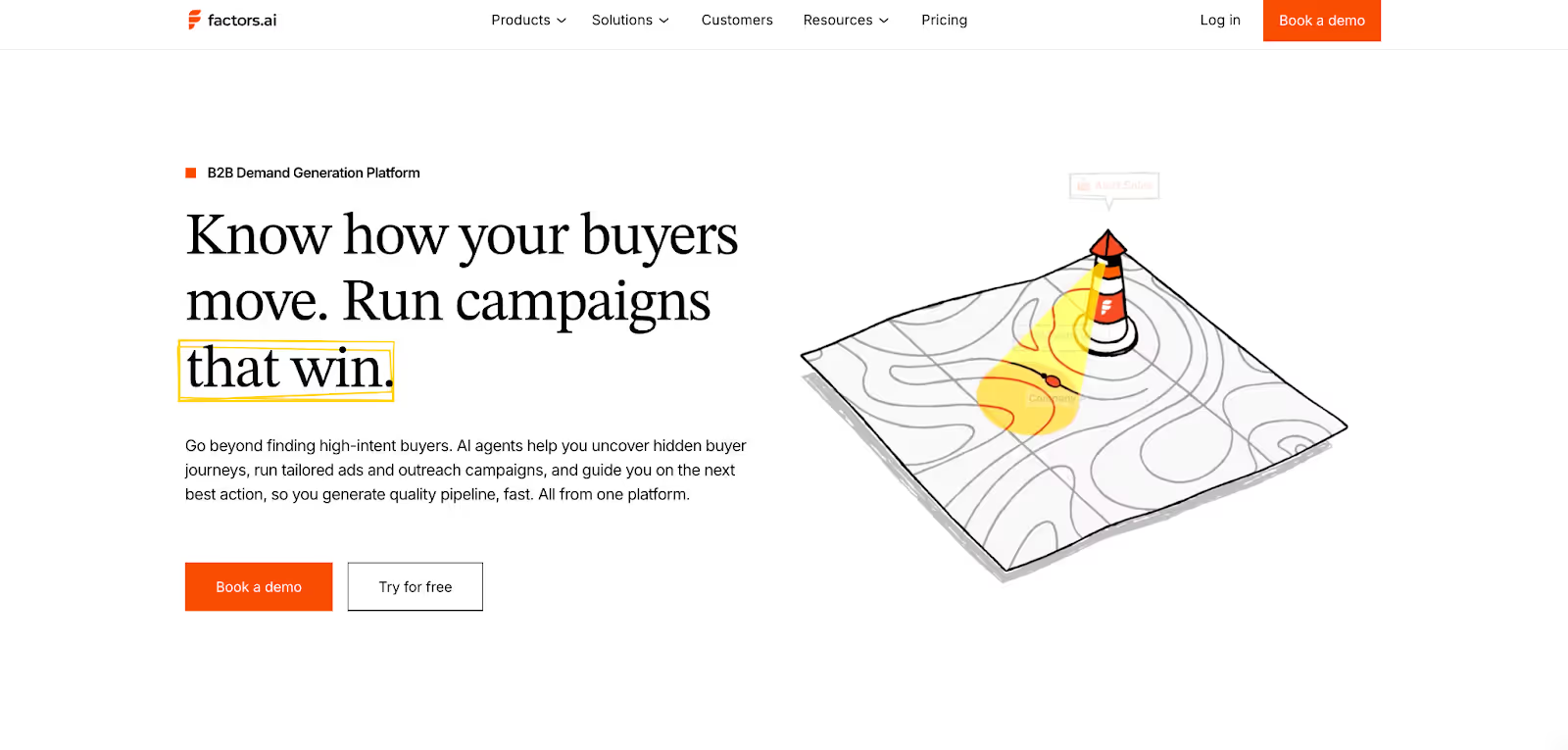
Factors.ai is designed to function as a single GTM command center.
Its strength lies in how it combines account identification, scoring, analytics, and activation under one workflow. The system captures signals across web, CRM, and product interactions, enriching them with external intent data to create a complete account story.
Key capabilities include:
- Account360 to unify engagement data across every channel.
- AI-powered scoring that identifies high-intent, sales-ready accounts.
- Dynamic ad activation via LinkedIn and Google AdPilot.
- Milestones analytics to connect top-of-funnel engagement with pipeline outcomes.
- Real-time AI alerts that prompt timely follow-ups.
For teams seeking both intelligence and activation within one ecosystem, Factors.ai offers an integrated, AI-led experience built for precision and speed.
Madison Logic’s Functionality and Features

Madison Logic has a long-standing presence in the ABM market and remains best known for its multi-channel activation network. Its ML Insights system provides intent-based targeting data that feeds campaigns across display, LinkedIn, and content syndication.
Key capabilities include:
- Account identification through web analytics tied to ML Insights.
- Multi-source intent data combining historical, install, and research signals.
- Cross-channel activation for display, LinkedIn, and other digital touchpoints.
- Pipeline visibility via ML Measurement for engagement and influence tracking.
Madison Logic’s strength lies in its broad ad reach and established ABM ecosystem, though it focuses more on activation scale than on deep analytics or automation.
Factors.ai vs Madison Logic: Verdict on Functionality and Features
Both platforms deliver strong account-based marketing capabilities, but their focus differs.
Factors.ai emphasizes intelligence, automation, and connected data. It gives GTM teams an integrated platform where AI-driven insights lead directly to measurable actions across LinkedIn, Google, and CRM.
Madison Logic focuses on reach and activation, providing a strong multi-channel foundation for teams running large-scale ABM campaigns. It’s effective for advertising breadth but less advanced in automation and journey analytics.
In short:
Factors.ai = Unified GTM intelligence and automation for modern B2B teams.
Madison Logic = Established ABM activation network for large-scale campaign reach.
Factors.ai vs Madison Logic: Pricing
Pricing often reflects more than just numbers and shows how a platform scales with your team.
Factors.ai and Madison Logic take two very different paths here.
While one builds transparency and flexibility into its plans, the other tailors its pricing entirely around enterprise campaigns.
Factors.ai vs Madison Logic: Pricing Comparison Table
Factors.ai Pricing
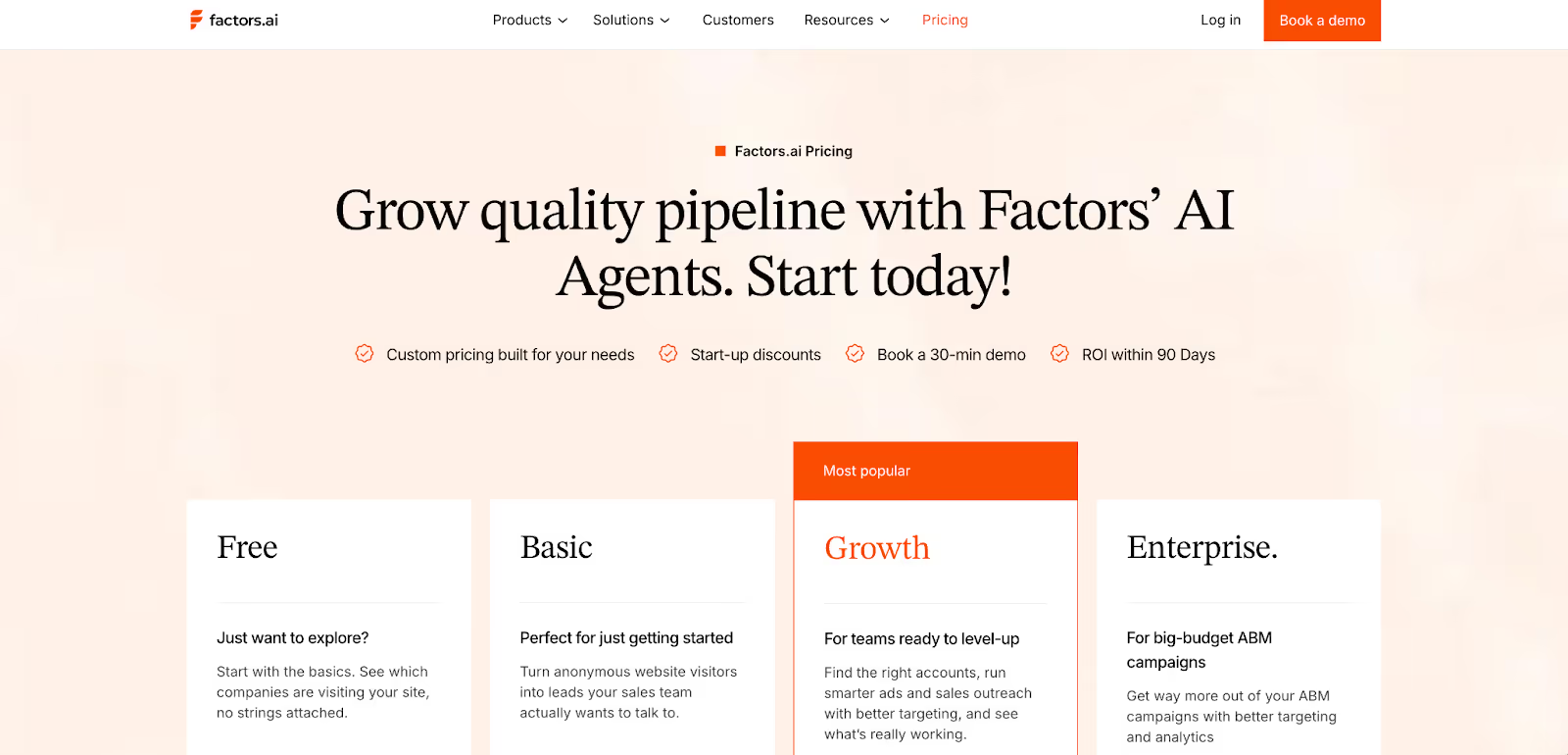
Factors.ai follows a structured, usage-based model designed to grow with your GTM maturity.
Its tiered pricing makes it easy for teams to start small, explore key capabilities, and then expand into deeper analytics and automation without migrating platforms.
Here’s a closer look at each tier:
- Free Plan:
Identify up to 200 companies per month, with 3 seats. Includes company tracking, customer journey timelines, and starter dashboards. Integrates with Slack, and basic website tracking. - Basic Plan:
Identifies 3,000 companies per month with up to 5 seats. Adds LinkedIn intent signals, advanced GTM dashboards, GTM workflows, and helpdesk support. Integrates with major ad and CRM platforms like Google Ads, LinkedIn, Facebook, Bing, HubSpot, and Salesforce. - Growth Plan (Most Popular):
Identifies 8,000 companies per month with up to 10 seats. Adds ABM analytics, LinkedIn attribution, account scoring, G2 intent signals, workflow automation, and a dedicated CSM. Integrates with full HubSpot and Salesforce access, Marketo, G2, and Drift. - Enterprise Plan:
Unlimited company identification with up to 25 seats. Adds predictive account scoring, 50 segments, Milestones analytics, Google and LinkedIn AdPilot, white-glove onboarding, and 300 custom reports. Integrations expand to Segment, Rudderstack, and other custom systems.
This tiered framework gives Factors.ai the advantage of clarity and control, teams always know what they’re paying for and can easily align pricing with their growth stage.
Madison Logic Pricing
Madison Logic takes a custom pricing approach tailored for enterprise ABM execution.
Instead of tiered plans, pricing is determined through sales engagement based on factors like campaign size, ad channels, target regions, and audience volume.
Typical pricing characteristics include:
- No public plans or free trial options.
- Spend-based billing tied to ad campaigns or media budgets.
- Custom quotes that include activation, content syndication, and measurement as bundled services.
- Enterprise focus which is designed for companies running global, full-funnel ABM programs across display, LinkedIn, and content networks.
This structure gives Madison Logic’s enterprise clients flexibility to build large, managed campaigns but limits accessibility for smaller or self-serve teams.
Factors.ai vs Madison Logic: Verdict on Pricing
Both platforms approach pricing with different philosophies aligned to their core audiences.
Factors.ai provides clear, structured tiers for companies that want to scale predictably. Its transparent inclusions and usage-based model make it practical for growing GTM teams that value visibility and control.
Madison Logic positions itself as a service-driven enterprise solution. Its pricing flexibility suits large-scale, high-budget ABM initiatives, but the lack of transparency makes early comparison challenging for mid-market teams.
In short:
Factors.ai = Transparent, tiered pricing that scales with your growth.
Madison Logic = Custom, enterprise pricing built around managed ABM campaigns.
Before you pick a plan, this ABM platform pricing guide helps compare tiered vs enterprise pricing models.
Factors.ai vs Madison Logic: CRM and Data Integrations
How well a GTM platform connects with the rest of your marketing and sales stack defines its real value.
Both Factors.ai and Madison Logic integrate with popular CRMs and MAPs, but the depth of those integrations, and what you can actually do with the synced data, varies significantly.
Factors.ai CRM and Data Integration Comparison Table
Factors.ai’s CRM and Data Integration

Factors.ai was built to unify the GTM stack, not just connect to it.
Its integrations go beyond basic data sync and enable automation, analytics, and cross-platform orchestration.
With real-time bi-directional syncing, all signals from ads, CRM, and web are aligned into a single view through Account360 and Milestones analytics.
Key integration highlights:
- Deep CRM sync: Full integration with HubSpot, Salesforce, and Marketo for both account and deal-level data.
- Cross-channel connectivity: Ad platforms (LinkedIn, Google, Facebook, Bing) and analytics tools (Search Console, G2, Drift).
- MAP/CDP compatibility: Segment and Rudderstack integrations for data enrichment and custom workflows.
- Real-time sync: Two-way updates between marketing, sales, and analytics pipelines.
- Automation-ready architecture: Enables AI Agents to act on CRM changes instantly, from triggering alerts to updating campaigns.
This ecosystem helps GTM teams keep all data, signals, and workflows connected, ensuring marketing and sales always operate on the same insights.
Madison Logic’s CRM and Data Integration
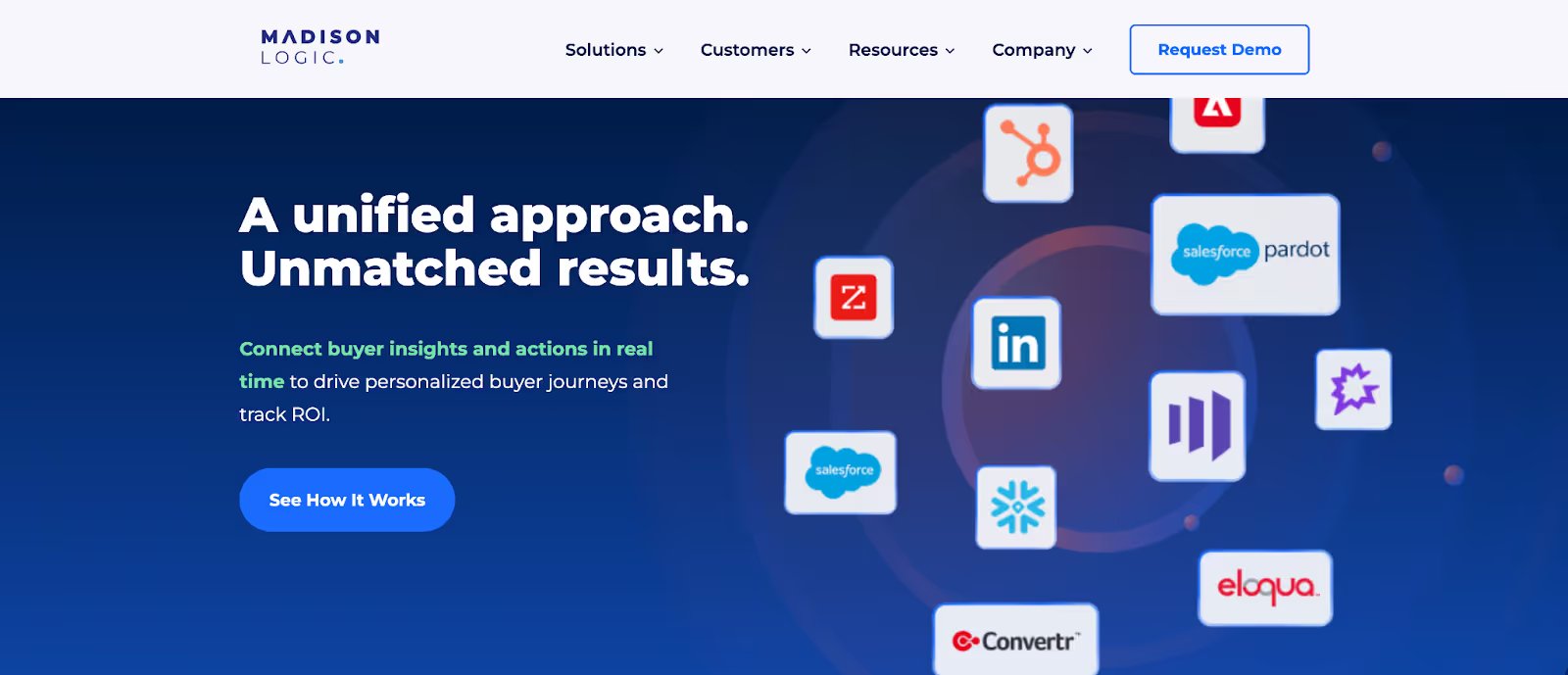
Madison Logic integrates effectively with enterprise-level systems but focuses mainly on campaign alignment and measurement.
Its integrations are designed to connect CRM and marketing data to support its multi-channel activation model rather than unified analytics.
Notable integration traits:
- CRM compatibility: Works with Salesforce, HubSpot, and Marketo to bring in audience and campaign data.
- MAP/Ad alignment: Integrates with platforms like Adobe Experience Cloud and Convertr for activating content syndication and display campaigns.
- Targeting focus: Pulls company data to power ABM lists and custom audiences across display and LinkedIn Ads.
- One-way sync: Data generally moves from CRM or MAP into activation tools for targeting, with limited feedback loops back into the CRM.
While the integrations serve campaign execution well, they lack the analytical and automation depth that GTM teams increasingly expect from unified platforms.
Factors,ai vs Madison Logic: Verdict on CRM and Data Integrations
Both tools integrate with key CRM and marketing platforms, but they serve different operational purposes.
Factors.ai acts as a central data hub, merging inputs from CRM, ads, and analytics to fuel intelligence and automation. Its two-way sync allows teams to use data for both activation and measurement, reducing silos across GTM functions.
Madison Logic connects with similar systems but uses the data primarily for ad targeting and campaign execution, not for dynamic analytics or automation.
In short:
Factors.ai = Deep, bi-directional integrations designed for unified GTM intelligence.
Madison Logic = Practical CRM connectivity built for ABM campaign execution.
Factors.ai vs Madison Logic: Intent Data and Account Intelligence
Intent data is the foundation of any modern GTM strategy.
It helps teams understand which accounts are in-market, what they’re researching, and when they’re most likely to convert.
Both Factors.ai and Madison Logic use intent signals to drive engagement, but the way they collect, analyze, and act on this data differs in depth and flexibility.
Factors.ai vs Madison Logic: Intent Data and Account Intelligence Comparison Table
Factors.ai’s Intent Data and Account Intelligence
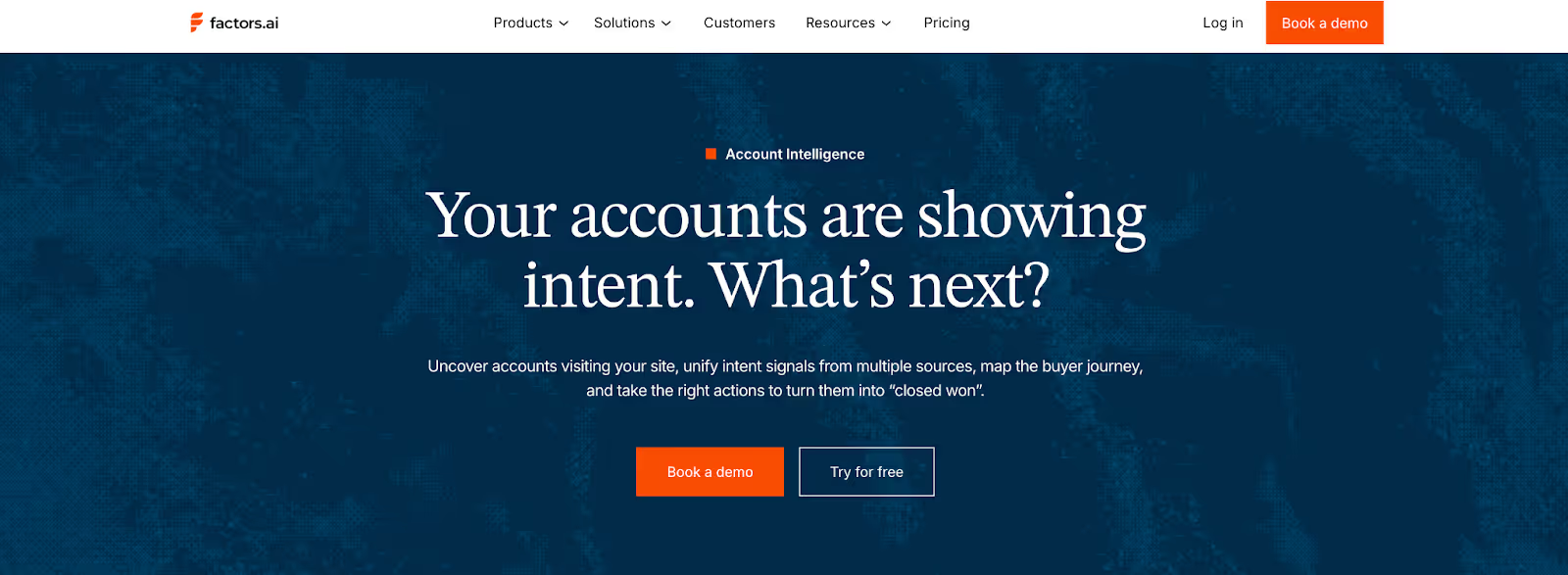
Factors.ai approaches intent data as a connected ecosystem rather than a data feed.
It blends behavioral, engagement, and firmographic signals from across the funnel, then enriches them with external data sources for higher accuracy and actionability.
Key strengths in intent intelligence include:
- Multi-source intent capture: Pulls from website, CRM, ads, and review platforms like G2.
- AI scoring: AI Agents continuously assess signal strength and account readiness.
- Buying group identification: Maps multiple stakeholders interacting from the same company.
- Real-time automation: Triggers alerts, audience updates, or SDR notifications instantly when intent crosses a defined threshold.
- Milestones integration: Links intent to funnel movement, showing which actions advance deals.
This gives GTM teams not just visibility into who’s active, but also insight into how close they are to conversion.
Madison Logic’s Intent Data and Account Intelligence
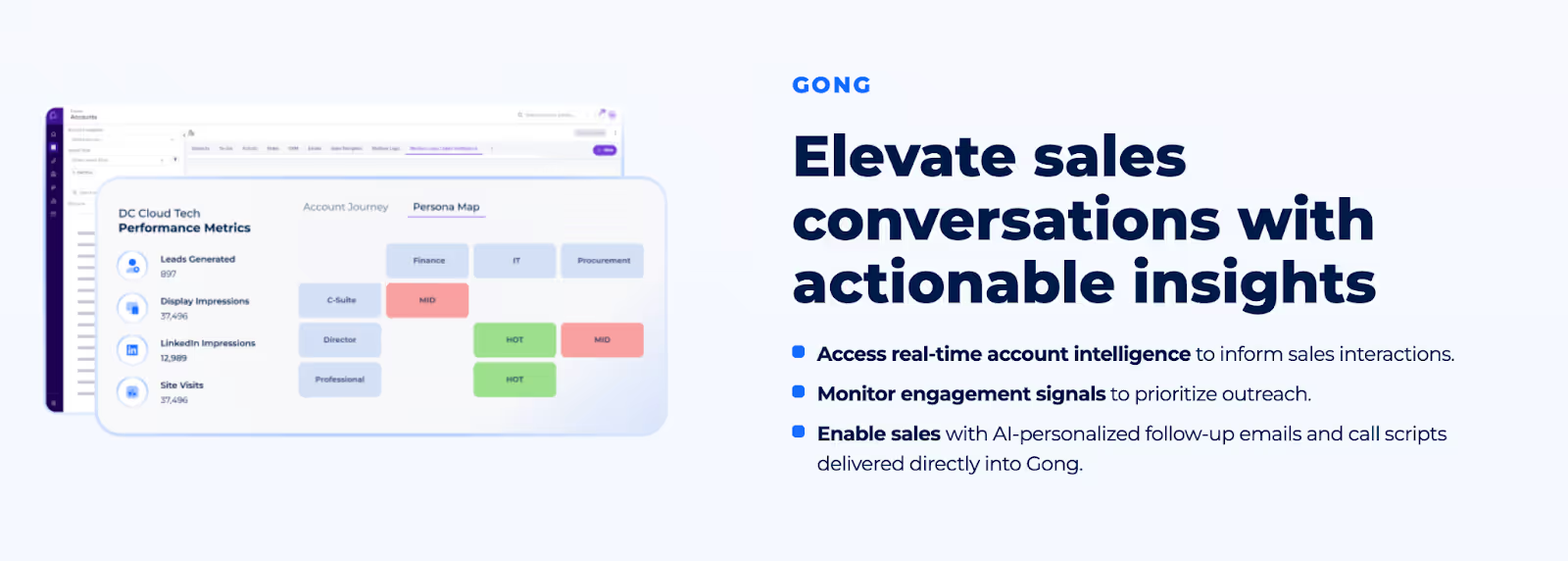
Madison Logic centers its intent capabilities around ML Insights, a proprietary dataset designed to identify in-market accounts and guide ABM targeting.
It combines three data sources including historical performance, install base, and B2B research activity, to determine which accounts are showing relevant buying signals.
Notable features include:
- Historical engagement analysis to find repeat or lookalike accounts.
- Intent-based prioritization for display, LinkedIn, and content syndication campaigns.
- Integration with CRM data for refining audience segments and optimizing campaign targeting.
- ML Measurement for correlating intent data with pipeline influence and deal velocity.
While ML Insights offers broad coverage across industries, it focuses more on reach and campaign readiness than on depth of behavioral intelligence.
Factors.ai vs Madison Logic: Verdict on Intent Data & Account Intelligence
Both platforms give GTM teams the ability to act on buying intent, but they differ in how actionable and dynamic that intelligence is.
Factors.ai provides real-time, AI-driven intent intelligence, combining first-party data with external signals like G2, mapping buying groups, and connecting everything back to pipeline analytics. It turns signals into immediate next steps through alerts and automations.
Madison Logic focuses on aggregated market intent through ML Insights, which works well for large-scale campaigns but offers limited visibility into individual account journeys or multi-contact engagement patterns.
In short:
Factors.ai = Real-time, multi-source intent intelligence designed for activation and analytics.
Madison Logic = Aggregated market intent data optimized for ABM targeting.
If intent is the core of this comparison, you’ll love our post on Buyer Intent for ABM as it shows how to turn signals into sales-ready actions.
Factors.ai vs Madison Logic: Ad Activation and Orchestration
Even the best intent data means little if it doesn’t translate into effective activation.
That’s why the ability to sync audiences, launch contextual ads, and orchestrate campaigns across multiple platforms has become a defining feature of modern GTM stacks.
Both Factors.ai and Madison Logic offer ad activation features, but their depth, automation, and cross-platform coordination vary sharply.
Factors.ai vs Madison Logic: Ad Activation and Orchestration Comparison Table
Factors.ai Ad Activation and Orchestration
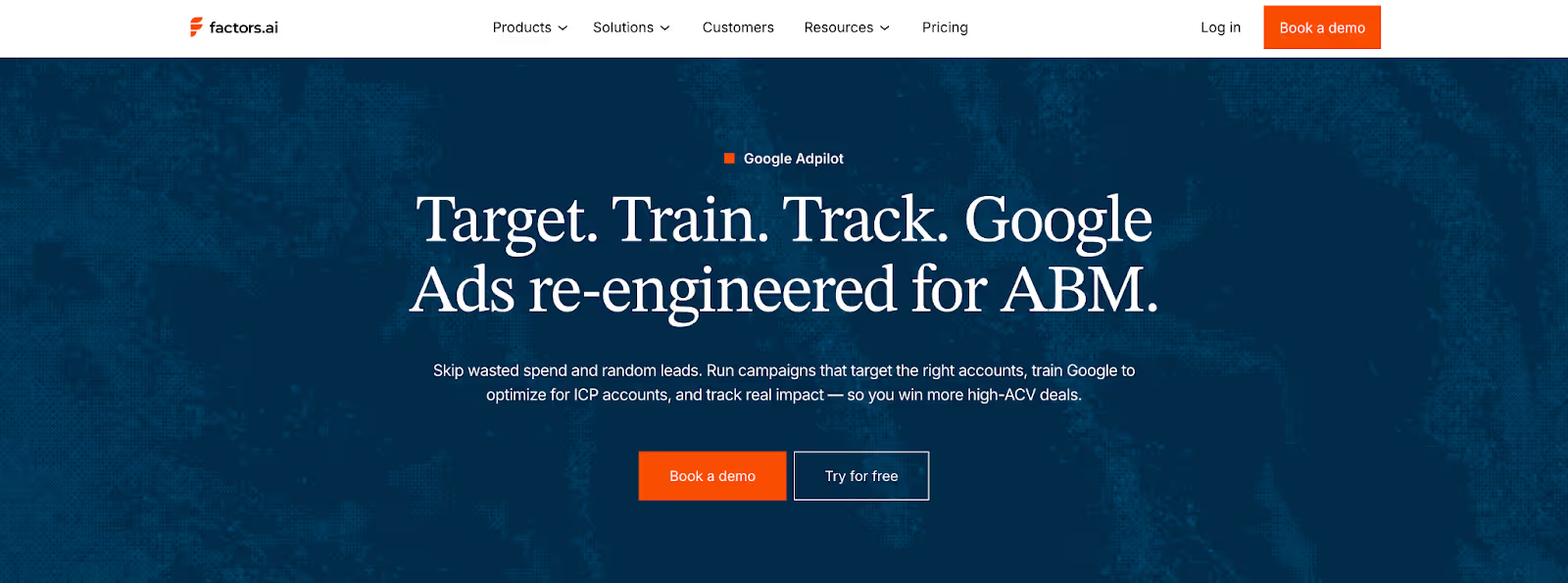
Factors.ai brings intelligence to ad orchestration through its integrated AdPilot suite, built specifically for performance-driven B2B campaigns.
Rather than simply syncing audiences, it uses intent signals and funnel movement to dynamically adjust ad delivery, ensuring that every impression counts.
Core activation strengths include:
- LinkedIn AdPilot: Automatically refreshes audiences using real-time intent data. Ensures only high-intent accounts see active campaigns.
- Google AdPilot: Sends conversion signals through Google CAPI, optimizing bids for ICP-fit accounts and suppressing irrelevant clicks.
- Buyer-stage campaigns: Tailors ad creatives and delivery based on funnel stages across awareness, consideration, or decision.
- Cross-platform orchestration: Triggers ad, CRM, and Slack actions from the same AI workflows, creating a continuous GTM loop.
- Impression pacing control: Prevents ad fatigue by distributing impressions evenly across targeted accounts.
The result is a smarter, leaner ad strategy and reduces waste and converts intent into measurable pipeline growth.
Madison Logic’s Ad Activation and Orchestration
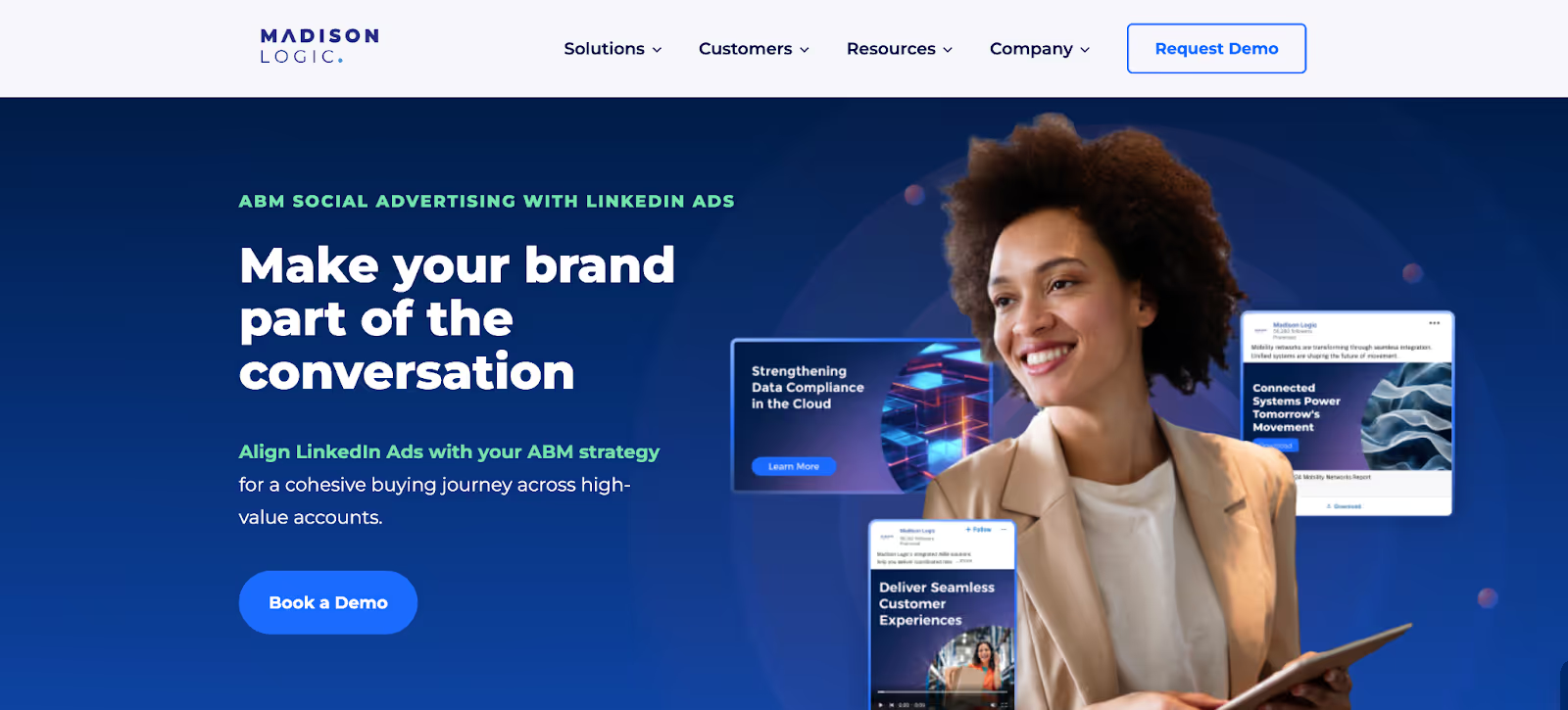
Madison Logic is widely recognized for its multi-channel activation network, covering display, LinkedIn, CTV, audio, and content syndication.
Its platform allows B2B marketers to deliver targeted campaigns at scale, especially for enterprise audiences.
Key ad activation capabilities include:
- Native LinkedIn integration for audience-based ABM campaigns.
- Display and content syndication channels for broader reach and retargeting.
- Campaign-level targeting powered by ML Insights intent data.
- Cross-channel measurement through ML Measurement for engagement and ROI tracking.
- Manual orchestration: Campaign updates and targeting refinements are primarily handled via platform setup rather than automation.
Madison Logic’s model works well for large marketing teams running broad ABM programs, though its orchestration layer remains less dynamic compared to AI-driven systems like Factors.ai.
Factors.ai vs Madison Logic: Verdict on Ad Activation and Orchestration
Both platforms excel in different aspects of ad activation, but their approaches reflect two distinct mindsets.
Factors.ai focuses on precision and automation, activating ads only when intent is high, refreshing audiences in real time, and linking campaign performance directly to revenue. Its AdPilot suite brings measurable efficiency to both LinkedIn and Google Ads.
Madison Logic shines in reach and diversity, offering multi-channel exposure across display, CTV, and content networks. However, its orchestration remains manual, and campaign optimization depends more on scale than on signal-based automation.
In short:
Factors.ai = Dynamic, AI-led ad activation with real-time optimization.
Madison Logic = Multi-channel ABM execution built for enterprise reach.
Running LinkedIn campaigns? Here’s a hands-on guide to LinkedIn ads strategy for B2B SaaS which is great for deciding whether native activation (Madison Logic) or AdPilot-style syncs fit you.
Factors.ai vs Madison Logic: Analytics, Measurement and Reporting
For B2B marketers, understanding what actually drives pipeline is just as important as generating it.
That’s where analytics and reporting make the difference between guessing and scaling.
Both Factors.ai and Madison Logic provide performance insights, but their approaches: one unified and intelligent, the other campaign-focused which reflects the broader philosophy of each platform.
Factors.ai vs Madison Logic: Analytics, Measurement and Reporting Comparison Table
Factors.ai’s Analytics, Measurement and Reporting

Factors.ai approaches analytics as the core of GTM intelligence, connecting every marketing and sales signal into a single measurement framework.
Its analytics layer isn’t just about visualizing metrics; it’s designed to explain why deals move, where engagement happens, and how campaigns influence revenue.
Key strengths in analytics and measurement:
- Milestones analytics: Tracks how accounts move through different funnel stages and attributes every touchpoint that contributed to progress.
- Multi-touch attribution: Measures ROI across campaigns, ads, and CRM activities to identify high-performing channels.
- Custom dashboards: Offers up to 300 customizable reports, segmented by account type, intent level, or sales stage.
- Account360 visibility: Combines CRM, ad, and web data to show the full customer journey, from first touch to closed deal.
- Revenue linkage: Connects marketing actions directly to pipeline outcomes for clear, defensible ROI.
With Factors.ai, teams move from reporting on activities to proving outcomes, shifting analytics from “what happened” to “what worked.”
Madison Logic’s Analytics, Measurement and Reporting

Madison Logic focuses its measurement framework on campaign performance and pipeline influence through its ML Measurement product.
It’s designed for marketers running large, multi-channel ABM campaigns who need visibility into reach, engagement, and deal velocity.
Key analytics capabilities include:
- Campaign performance reporting across display, LinkedIn, and content syndication channels.
- Pipeline influence analysis, showing which campaigns contributed to deal acceleration.
- Engagement scoring for tracking content consumption and ad interaction.
- ROI snapshots comparing media spend to influenced revenue.
- Standard dashboards for evaluating reach, click-throughs, and conversion impact.
While these insights help enterprises gauge overall ABM success, Madison Logic’s analytics lean toward post-campaign summaries rather than real-time performance optimization.
Factors.ai vs Madison Logic: Verdict on Analytics, Measurement, and Reporting
Both platforms aim to quantify marketing impact, but at different levels of sophistication.
Factors.ai delivers a complete measurement ecosystem, connecting every campaign, ad, and CRM touchpoint into one analytical view. Its multi-touch attribution, Milestones framework, and custom reporting make it ideal for teams focused on pipeline accuracy and continuous optimization.
Madison Logic provides solid campaign-level visibility, particularly valuable for enterprise marketers tracking cross-channel engagement and media performance. However, its insights remain top-level which is better for measuring impact than diagnosing it.
In short:
Factors.ai = Full-funnel analytics that link engagement directly to revenue.
Madison Logic = Campaign-level measurement suited for large-scale ABM visibility.
Factors.ai vs Madison Logic: Support, Onboarding and Ease of Setup
A powerful platform is only as good as its implementation.
For marketing and sales teams, smooth onboarding and responsive support determine how fast they can go from setup to measurable results.
Both Factors.ai and Madison Logic support enterprise customers, but their post-sale experiences differ in accessibility, personalization, and speed.
Factors.ai vs Madison Logic: Support, Onboarding and Ease of Setup Comparison Table
Factors.ai’s Approach Support, Onboarding and Ease of Setup
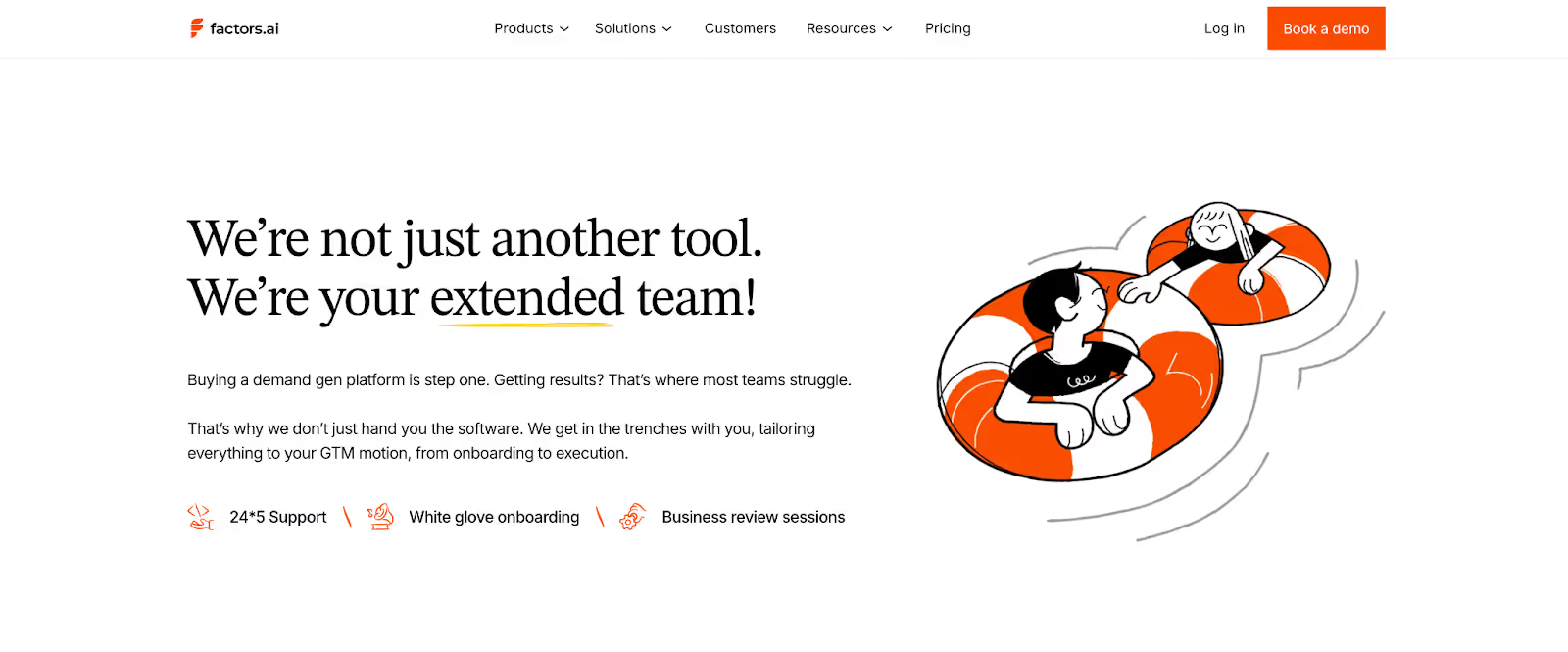
Factors.ai prioritizes accessibility and hand-holding from the very start.
Its onboarding experience is built for speed and confidence, ensuring that teams can see data flowing within days of setup.
Key highlights:
- White-glove onboarding: Dedicated specialists assist with platform setup, integrations, and initial configuration.
- Dedicated CSM: Every account, especially at Growth and Enterprise tiers, gets a customer success manager who ensures goals are met and progress tracked.
- Support channels: Live Slack communication, helpdesk, and email support ensure real-time responses.
- Weekly GTM syncs: Teams receive ongoing performance reviews and recommendations to improve campaign strategy.
- Ease of setup: Most integrations (HubSpot, Salesforce, Google Ads, LinkedIn) are plug-and-play, requiring minimal technical input.
This hands-on approach means even non-technical GTM teams can go live quickly and receive continuous optimization guidance, not just troubleshooting.
Madison Logic’s Support, Onboarding and Ease of Setup
Madison Logic provides onboarding that’s tailored for large enterprise ABM programs.
Its process involves working directly with campaign managers and strategists to configure targeting, creative, and measurement, making it suitable for organizations with defined internal marketing operations.
Notable support characteristics:
- Managed onboarding: The Madison Logic team typically handles campaign setup and alignment rather than a self-service model.
- Enterprise support model: Assistance is often routed through account managers and ticket-based systems.
- Setup complexity: Because campaigns are customized for scale, implementation may take longer and require alignment with multiple departments.
- Performance reviews: Enterprise clients receive periodic reports, but ongoing strategic feedback isn’t always continuous.
While the experience is professional and enterprise-grade, it caters to structured marketing departments with dedicated staff which is less suited for agile teams needing faster self-service setups.
Factors.ai vs Madison Logic: Verdict on Support, Onboarding and Ease of Setup
Both platforms deliver credible enterprise support, but their approaches cater to different customer needs.
Factors.ai provides fast, collaborative onboarding that helps teams start quickly and stay aligned through ongoing reviews. Its human-led yet agile support experience suits both scaling startups and large GTM teams.
Madison Logic, by contrast, offers a traditional enterprise support model focused on managed campaign delivery. It’s reliable for big organizations but less flexible for smaller teams that prefer direct, self-driven access.
In short:
Factors.ai = Fast, guided onboarding and responsive, hands-on support.
Madison Logic = Structured, enterprise-managed onboarding suited for large ABM teams.
Factors.ai vs Madison Logic: Security and Compliance
When handling sensitive customer and campaign data, security is a foundation of trust.
Both Factors.ai and Madison Logic take compliance seriously, offering enterprise-grade safeguards, but their depth and transparency differ in a few important ways.
Factors.ai vs Madison Logic: Security and Compliance Comparison Table
Factors.ai’s Security and Compliance
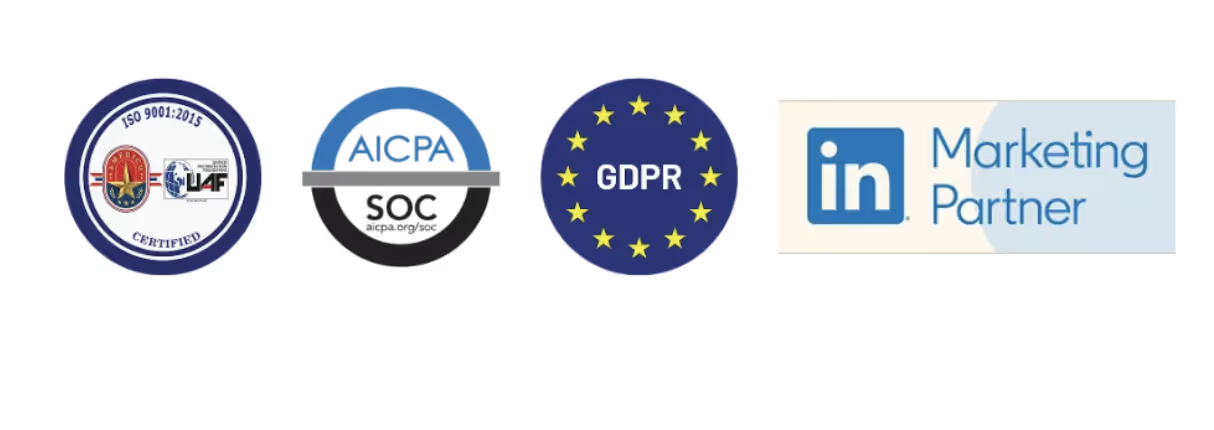
Factors.ai treats data security as an integral part of its infrastructure.
Hosted on Google Cloud Platform (GCP), it inherits GCP’s SOC-certified environment while adding multiple internal security layers to ensure customer data stays private, encrypted, and auditable.
Key security practices include:
- Data encryption: All customer data is encrypted both in transit (TLS, SHA-2) and at rest (AES-256).
- Access controls: Role-based permissions, multi-factor authentication, and IP-based access restrictions.
- Organizational security: Every employee signs confidentiality agreements and undergoes ongoing security training.
- Incident management: A clear policy led by a Data Protection Officer (DPO), with immediate reporting and recovery protocols.
- Backup and disaster recovery: Frequent snapshots stored in multiple geographic locations within the US.
- International data protection: Adheres to EU SCCs with technical and organizational safeguards for cross-border data transfers.
The platform’s transparency is another strength: its public Security Policy outlines all compliance practices and certifications, giving customers full visibility into how their data is protected.
Madison Logic’s Security and Compliance

Madison Logic maintains a strong compliance posture, with certifications and privacy adherence built around enterprise advertising standards.
The company is SOC 2 Type II, GDPR, CCPA, and CASL compliant, ensuring that personal and campaign data meets international privacy expectations.
Security framework highlights:
- Data center compliance: Operates on enterprise-grade hosting with SOC and ISO certifications.
- Privacy coverage: Fully aligned with GDPR and CCPA regulations for data processing and opt-out handling.
- Ad data protection: Uses secure protocols to protect audience and campaign data shared across display and LinkedIn networks.
- Access controls: Standard authentication and limited user permissions to safeguard platform use.
- Data processing agreements: Available to customers upon request, detailing data handling and storage practices.
While Madison Logic provides the expected security for an enterprise ABM platform, it offers fewer publicly available details about technical controls or encryption methods compared to Factors.ai’s transparent documentation.
Factors.ai vs Madison Logic: Verdict on Security and Compliance
Both platforms comply with leading global standards, but their approaches to transparency and depth differ.
Factors.ai stands out with its publicly documented, multi-layered security framework, SOC and ISO certifications, and clear data protection processes. Its encryption, backup, and compliance structure make it ideal for teams with strict data governance requirements.
Madison Logic offers robust enterprise compliance, ensuring legal and privacy adherence across campaigns, but keeps its internal processes largely behind closed documentation. It’s reliable for large-scale marketing operations but less open in its technical transparency.
In short:
Factors.ai = Transparent, multi-layered security framework with public compliance visibility.
Madison Logic = Enterprise-grade compliance with limited public technical disclosure.
If privacy and compliance are priorities, this article explores website visitor identification privacy and how to remain compliant while doing ABM.
Factors.ai vs Madison Logic: Overall Verdict and Recommendation
Both Factors.ai and Madison Logic empower B2B marketers to reach and engage their target accounts, but their strengths lie in very different areas.
Where Madison Logic emphasizes large-scale, managed ABM campaigns across multiple ad channels, Factors.ai focuses on intelligent, connected GTM execution, turning every insight into measurable action.
Factors.ai vs Madison Logic: Quick Comparison Recap
- Choose Factors.ai if you want a unified GTM platform that connects intent, analytics, and activation which is perfect for teams that value agility, automation, and transparency.
- Choose Madison Logic if you prioritize ABM reach, managed execution, and multi-channel advertising at enterprise scale.
In the end, Madison Logic helps you reach your market,
but Factors.ai helps you understand it and convert it.
If this comparison helped, you may also like these related deep dives:
- Factors vs ZoomInfo - compare account intelligence approaches.
- Factors vs Dreamdata - deeper look at analytics + attribution differences.
FAQs for Factors.ai vs Madison Logic
Q. What is the main difference between Factors.ai and Madison Logic?
The biggest difference comes down to how intelligence turns into action.
Factors.ai focuses on real-time intent intelligence, automation, and full-funnel analytics that directly trigger ads, alerts, and workflows.
Madison Logic, on the other hand, is built around large-scale ABM activation, helping enterprises reach target accounts across multiple paid channels with managed execution.
Q. Which platform is better for intent-based B2B marketing?
If you want real-time, first-party-led intent data that updates as accounts move through your funnel, Factors.ai is the stronger fit.
If your priority is aggregated market intent to power broad ABM campaigns across display and content networks, Madison Logic is better aligned to that use case.
Q. Does Factors.ai support both LinkedIn Ads and Google Ads?
Yes. Factors.ai supports both LinkedIn and Google Ads through its AdPilot suite.
Audiences sync dynamically based on intent and funnel stage, and Google conversion signals are sent via CAPI to improve bid optimization and reduce wasted spend.
Madison Logic primarily supports LinkedIn Ads along with display, CTV, and content syndication channels, but does not offer Google Ads activation.
Q. Can Madison Logic replace a GTM analytics or attribution tool?
Not entirely. Madison Logic provides campaign-level measurement and pipeline influence tracking, which works well for reporting on ABM performance at scale.
However, it does not offer deep multi-touch attribution, journey timelines, or CRM-linked funnel analytics the way Factors.ai does.
Q. Which platform is better for small or mid-sized B2B teams?
Factors.ai is generally better suited for startups and mid-market teams because of:
- Transparent, tiered pricing
- A free plan to get started
- Faster onboarding and self-serve workflows
Madison Logic is more appropriate for large enterprise teams with established ABM budgets and managed campaign requirements.
Q. Does Factors.ai integrate deeply with CRM systems?
Yes. Factors.ai offers bi-directional integrations with HubSpot, Salesforce, and Marketo.
This means CRM updates, deal stages, and account activity flow both ways, enabling real-time scoring, alerts, and analytics.
Madison Logic integrates with similar CRMs, but data typically flows one way to support campaign targeting rather than closed-loop GTM analytics.
Q. How does each platform handle buying groups and multiple stakeholders?
Factors.ai actively identifies buying groups by mapping multiple contacts engaging from the same account and tracking their shared journey.
Madison Logic focuses more on account-level intent and targeting, with less visibility into individual stakeholders or buying group dynamics.
Q. Is Factors.ai suitable for enterprise teams?
Yes. Factors.ai offers an Enterprise plan with:
- Unlimited account identification
- Predictive scoring
- Advanced Milestones analytics
- White-glove onboarding
- Custom reporting at scale
It’s especially useful for enterprise teams that want automation, attribution clarity, and tighter sales-marketing alignment, not just media execution.
Q. Which platform is easier to implement and go live with?
Factors.ai typically goes live within days, thanks to plug-and-play integrations and guided onboarding.
Madison Logic’s setup timeline varies depending on campaign scope and often involves longer coordination cycles across teams and regions.
Q. Does either platform offer a free trial or free plan?
Factors.ai offers a free plan, allowing teams to track companies, view journeys, and integrate Slack before upgrading.
Madison Logic does not offer a free plan or public trial.
Q. How do Factors.ai and Madison Logic compare on data security and compliance?
Both platforms are enterprise-grade and compliant with major regulations like GDPR and CCPA.
Factors.ai stands out for its publicly documented security practices, ISO 27001 and SOC 2 Type II certifications, and detailed encryption policies.
Madison Logic is SOC 2 Type II compliant but provides fewer publicly available technical details.
Q. Which platform should I choose for my GTM strategy?
Choose Factors.ai if you want:
- Real-time intent intelligence
- Automation across ads, CRM, and workflows
- Clear attribution from engagement to revenue
Choose Madison Logic if you want:
- Broad ABM reach across multiple paid channels
- Managed enterprise campaign execution
- A strong activation network at scale
Both are solid platforms, the right choice depends on whether you value precision and insight or reach and scale.
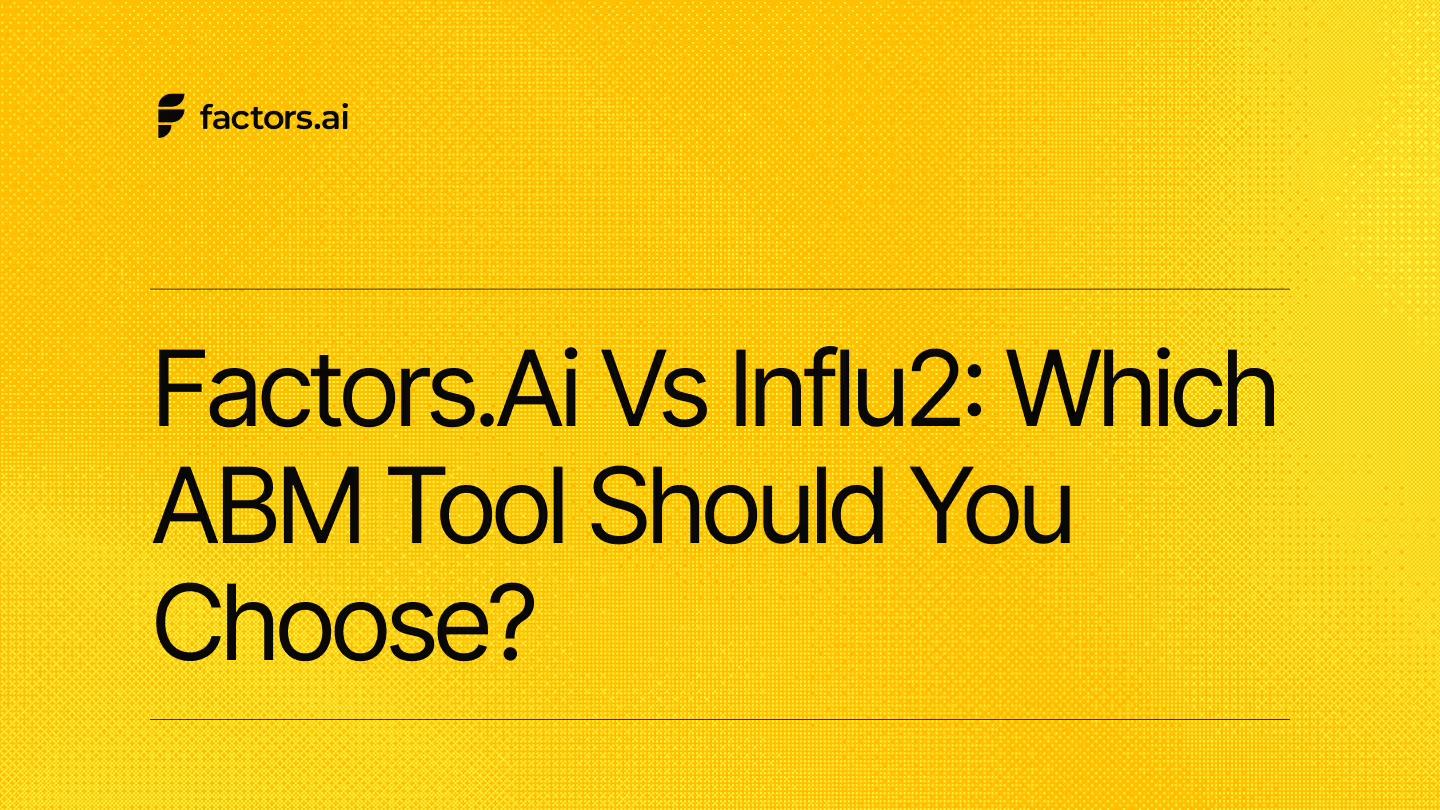
Factors.ai vs Influ2: Which ABM Tool Should You Choose?
Finding the ‘right’ demand generation platform usually starts with a demo and ends with a headache.
I’ve seen this play out way too often. Someone on the team says, “We need better intent data.” Another person says, “We just need cleaner attribution.” A third says, “Sales wants visibility into who’s actually engaging.” And suddenly you’re evaluating tools that sound similar on paper but solve very different problems in reality.
That’s exactly where the comparison between Factors.ai and Influ2 sits.
Both platforms help GTM teams move closer to revenue. Both talk about intent, pipeline, and alignment. But they come from fundamentally different starting points. One is built around understanding accounts and orchestrating the entire GTM motion. The other is built around reaching specific people and proving ad influence with precision.
If you’re running modern B2B demand gen, especially across ads, CRM, sales workflows, and revenue reporting, this distinction matters more than most teams realize.
In this guide, I break down how Factors.ai and Influ2 actually work across functionality, pricing, identification, intent, ad activation, analytics, support, and security. The goal is simple. Help you figure out which platform fits how your GTM engine really runs, not how it looks in a slide deck.
Factors vs Influ2: Functionality and Core Capabilities
One question I always ask when evaluating GTM tools is simple: how many tabs do I still need open after I log in?
Some platforms solve one very specific problem extremely well. Others try to act as the connective tissue across marketing, sales, and revenue. Neither approach is wrong. But confusing one for the other is where teams get stuck.
In an ecosystem like the one we’re in today… filled with ad-tech and GTM platforms, the real difference lies in how much of the demand-generation process a tool can handle end-to-end.
Both Factors.ai and Influ2 aim to help marketing and sales teams drive more revenue from intent data and targeted outreach, but the way they approach that goal is very different.
Factors.ai works as a complete GTM orchestration system that connects analytics, automation, and activation.
Influ2, in contrast, focuses on precision advertising at the contact level, showing the right message to the right person across multiple channels.
This section is all about scope. Are you looking for a system that helps you execute a specific motion with precision, or a platform that helps you see, measure, and run your entire GTM strategy in one place?
Functionality and Core Capabilities Comparison
Factors.ai’s Functionality and Core Capabilities

Factors.ai goes beyond traditional analytics by giving GTM teams an integrated workspace where every part of the demand-generation process connects.
What stands out here is that this setup mirrors how real GTM teams work. Signals do not live in isolation. Website visits, ad clicks, CRM updates, and product usage all influence how accounts move forward. Having these stitched together in one timeline saves hours of manual interpretation and removes a lot of guesswork between marketing and sales.
With platforms like Factors.ai by their side… teams go from reactive follow-ups to proactive outreach simply because everyone is finally looking at the same account story.
Key capabilities:
- Account 360: a unified timeline that brings together website activity, ad engagement, CRM data, and product usage in one view.
- Milestones: funnel analytics that show how accounts move from awareness to revenue.
- AI Agents: tools that analyze data, surface buying signals, and alert sales when an account is ready for outreach.
- Dynamic Ad Activation: automated campaign updates through Google CAPI and LinkedIn AdPilot, ensuring ads reach only active, in-market accounts.
- GTM Engineering Services: optional add-on support that helps teams automate workflows and integrate tools efficiently.
The result is a system that doesn’t just report performance but actively shapes it to help teams identify, engage, and convert high-intent accounts within one connected environment.
Influ2’s Functionality and Core Capabilities

Influ2 takes a more focused route by centering everything around people. Its strength lies in showing ads to named contacts already in your CRM and then tracking their exact interactions with each campaign.
Now, this model works best when your target universe is already defined. You know who the buyers are, you trust your CRM data, and your priority is making sure specific people see specific messages at the right time.
For teams running tight ABM or sales-assisted advertising, this kind of clarity can be useful. Sales conversations also become easier when reps can see exactly which ads a prospect engaged with before a call.
Key capabilities:
- Contact-Level Targeting: sync CRM contacts directly and serve ads only to those specific individuals.
- Ad Engagement Tracking: see who viewed or clicked an ad and how often.
- Journey Mapping for Ads: align ad messaging to buyer stages and personalize creatives accordingly.
- Sales Notifications: alert sales reps when targeted contacts engage with an ad.
- Revenue Attribution: connect ad exposure data with pipeline and closed-won deals to prove ROI.
It’s a precise system that works best when you already know your audience and want to reach them consistently across digital channels.
Factors vs Influ2: Verdict on Functionality and Core Capabilities
Both platforms deliver results but cater to different needs.
Influ2 is a sharp, contact-level tool that gives you visibility into who engaged with your ads and how they moved through the funnel.
Factors.ai is built for teams that need more than visibility and brings together data, automation, and execution to manage the entire GTM process in one place.
In short:
Factors.ai = Full-funnel orchestration for scalable revenue growth.
Influ2 = Targeted advertising for known contacts and ABM programs.
Factors vs Influ2: Pricing and Plans
Some platforms optimize for flexibility and self-serve growth. Others optimize for enterprise deals and bespoke contracts. Neither is inherently better, but it does affect how quickly teams can get started and how confidently they can plan ahead.
While both Factors.ai and Influ2 focus on measurable marketing outcomes, their pricing models work very differently.
Factors.ai follows a clear usage-based structure with multiple tiers designed for growth.
Influ2, on the other hand, doesn’t publish its pricing, requiring a sales call for every quote.
Pricing and Plans Comparison
Factors.ai Pricing and Plans

Factors.ai is built to be flexible and upfront.
Its pricing scales based on usage and team size, allowing companies to start small and expand as their GTM activities grow.
What I like about this structure is that teams can actually grow into the platform. You can start with identification and journeys, then layer on scoring, ABM analytics, and ad activation as your GTM motion matures. The optional GTM engineering support also removes a common bottleneck I see, where great tools fail simply because no one has the time to wire everything correctly.
Here’s how it breaks down:
- Free Plan: For small teams exploring account identification and journey tracking.
- Basic Plan: Adds LinkedIn intent signals, GTM workflows, and CRM integrations.
- Growth Plan: Includes ABM analytics, account scoring, and G2 intent signals with a dedicated CSM.
- Enterprise Plan: Offers unlimited company tracking, predictive scoring, and premium integrations like Google and LinkedIn AdPilot.
For teams that want hands-on technical help, GTM Engineering Services can be added at an additional cost.
This gives teams direct engineering support for workflow automation, advanced integrations, and data management which is something most software tools charge separately through agencies or consultants.
Influ2 Pricing and Plans
Influ2 takes a traditional enterprise pricing route.
Its pricing isn’t listed publicly, and quotes are provided only after understanding the client’s campaign goals, ad budget, and audience size.
This approach makes sense for organizations already committed to large ad budgets and defined ABM programs. The trade-off is predictability. Without public pricing, it’s harder for teams to benchmark or plan experiments without going through a full sales cycle.
Factors vs Influ2: Verdict on Pricing and Plans
Factors.ai offers clarity and flexibility which is the kind of pricing structure that allows teams to grow at their own pace.
Its optional GTM Engineering Services add value for companies that need both software and setup guidance without hiring external partners.
Influ2 focuses on custom enterprise contracts tailored to ad spend and CRM scope.
That’s ideal for teams with established budgets but less suited for those wanting straightforward, self-serve onboarding.
In short:
Factors.ai = Transparent, scalable, and supported by optional GTM setup services.
Influ2 = Custom enterprise pricing designed for established ABM programs.
Factors vs Influ2: Account and Contact Identification
You probably already know this but… the strength of any GTM or advertising platform starts with how accurately it can identify who’s engaging with your brand.
For B2B teams, that accuracy can mean the difference between wasted ad spend and real pipeline growth.
Factors.ai and Influ2 both excel in identification, but they approach it from different angles.
Factors.ai focuses on recognizing accounts and mapping every signal tied to them, while Influ2 focuses on contacts, showing ads directly to known individuals synced from your CRM.
Account and Contact Identification Comparison
Factors.ai Account and Contact Identification
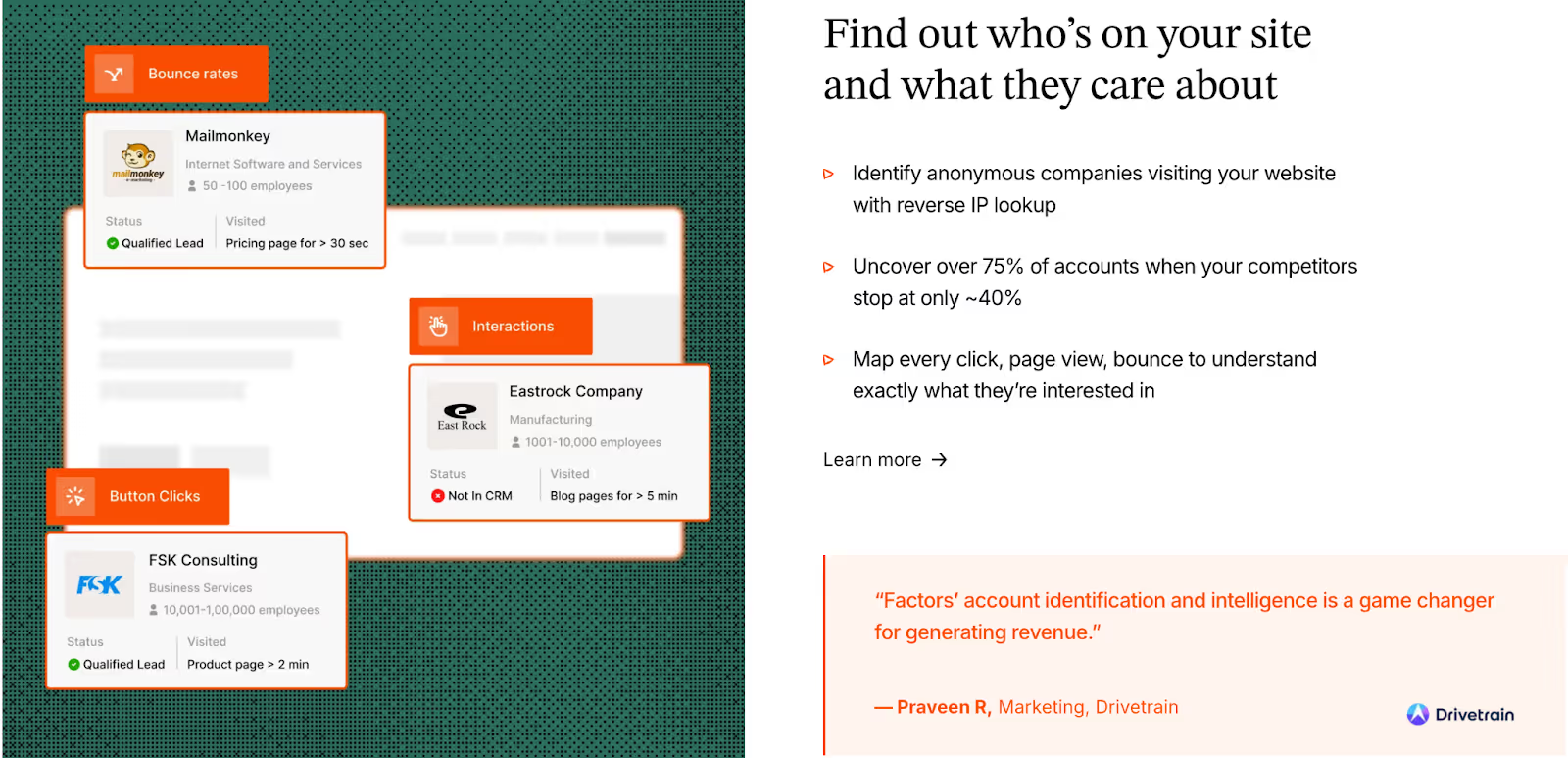
Factors.ai builds identification around the concept of the account journey. Instead of relying on single-source data, it enriches signals across multiple layers like web, CRM, product, and ad performance to build a detailed picture of buying intent.
The strength here is coverage and context. Identification is not treated as a one-time event but as an evolving account journey. Signals accumulate over time, across channels, and across people within the same organization. That’s what allows teams to move beyond “someone from this company visited” to “this account is actively evaluating.”
Key capabilities:
- Sequential Enrichment: uses multiple signals to match anonymous traffic with company data.
- Account 360: creates a unified profile for each account, combining all interactions across touchpoints.
- Multi-Signal Intent Mapping: pulls in first-party (site), second-party (ads, G2), and third-party (uploads) data.
- Contact Insights via AI Agents: surfaces decision-makers, recent actions, and context for outreach.
- Funnel Positioning: helps teams see where each account stands in the buying process.
This approach gives GTM teams visibility into both who is showing intent and how far they’ve moved toward conversion.
Influ2 Account and Contact Identification
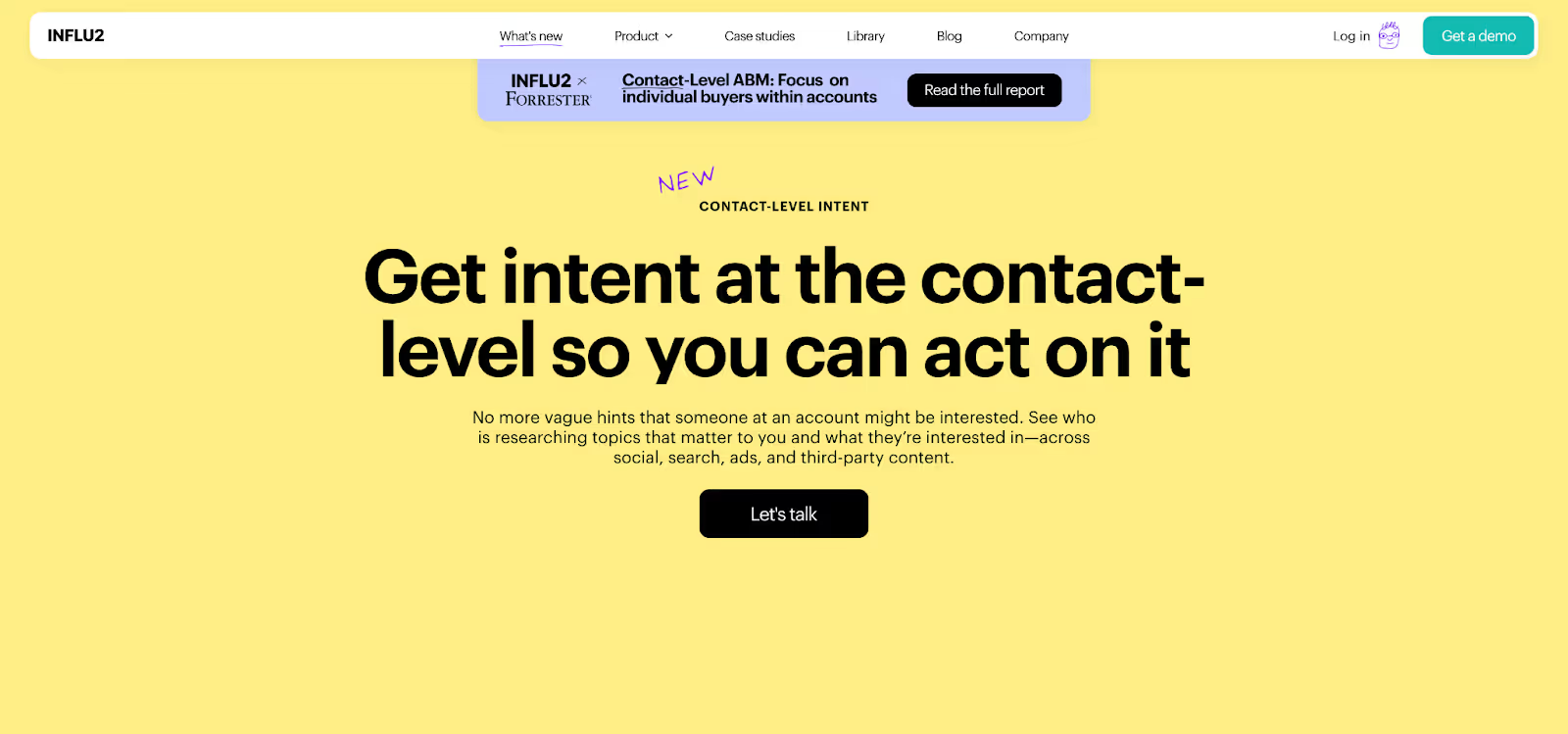
Influ2 works from the opposite direction, starting with named contacts already known to your team. Its strength lies in precision targeting rather than broad discovery.
What I’m saying is… Influ2 does not try to discover new accounts. It assumes discovery has already happened. Its value comes from making sure known contacts are consistently reached and their engagement is fully visible. For focused ABM motions, that clarity can be a huge win.
Key capabilities:
- CRM Sync: imports contacts directly from Salesforce, HubSpot, or other CRMs.
- Person-Level Targeting: delivers ads specifically to those individuals, not just companies or roles.
- Contact-Level Identification: maps ad engagement (views, clicks) to each contact’s profile.
- Sales Notifications: alerts reps when targeted contacts interact with ads.
- Audience Refresh: keeps lists up to date as contacts are added or removed from campaigns.
This makes Influ2 especially effective for ABM programs focused on known accounts and warm prospects. It doesn’t uncover new leads but ensures your message reaches the right people consistently.
Factors vs Influ2: Verdict on Account and Contact Identification
Influ2 delivers precision through contact-level targeting, making it ideal for teams running focused ABM or sales-assisted campaigns.
It gives visibility into who exactly engaged with your ads and when.
Factors.ai, meanwhile, offers a broader view, identifying not only the accounts visiting your site but also mapping all interactions leading to intent.
It connects individual behaviors back to the larger buying group, giving teams both discovery and context.
In short:
Factors.ai = Account-level visibility that connects every signal across the funnel.
Influ2 = Contact-level precision built for targeted advertising programs.
Factors vs Influ2: Intent Signals and Buyer Insights
Intent is one of the most overused words in GTM. Everyone claims to have it. Very few platforms explain what they actually do with it.
What matters here is how signals are interpreted and whether they help teams act earlier and with more confidence.
For GTM teams, it’s not enough to know who visited a page as they need to know why, when, and how close that visitor is to taking action.
Both Factors.ai and Influ2 focus on intent, but they do it differently.
Factors.ai gathers intent from multiple layers like website behavior, CRM activity, ads, and product engagement to show the full account picture.
Influ2, on the other hand, tracks intent at the individual level, measuring who among your known contacts is responding to ads and how that maps to revenue.
Intent Signals and Buyer Insights Comparison
Factors.ai Intent Signals and Buyer Insights
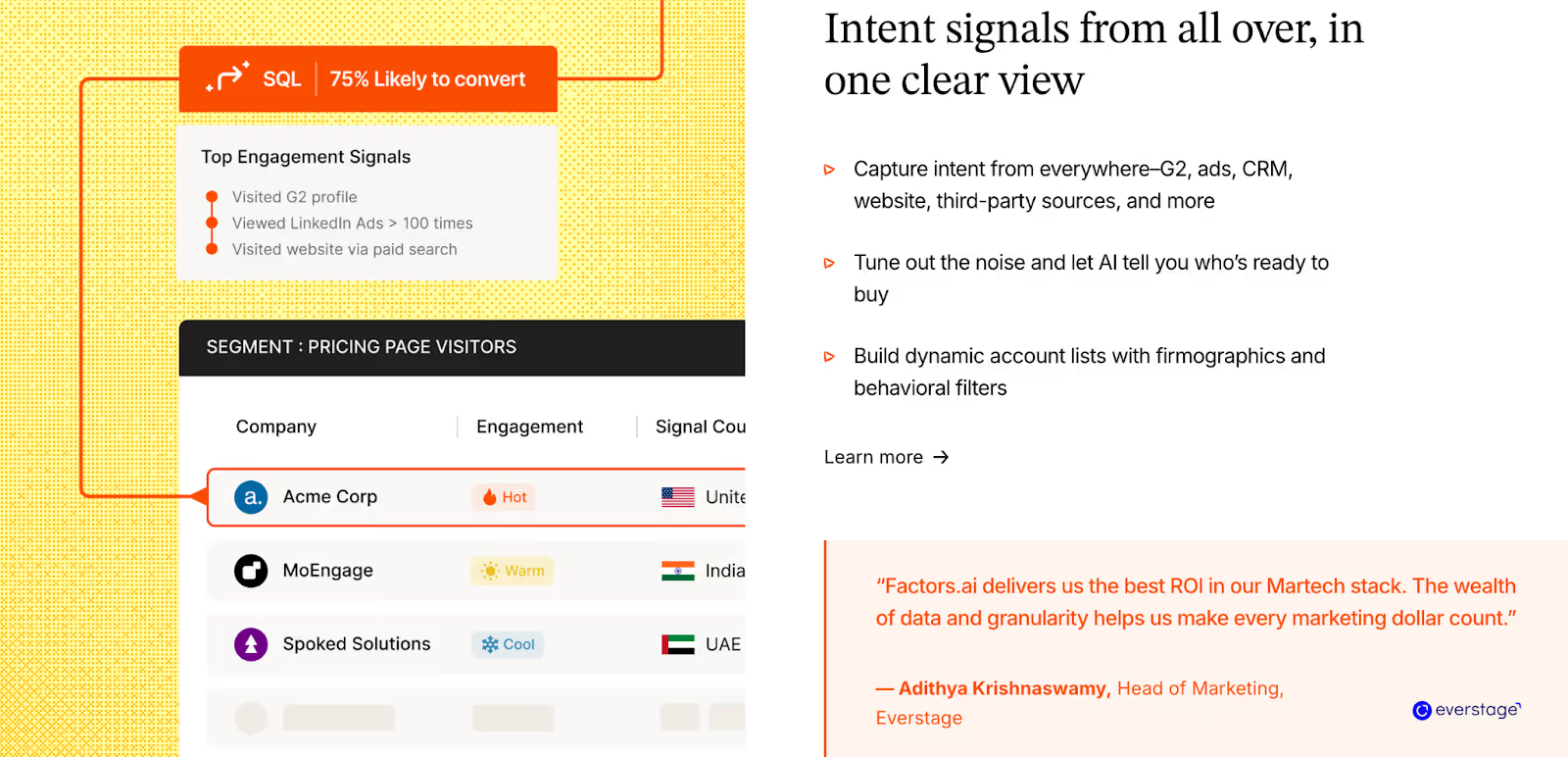
Factors.ai looks at intent as a connected system rather than a single activity. It combines signals from across your tech stack to give both marketing and sales a shared understanding of where each account stands.
AND because intent is pulled from multiple systems, it reflects real buying behavior rather than isolated actions. This helps teams prioritize accounts before they raise their hand, which is often where the biggest revenue opportunities sit.
Key capabilities:
- Multi-Layered Intent Tracking: combines web visits, CRM updates, ad engagement, and product usage.
- Buying-Group Detection: identifies multiple stakeholders interacting with your brand from the same company.
- Intent Scoring: ranks accounts by fit, funnel position, and level of activity.
- Milestones: shows when an account crosses key engagement thresholds, like demo requests or product revisits.
- AI-Powered Insights: surfaces patterns automatically, helping teams prioritize the next best action.
This approach gives GTM teams the clarity to act on intent early, not just react after conversion.
Influ2 Intent Signals and Buyer Insights
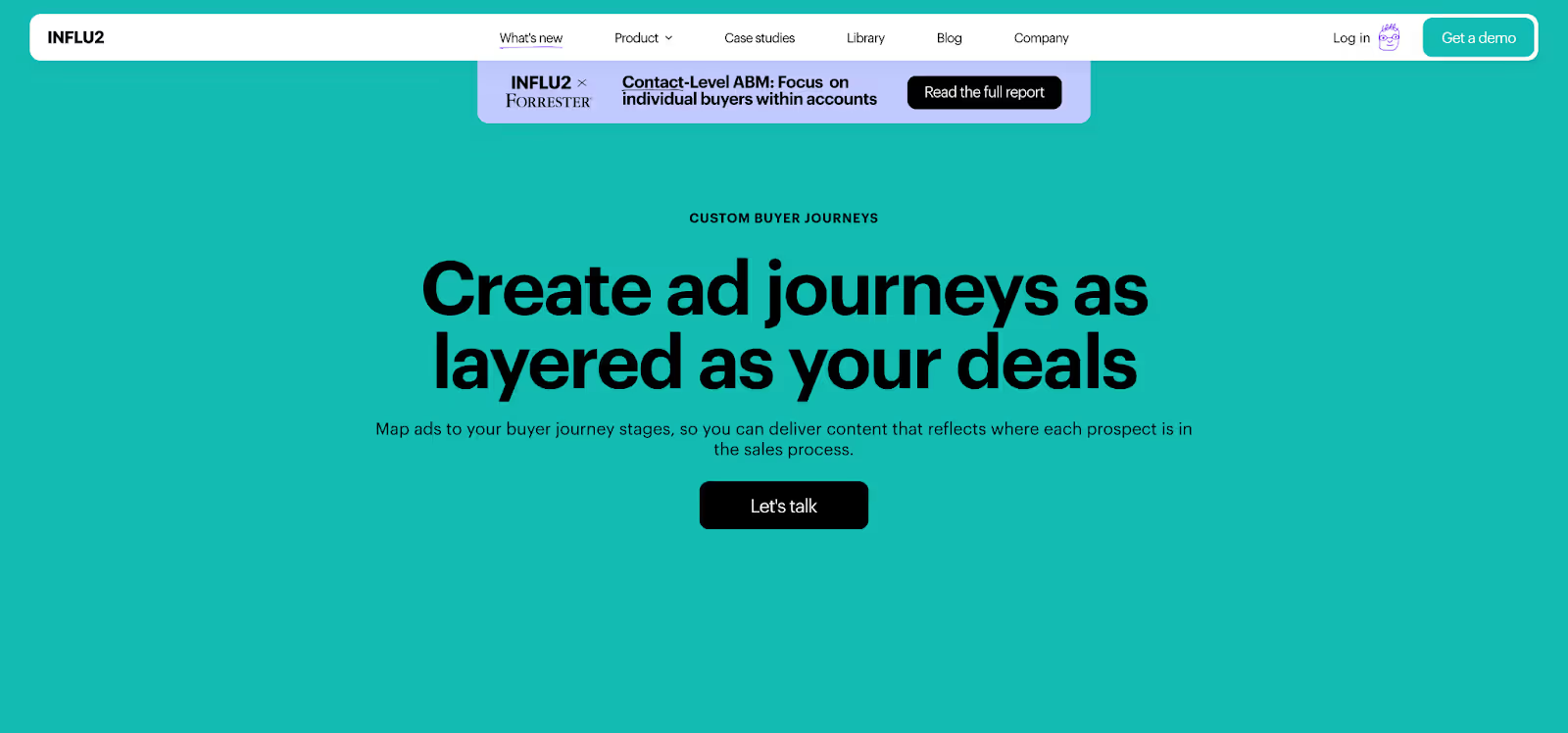
Influ2 focuses on intent that comes directly from advertising engagement. It measures who saw your ads, how often they interacted, and whether that engagement led to any downstream activity.
This model gives clean, defensible signals tied directly to advertising engagement. When your goal is proving ad influence and supporting sales conversations, that level of precision is extremely useful.
Key capabilities:
- Contact-Level Intent Tracking: tracks ad views, clicks, and post-ad engagement for specific individuals.
- Engagement Scoring: highlights contacts most responsive to your campaigns.
- Journey Mapping for Ads: aligns ad messaging with buyer stages to personalize outreach.
- Sales Notifications: alerts sales reps when a contact shows repeated engagement or conversion activity.
- Attribution Visibility: connects ad interactions to CRM data to show impact on pipeline or closed deals.
It gives marketing and sales a strong signal of personal interest which is a useful tool when targeting decision-makers already on your radar.
Factors vs Influ2: Verdict on Intent Signals and Buyer Insights
Influ2 delivers highly specific intent tied to individuals, making it ideal for account-based programs where contact lists are well-defined.
It tells you exactly who engaged with which campaign.
Factors.ai expands the scope to show not just who engaged, but what that engagement means at the account level.
By connecting multiple data sources and mapping collective buying behavior, it gives teams a clearer, actionable view of the full funnel.
In short:
Factors.ai = Multi-signal intent visibility across accounts and buying groups.
Influ2 = Contact-level intent focused on ad engagement accuracy.
Want a playbook? Read how to turn intent into demos in our intent-to-insight guide.
Factors vs Influ2: Ad Activation and Campaign Management
Ad activation is where strategy meets execution like this… 🤝.
(This is also where many teams lose efficiency due to manual audience updates and outdated targeting.)
Automation versus control is the CORE tension here.
The right tool helps you adapt, ensuring ads reach the right audience at the right time with minimal manual effort.
Both Factors.ai and Influ2 are strong in this space, but their focus differs.
Factors.ai drives campaign activation using AI, funnel data, and audience automation, while Influ2 emphasizes direct, contact-level ad delivery for precision targeting.
Ad Activation and Campaign Management Comparison
Factors.ai Ad Activation and Campaign Management
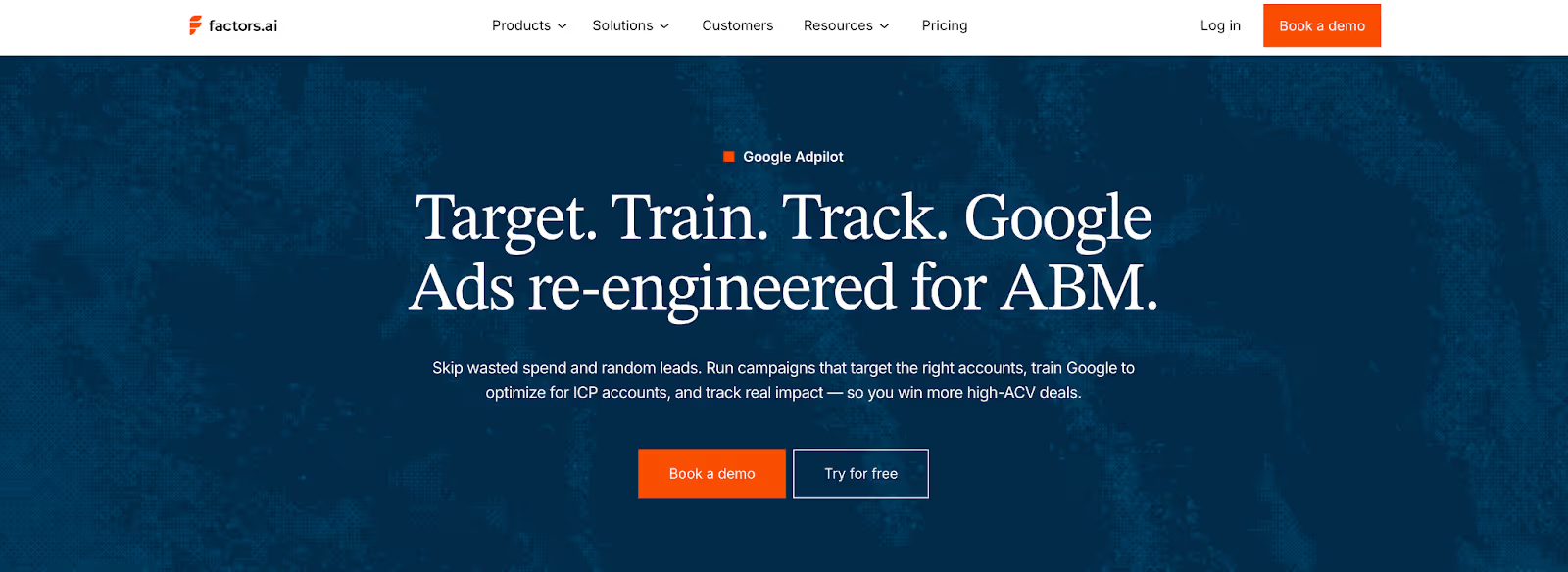
Factors.ai automates activation through intent-driven logic that syncs directly with your ad platforms.
Instead of broad targeting, it creates audiences dynamically based on who’s showing buying intent and where they are in the funnel.
Here, the biggest benefit I’ve seen is reduced waste. When audiences refresh automatically based on real intent and funnel movement, ads stay relevant without daily babysitting.
Key capabilities:
- LinkedIn AdPilot: activates and refreshes LinkedIn campaigns automatically based on account signals.
- Google AdPilot: pushes enhanced conversion signals using Google CAPI to optimize for pipeline-ready accounts.
- Buyer-Stage Campaigns: adapts ad creative and targeting as accounts move through awareness, consideration, and decision stage.
- Audience Suppression: removes inactive or irrelevant accounts to save ad spend.
- Real-Time Data Sync: updates audiences daily to ensure accuracy and freshness.
This setup means your ad campaigns stay relevant without needing constant manual updates.
It’s especially useful for teams running multi-stage GTM campaigns who want to align paid media with real-time intent.
Influ2 Ad Activation and Campaign Management

Influ2 treats ad activation at the person level.
It connects directly to your CRM, takes the list of named contacts, and serves ads only to those specific individuals across major ad networks.
This approach offers more direct control and broader channel reach. It works best when teams are comfortable managing defined contact lists and want visibility into every impression served.
Key capabilities:
- CRM-Based Targeting: syncs contacts from Salesforce, HubSpot, or Marketo to build precise audience lists.
- Cross-Channel Reach: runs campaigns across LinkedIn, Google, Meta, Bing, and Amazon.
- Personalized Ads: allows creative variations tailored to roles or funnel stages.
- Engagement Reporting: tracks which contacts viewed or clicked an ad, giving clear attribution.
- Sales Notifications: alerts reps when key contacts interact with campaigns.
This method ensures your ads only reach the people who matter most, helping reduce wasted impressions and improving sales alignment.
However, it requires pre-defined contact lists and doesn’t automate ad refreshes based on live intent signals like Factors.ai does.
Factors vs Influ2: Verdict on Ad Activation & Campaign Management
Influ2 delivers outstanding precision at the individual level, ideal for targeted ABM efforts where your contact list is clearly defined.
It shines in reach and control, especially across multiple ad networks.
Factors.ai, however, takes activation a step further.
By automating campaigns around real-time intent and funnel stages, it helps teams continuously optimize ad spend while keeping audiences current.
In short:
Factors.ai = Intent-based, automated ad orchestration that scales with your GTM funnel.
Influ2 = Contact-level targeting for high-precision, cross-channel advertising.
Factors vs Influ2: Analytics, Reporting and Revenue Attribution
Analytics should answer one question clearly: what actually moved revenue forward?
Clicks and impressions are easy to count. Understanding influence across a long B2B buying cycle is not. And for GTM and marketing teams… collecting data is never the end goal, interpreting it is.
The real impact of analytics comes from how clearly a platform connects engagement, conversion, and revenue.
Both Factors.ai and Influ2 offer strong visibility into performance, but their analytics depth and focus differ.
Factors.ai gives a holistic, full-funnel view linking every touchpoint to revenue, while Influ2 focuses more on tracking how ads influence known contacts and opportunities.
Analytics, Reporting and Revenue Attribution Comparison
Factors.ai Analytics, Reporting and Revenue Attribution
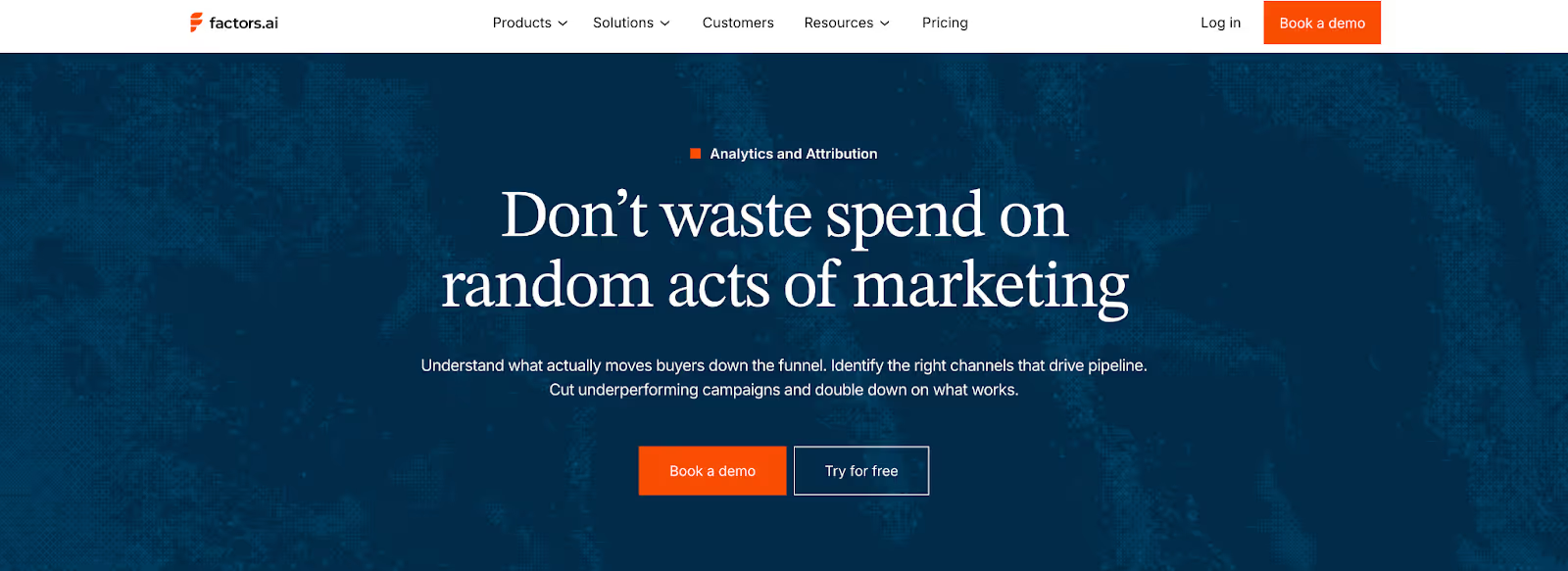
Factors.ai brings structure and visibility to GTM performance by tracking every touchpoint across the customer journey. Having marketing and sales look at the same revenue story changes conversations (and builds friendships that seemed impossible #IYKYK). Attribution stops being defensive and starts becoming strategic.
Factors.ai’s analytics map behavior from first visit to deal closure.
Key capabilities:
- Milestones: tracks key funnel movements such as demo requests, proposal sent, or deal won.
- Attribution Models: identifies which campaigns or channels contributed most to pipeline creation.
- Account 360: consolidates engagement data into a single view that connects marketing and sales outcomes.
- Custom Reporting: allows users to build dashboards that reflect revenue contribution by channel, region, or campaign type.
- Cross-Channel View: integrates website analytics, CRM data, and ad performance to offer a unified perspective.
Together, these features help teams see what’s driving pipeline growth and not just where clicks are coming from.
Influ2 Analytics, Reporting and Revenue Attribution
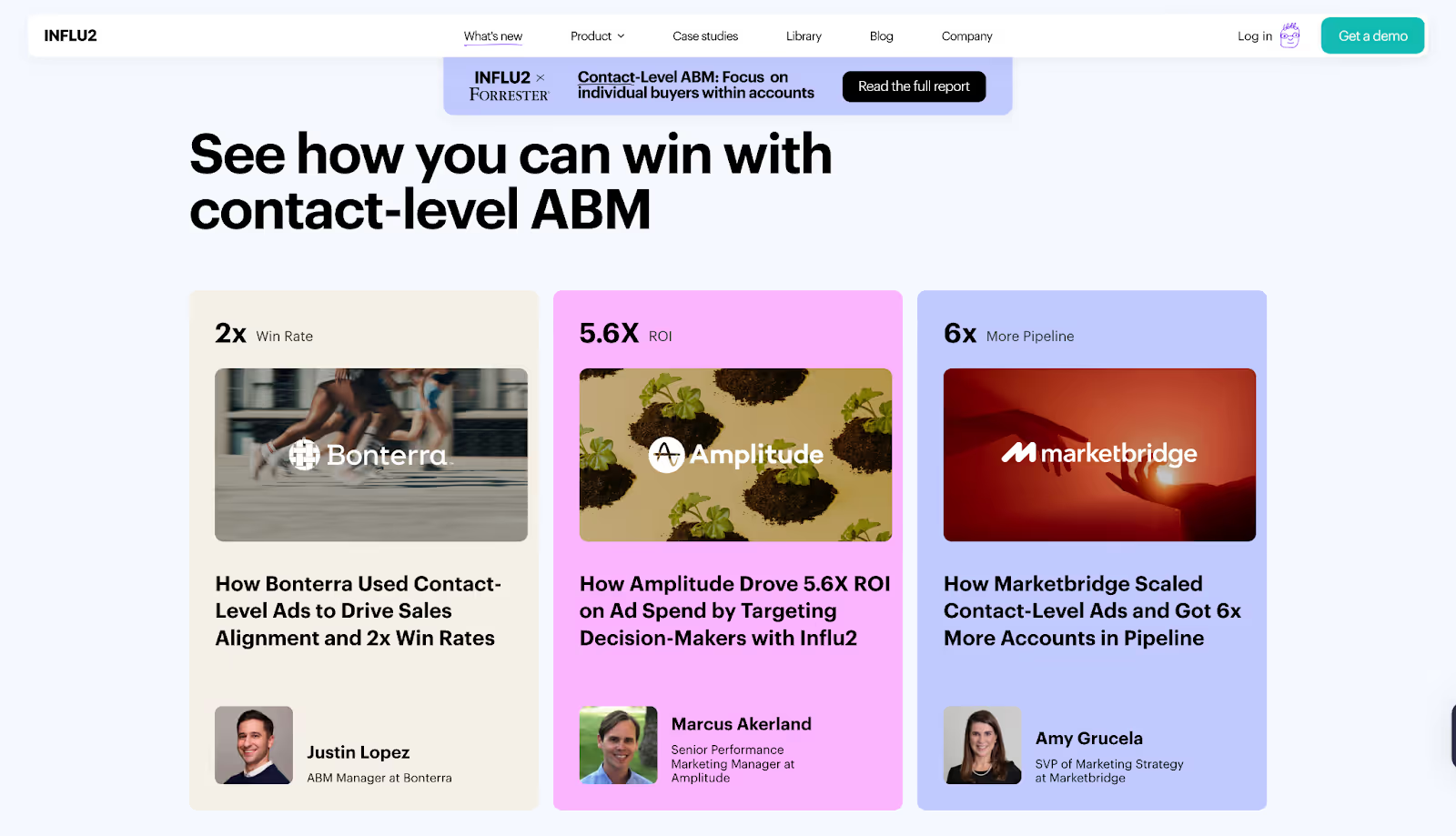
Influ2 delivers analytics designed to prove the influence of advertising on sales outcomes.
It connects ad impressions and clicks with named contacts in the CRM, helping teams validate whether campaigns actually drive engagement and revenue.
This is useful for validating ad spend in ABM programs. Sales teams appreciate seeing tangible proof of engagement before outreach.
Key capabilities:
- Contact-Level Attribution: measures which ads specific contacts viewed or engaged with.
- Campaign Impact Reporting: shows how ad exposure influenced opportunity creation or pipeline velocity.
- Engagement Frequency Tracking: monitors how often contacts interacted with your ads and what stage they were in when they did.
- ROI Metrics: highlights which ad campaigns influenced closed-won deals.
- Sales Insights: provides data sales teams can use for more relevant outreach.
This type of reporting helps prove the real-world value of targeted advertising, especially in ABM setups where direct attribution matters most.
Factors vs Influ2: Verdict on Analytics, Reporting & Revenue Attribution
Influ2 gives clarity at the contact level.
It’s well-suited for organizations that want to measure exactly how advertising engagement influences pipeline and closed-won deals.
Factors.ai takes a broader approach, connecting all signals including web, ads, CRM, and product, into one cohesive revenue picture.
It helps marketing and sales teams understand which channels drive actual business outcomes, not just engagement.
In short:
Factors.ai = Complete, full-funnel analytics linking engagement to revenue.
Influ2 = Contact-level visibility focused on ad influence and ROI validation.
For attribution detail, our types of attribution models guide explains when to use each model.
Factors vs Influ2: Support, Onboarding and Services
Ever seen a building without pillars? Ummm… exactly. The right platform is only as effective as the support behind it (AKA pillars).
Smooth onboarding and reliable assistance can turn complex setups into steady operations.
Both Factors.ai and Influ2 provide customer support, but Factors.ai takes it further by offering hands-on GTM engineering services which is something that most platforms leave entirely to the customer.
Support, Onboarding and Services Comparison
Factors.ai Support, Onboarding and Services

Factors.ai focuses on long-term partnership rather than simple onboarding. Every plan includes structured setup support, but the experience becomes more personalized as you move up tiers.
The engineering support here closes a reeeeaaaal gap. Many teams don’t want another agency. They want the platform itself to help them operationalize GTM ideas quickly.
Key highlights:
- White-Glove Onboarding: guided setup for integrations, dashboards, and ad automation.
- Dedicated CSM: available for ongoing check-ins, optimization, and progress tracking.
- Slack Channel Access: ensures fast communication and real-time feedback.
- Weekly GTM Reviews: collaborative sessions to align campaign insights and next steps.
- GTM Engineering Services: available as an add-on for deeper operational support, includes workflow automation, data synchronization, and reporting assistance.
For companies that want both software and execution help under one roof, this model provides exceptional value.
Influ2 Support, Onboarding and Services
Influ2 offers a straightforward customer success experience that centers around campaign performance and ad optimization. Most support activities happen through its CSM team, which guides users during setup and continues providing help as campaigns evolve.
This model works well for teams with internal resources or agency partners who already handle execution.
Key highlights:
- CSM-Led Onboarding: includes training, campaign setup guidance, and best practices.
- Strategic Check-Ins: periodic reviews to discuss performance metrics.
- Email & Ticket Support: available for troubleshooting and platform queries.
- Educational Resources: includes case studies, product blogs, and a help center.
The process is reliable and personal, but it lacks the deeper operational support that Factors.ai provides through its engineering services.
Verdict on Support, Onboarding and Services
Influ2 offers dependable customer success support with guidance that keeps campaigns on track.
It’s built for teams that already have internal technical resources or agency partners.
Factors.ai adds more depth to the experience.
With structured onboarding, proactive communication, and optional GTM engineering services, it ensures that every team (technical or not) can get the most from the platform.
In short:
Factors.ai = Strategic onboarding with hands-on GTM and engineering support.
Influ2 = Reliable customer success model focused on campaign guidance.
Factors vs Influ2: Security and Compliance
Security conversations usually surface late in the buying process, but they often decide the final outcome (and that kinda sucks). Especially for enterprise GTM teams handling CRM and ad data.
In B2B software (and in life), trust depends on how safely a platform handles customer data.
Security and compliance defines whether a product can support large-scale, data-driven operations with confidence.
Both Factors.ai and Influ2 maintain strong protection standards, though Factors.ai strengthens its position with wider certifications and enterprise-focused controls.
Security and Compliance Comparison
Factors.ai Security and Compliance

Factors.ai treats data protection as a fundamental part of its platform architecture.
Its operations follow strict compliance standards designed to meet enterprise security needs.
Key measures include:
- ISO 27001 and SOC II Type 2 certification: ensures data confidentiality, integrity, and operational control.
- Secure Infrastructure: hosted on Google Cloud’s SOC-certified environment with restricted physical and digital access.
- Data Encryption: AES-256 for data at rest and TLS-secured transmission with SHA-2 compliant cipher suites.
- Access Control: limited to authorized personnel through role-based access and 2FA.
- Disaster Recovery: multiple backups stored across locations to ensure business continuity.
For teams handling sensitive CRM and marketing data, these layers provide enterprise-grade reliability and peace of mind.
Influ2’s Security and Compliance

Influ2 maintains strong security standards aligned with modern SaaS best practices.
It focuses on safeguarding user data through encryption, limited access, and compliance with major privacy regulations.
Key measures include:
- SOC 2 Type II Certification: validates internal controls and data management processes.
- GDPR & CCPA Compliance: ensures responsible handling of customer data across regions.
- Data Encryption: AES-256 encryption for stored and transmitted data.
- Access Restriction: internal teams have limited access to customer data with audit logging in place.
- Backup Systems: daily automated backups with recovery protocols to minimize data loss.
While its security framework covers all essential requirements, it doesn’t extend into certifications like ISO 27001 or offer public documentation of advanced data management policies like Factors.ai does.
Factors vs Influ2: Verdict on Security and Compliance
Influ2 provides a strong, compliant security setup suitable for most mid-market and enterprise organizations.
It follows best practices and maintains solid encryption and monitoring standards.
Factors.ai builds on those foundations with additional certifications, advanced infrastructure control, and publicly available compliance documentation.
It’s structured to support enterprise teams that require audited, verifiable data protection standards.
In short:
Factors.ai = Enterprise-grade compliance with ISO and SOC II certifications.
Influ2 = Strong foundational security built on SOC 2 and GDPR compliance.
Factors vs Influ2: Which tool to choose when?
Both Factors.ai and Influ2 help B2B teams reach the same goal: turning engagement into revenue. But the way they get there is very different.
Influ2 is built for precision. It’s ideal for marketers who already know their target contacts and want to reach them with ads that can be directly tied to engagement and revenue.
Its biggest strength lies in visibility and showing how advertising connects to specific people and opportunities.
It fits well with teams that already have mature ABM programs and defined account lists.
Factors.ai is built for scale and connection.
It brings together everything that happens across marketing and sales, from identifying high-intent accounts to activating ads and measuring what drives growth.
Its integrated approach, supported by analytics, automation, and optional GTM services, makes it a stronger choice for teams that want their systems and workflows to work together.
To put it simply:
- Influ2 helps you reach the right people.
- Factors.ai helps you grow pipeline.
FAQs for Factors.ai vs Influ2
Q. What is the main difference between Factors.ai and Influ2?
The biggest difference lies in scope. Factors.ai is designed to connect and run your entire GTM motion, from account identification and intent tracking to ad activation and revenue analytics. Influ2 focuses primarily on contact-level advertising, helping teams show ads to known individuals and track how those ads influence pipeline and revenue.
Q. Is Influ2 an alternative to Factors.ai?
Influ2 can be an alternative if your primary goal is advertising to known contacts within defined ABM programs. If your GTM strategy requires account discovery, multi-signal intent, funnel visibility, and automated activation across stages, Factors.ai is built to support that broader motion rather than just advertising execution.
Q. Which platform is better for account-based marketing?
Both platforms support ABM, but in different ways. Influ2 works well for highly targeted ABM campaigns where contacts are already known and synced from CRM. Factors.ai supports ABM at scale by identifying high-intent accounts, mapping buying-group behavior, and automating campaigns as accounts move through the funnel.
Q. Does Influ2 help identify new accounts or buyers?
No. Influ2 does not focus on discovering new accounts. It operates on CRM-synced contact lists and is designed to engage people you already know. Factors.ai, on the other hand, helps identify in-market accounts using website, ad, CRM, and product signals, even before contacts are fully known.
Q. How do Factors.ai and Influ2 differ in intent data?
Influ2 tracks intent primarily through ad engagement at the individual level, such as views, clicks, and conversions. Factors.ai combines multiple intent sources, including website behavior, CRM activity, ad interactions, and product usage, to build a more complete picture of account-level buying readiness.
Q. Which platform offers better ad automation?
Factors.ai offers deeper automation by dynamically syncing audiences and triggering campaigns based on real-time intent and funnel movement. Influ2 offers precise ad delivery to named contacts but relies more on manually defined CRM lists rather than intent-driven automation.
Q. Is Factors.ai suitable for smaller or growing GTM teams?
Yes. Factors.ai offers a free plan and usage-based tiers that allow teams to start small and scale gradually. Its pricing structure and optional GTM engineering support make it accessible for startups, mid-market teams, and enterprise organizations alike.
Q. Does Influ2 provide revenue attribution?
Yes. Influ2 provides contact-level attribution that shows how ad exposure influenced opportunities and closed-won deals. Factors.ai goes further by offering full-funnel attribution that connects ads, website activity, CRM movement, and revenue across the entire account journey.
Q. Which platform is better for sales alignment?
Both improve sales alignment, but in different ways. Influ2 helps sales teams see which specific contacts engaged with ads. Factors.ai helps sales understand which accounts are in-market, where they sit in the funnel, and which signals suggest outreach is timely.
Q. How should GTM teams choose between Factors.ai and Influ2?
Teams should start by looking at how their GTM engine actually operates. If advertising to known contacts and proving ad influence is the priority, Influ2 is a strong fit. If the goal is to connect intent, activation, analytics, and revenue across the full GTM lifecycle, Factors.ai offers a more comprehensive solution.


.svg)
